While many bloggers are able to somewhat quickly develop a sense for the fundamentals of what it takes to go from starting a blog to writing a useful blog post, most begin to struggle when it comes to finding and marketing to the right audience—let alone learning what it takes to bring those readers in to consume your blog content.
As such, blog marketing is a form of art that all content creators devote a great deal of time to learning. If you have great content flowing from your blog, but not enough readers are finding it, then it’s time to learn how to nail your blog marketing (the right way).
10 Blog Marketing Strategies to Get 584,863+ Readers in 2025 (Ultimate Guide to Marketing Your Blog)
- Find Your Target Audience (Learn Who to Market Your Blog to)
- Guest Blogging (Become a Guest Blogger on Other Sites)
- Use SEO (Search Engine Optimization) in Your Blog Marketing
- Leverage Social Media for Your Blog Marketing
- Use Your Blog’s Layout to Make Your Blog More Marketable
- Make Your Content Easy for Readers to Share
- Network in Your Blog’s Niche and Make Real Connections
- Use Email to Market Your Blog and Get Repeat Visitors
- Identify and Learn From Your Competition
- Study Your Analytics to Understand What Blog Marketing is Effective
Disclosure: Please note that some of the links below are affiliate links and at no additional cost to you, I’ll earn a commission. Know that I only recommend products and services I’ve personally used and stand behind. When you use one of my affiliate links, the company compensates me, which helps me run this blog and keep all of my in-depth content free of charge for readers (like you).
Want to Start Your Blog (the Right Way)?
Check out my ultimate guide How to Start a Blog (on the Side).
1. Find Your Target Audience (Learn Who to Market Your Blog to)
Before you can learn how to market your blog, you first have to figure out who you’re marketing to. Finding your target audience is key to developing a great blog marketing plan before you even start implementing these strategies.

So, how do you find your target audience? Thankfully, there are a lot of very innovative and helpful ways to establish who your target audience is, so let’s dive into some of the most trusted ways below—as pulled from my larger guide on the subject.
Use Social Media to Find Your Target Audience
People spend a lot of time on social media. Some statisticians have found that worldwide people spend, on average, at least 151 minutes a day.
What’s more, social media is an excellent place to learn about people’s interests, beliefs, demographics, and a whole lot more that’ll be useful in your blog marketing efforts.
If you want to learn who might be interested in your blog… join a Facebook group in your blog’s niche. I also recommend following hashtags on X and Instagram to see what’s trending around specific keywords in your niche. You can find out what’s hot, and the type of people who are interested in the content you’re producing on your blog.
Discussion Forums (like Quora)
Yes, discussion forums still exist, and they can actually be a treasure trove of information about the people who are self-identifying as being interested in your niche—which makes them some of the best candidates for your blog marketing efforts.
You can find discussion forums within nearly every niche imaginable. The best part is that you don’t have to sift through thousands or millions of people to find someone interested in your niche when you’re on these kinds of highly targeted sites (as you would on social media). It’s already a carefully organized group of people who are interested in the same types of things that you are.
Take for example, this discussion forum called The Sand Trap that’s wholly dedicated to golfing:
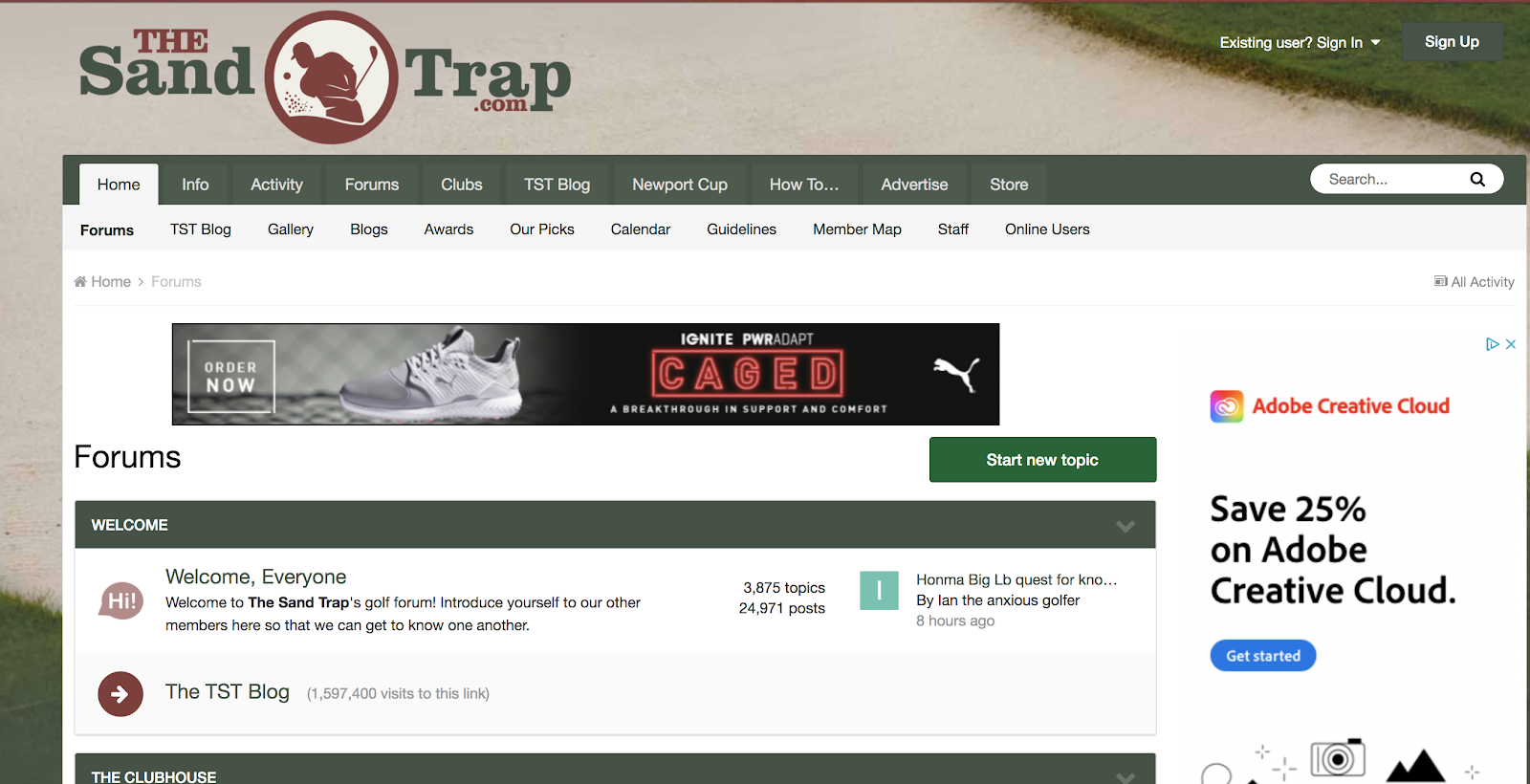
On this discussion forum, you can clearly see the people who contribute to the conversation, which issues are important to them (a form of keyword research) and you can even identify any moderators or regular posters that could be influential in helping to amplify your blog marketing strategies over time.
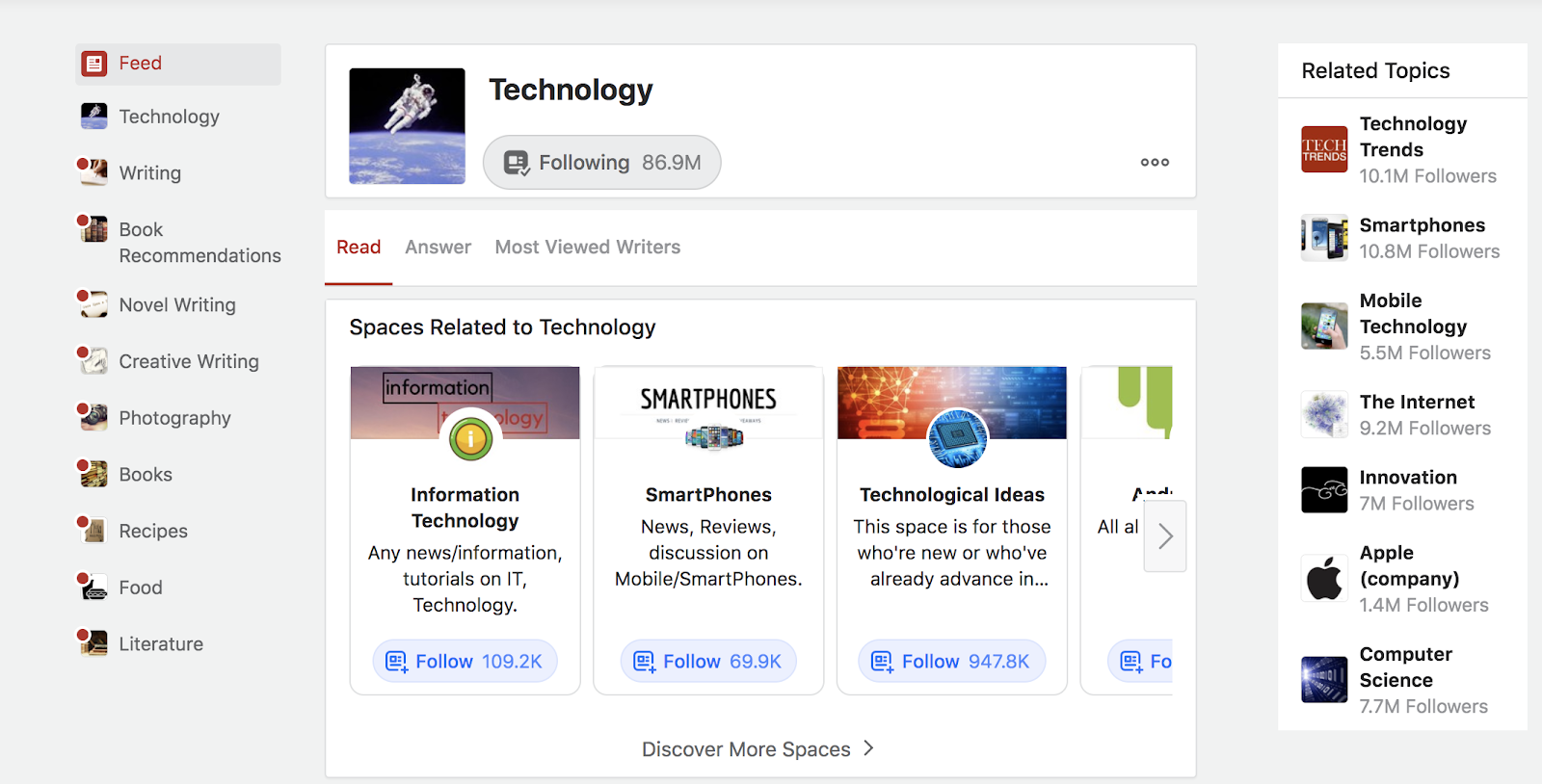
I’ve personally used Quora to find an audience of people who are interested in learning about blogging. Here, I can easily see who (at least some of the members of) my audience are, what their major pain points consist of, and which topics are trending—which have inspired some of my most successful blog post ideas.
Discussion forums like this can also be an opportunity to promote my blog from a branding perspective by simply answering lots of questions over the course of months, thus establishing my authority within my niche. Using these kinds of creative branding strategies, you can accelerate the process of building up your personal brand.
Let’s take a look at a blog marketing example that’s particularly relevant—here was a question on Quora that someone asked not too long ago: “In 2019, is blogging still relevant for SEO?“
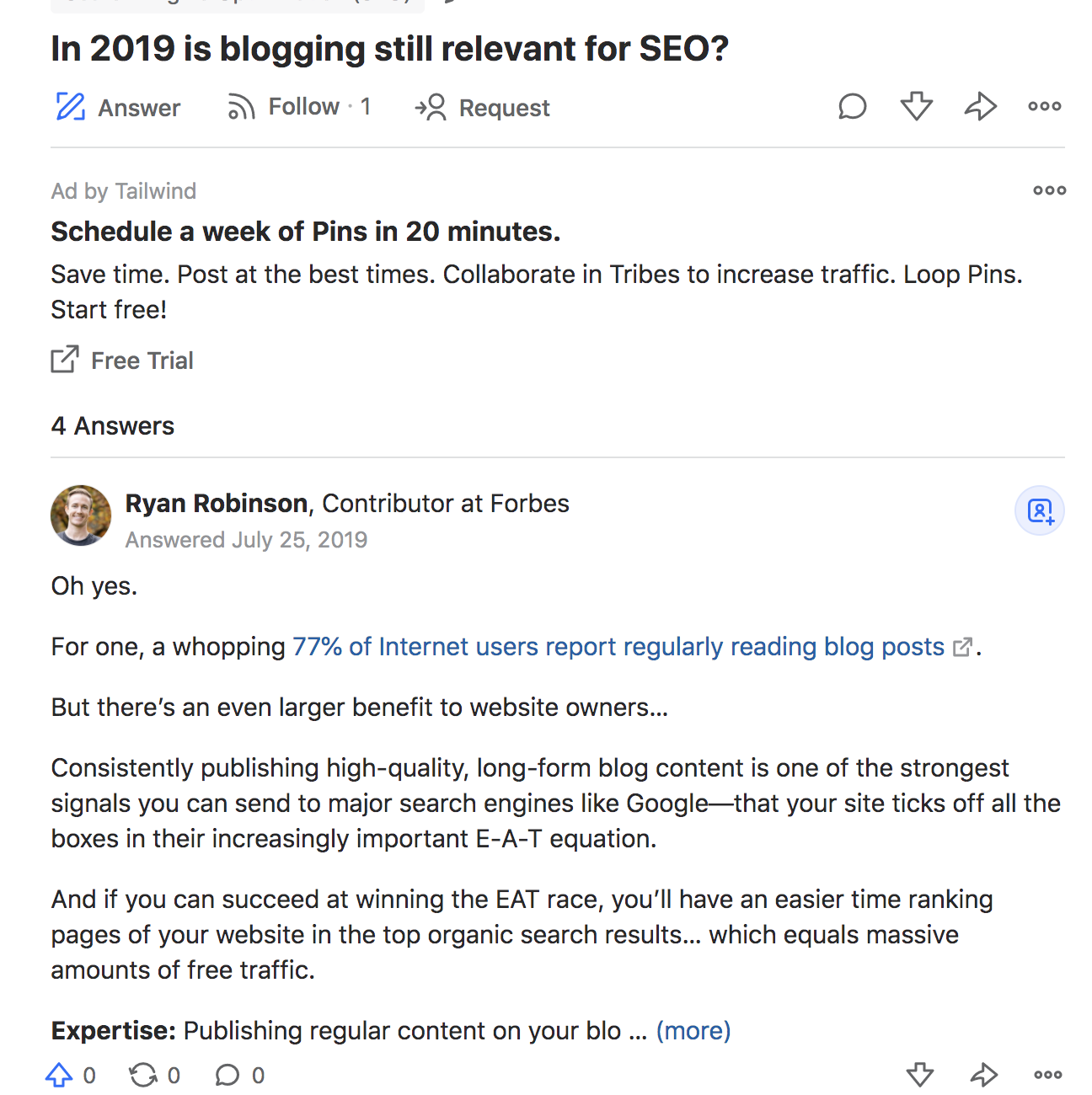
Pulling from my guides about how to start a blog and how to drive traffic to your blog, I was able to easily answer that question with relevant facts, information, and real-life case study examples. I also included a link back to my blog, which ended up driving in s decent number of readers over the coming months.
Browse the Comment Sections of Competitor Blogs, YouTube Channels, and Podcasts
Want to learn more about your target audience? Start by taking a look at where they already spend their time online. Head on over to the comments section of any relevant website or social media channel. There are tons of free insights to glean about who your audience is, what they like (and don’t enjoy), and what kind of content they resonate with most.
You can find these comments on competitor blogs, YouTube channels, and podcasts in your niche—as a starting point.
Here’s an example of just a portion of the comments section from a YouTube video I recorded and embedded within my guide to starting a blog:
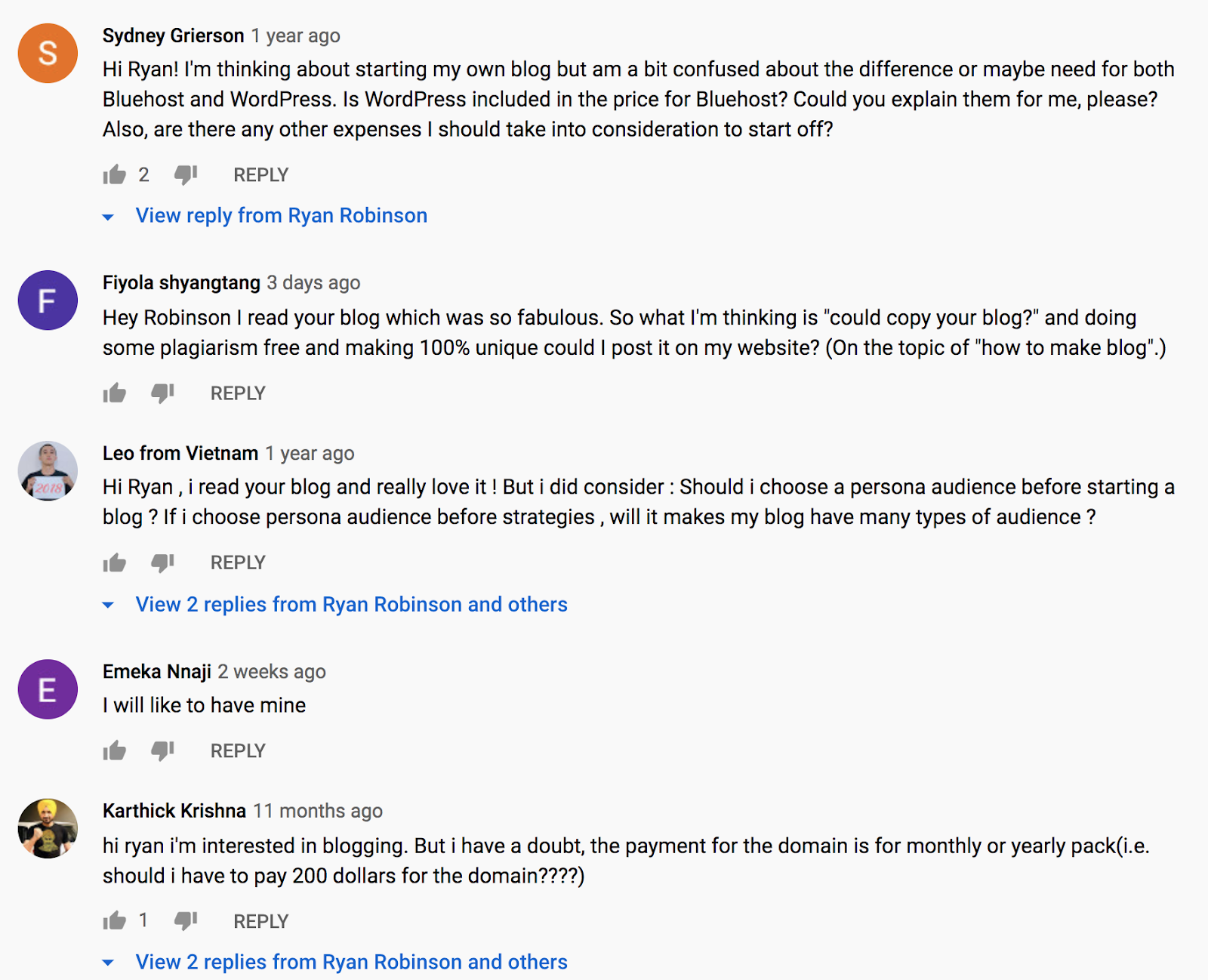
If you were a competitor of mine, from the simple act of reading through this comments section, you can gather a pretty good idea of who is commenting on my videos—and also take note of the questions, statements, and opportunities that stuck out to these viewers about my video.
Here, my audience is asking questions about topics like Bluehost and what WordPress is, inquiring about blog marketing strategies and even granular details of how things like web hosting plans actually work behind the scenes. This gives me a great direction for the type of content my audience might be craving and a good idea for some future blog posts.
Learning (and delivering) what your audience wants is a critical foundation for successfully marketing your blog.
Talk to People in Your Blog Audience (In-Person, on the Phone or via Zoom)
I know, I know… actually talk directly with another human being? You must be insane! 😂

Perhaps one of the most underrated ways of identifying your target audience (and thus strengthening your overall blogging strategy), is meeting up with your readers—or would-be readers—over the phone, via Zoom, or in-person. Bloggers spend a lot of time online, but getting out and meeting people in their industry, is another way of getting to know your audience on a much deeper level than usual.
You can find your target audience in places like conventions, seminars, local hobby groups, meetups and anywhere else people in your niche gather to talk shop. Strike up conversations, network, and find out what really drives them.
Then, you can get home and start translating your insights into actionable blog marketing work by creating content that meets their needs on an intimate level—and you’ll be that much more successful in showing your audience that you really understand them.
For an even deeper dive into this topic, my guide How to Find Your Target Audience covers all of this and quite a lot more (in greater depth) to help you learn as much as you can about the audience you’re hoping to write blog posts for the years to come.
2. Guest Blogging (Become a Guest Blogger on Other Sites)
Guest blogging has been one of the most successful blog marketing strategies I’ve consistently implemented (attracting over 500,000 monthly readers here), so naturally I recommend it to everyone who launches a blog to at least consider—especially since it’s highly impactful for both brand new and experienced bloggers, no matter where you’re at today.

What is guest blogging? From a high level, guest blogging is a form of relationship-building with other bloggers, website,s or publications within your niche. You’ll reach out and pitch them on publishing an article (written by you) that’s relevant to their audience, in which you’ll be able to also link back to your own blog (and thus keep growing your blog’s domain authority). The best part is that it’s a win-win-win blog marketing strategy:
- As the guest blogger, you get a link (or two or three) pointing from the more authoritative site back to your blog
- The publishing blog gets a free high quality article to keep their blog fresh & provide value to their readers
- The reader of the guest post gets a relevant, value-packed article to read and take action on
Since guest blogging is so important in the grand scheme of blog marketing, it deserves an entire section about how to execute this repeatable strategy for marketing your blog. So, we’re going to do a primer on how to start strategically guest blogging—and if you like what you’re reading, check out my ultimate guide to guest blogging that goes even deeper & free, and provides email outreach templates too.
Find the Right Blogs to Guest Post On
Before you can start writing great guest posts, you first have to find another blog, publication, or website that’ll accept your content. You want it to be mutually beneficial to both of you, so you want to be selective about who you write for as well. Here are the criteria I use when I write guest posts for other blogs:
- Pitch someone you already have a connection with (if possible): It’s easiest to write guest posts for people with whom you already have some sort of relationship, even if it’s something as simple as being a familiar face from X or in their blog comments section. Plus, if you’ve already spent some time networking, it’s a good opportunity to help each other out.
- Choose a blog that’s larger than yours (5-10 times the size of your blog): Technically, you can pitch any blog that thinks your blog post ideas are great (and it can help grow your readership & domain authority), but you’ll get the biggest boost from blogs that are larger than yours. Not only will they be able to send more traffic your way, but they’ll also give you more help with ranking your content in organic search results on Google—which is the primary long-term goal of guest blogging.
- Guest blog for sites in your niche (or related to your niche): Yes, you can always do a guest post for people who aren’t exactly in your niche, but you won’t be engaging with your target audience. It won’t be as beneficial for you or your host blog to go this route, and search engines like Google also won’t typically reward those links as much as a quality link from a more relevant site.
- Find a blog with a similar style to yours: If you choose a blog that matches your own content style, you won’t have to work so hard to write something that’ll appeal to their audience (and your editor). As an added bonus, you’ll more effectively connect with those readers, as they’re more likely to be engaged with someone similar to who they’re already reading from.
- Write guest posts for blogs that offer a follow link: Occasionally when you write a guest post for someone, they won’t allow you to add a follow link to your blog, which takes away some of the SEO benefits (to your blog marketing efforts) of writing that article in the first place. For that reason, I tend to avoid guest posting on sites that don’t allow a link or two within my articles. More on how to identify link types here.
Some sites may offer you a nofollow link, which is a link that essentially tells search engines to ignore it. While you’re still getting some exposure by writing for a higher authority blog, it doesn’t make a lot of sense to write for someone who doesn’t allow you to include a follow link or two, since your blog marketing goal is to build up your own site’s domain authority (with quality links from other sites) over the long-term. Don’t forget that it helps a lot if your blog’s name is related to your niche—use my domain name generator to get great domain ideas today.
Create a Great Pitch For Your Target Guest Blog
After coming up with a list of places that you’d like to write for, the next step is to introduce yourself (if you don’t already know them) and show them what you can offer by writing for their blog.
To learn more about how I personally do blogger outreach (including the exact outreach email templates I use and how to identify the email address of the person you want to reach), head over to my guide on blogger outreach, but let’s run through the highlights for sending out a pitch for a guest blogging opportunity. Here’s one of those email templates, for example:
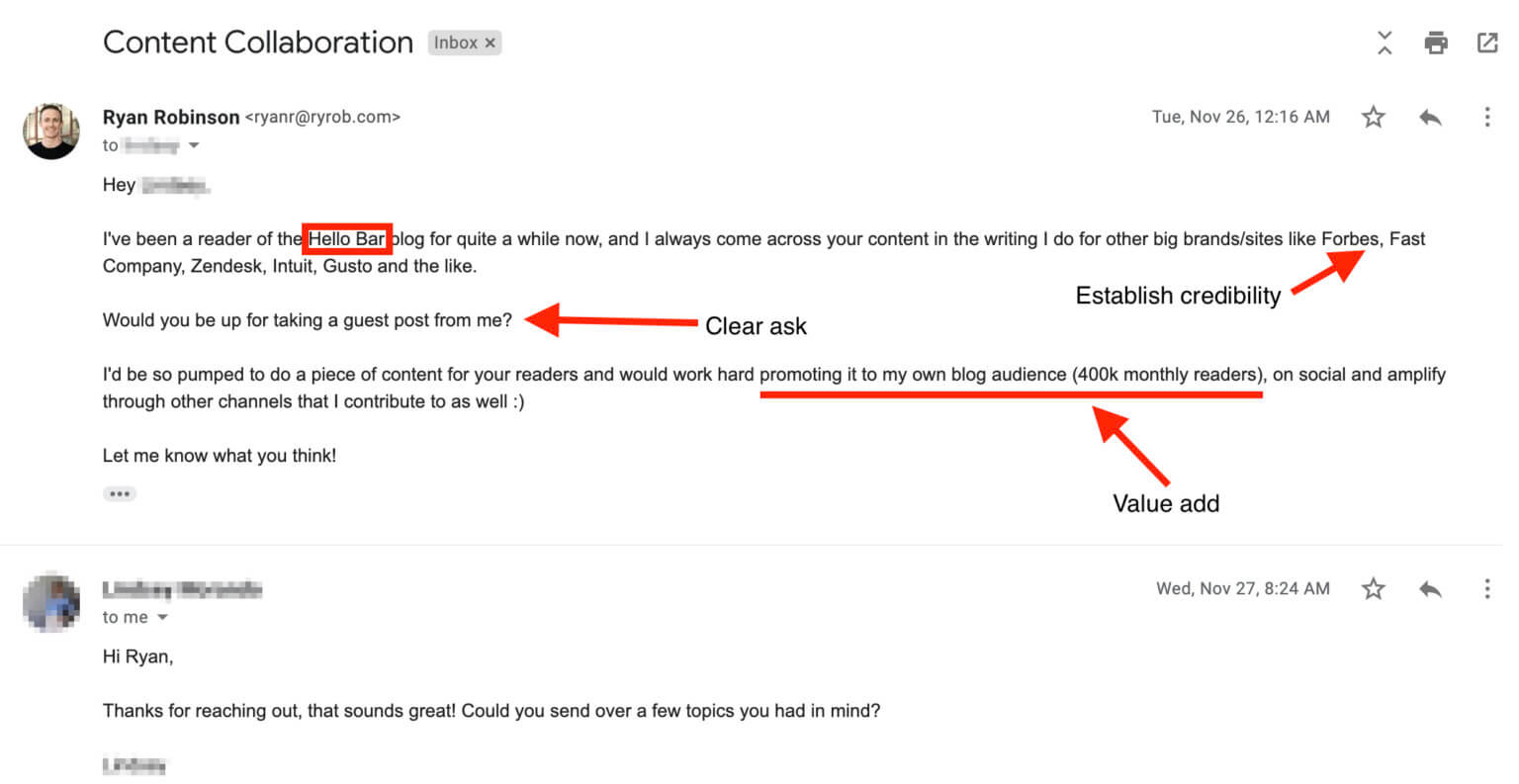
Here are the three principles I use to effectively pitch guest posts as a scalable blog marketing strategy:
- Keep it simple: Don’t overly complicate your pitch email. Their time is limited, so let them know in as few words as possible why you’d be a good choice to write a guest post for their blog.
- Show that you understand their blog: Tell them what you like about their blog, and consider mentioning a few posts you’ve liked of theirs (this shows that you are actually familiar with their content).
- Give guest post ideas they’ll like: After researching their blog, try to think of topics you’re familiar with, that they haven’t already covered on their blog. Give 2-4 good ideas that they might grab on to.
Don’t be afraid to follow up if you don’t hear back from your recipient within a few days. After your pitch is accepted, that’s when the real fun begins.
Write a Guest Post You’re Proud Of (and They’ll Love)
When you do land a guest blogging opportunity, take your time to write something that matches their style. Write in a way that fits well into their blog, but is also something that you’re proud to have your name on.
Your guest post is an introduction to you and your content, so it’s worth putting in the effort. From my perspective, I’d also recommend not worrying about writing super long-form articles for a guest post (unless it’s for a high-profile publication and it was requested), but it’s important to write quality content that represents you well.
Promote Your Guest Post (Meta Blog Marketing)
Once your guest post gets published, you have a great opportunity to show your own worth to the blogger who took a chance in hosting your content. Go out of your way to promote your blog post by sharing it on social media, sending an email to your subscribers and reaching out to anyone you’ve mentioned in the article to ask for a share.
Your host blog will appreciate the extra visibility, social buzz and traffic—plus, it’ll only add more authority to your blog (especially if your host blog has a more significant following than you do).
Putting in the extra legwork to promote your guest posts will also open the door to asking your host blogger if they’re comfortable introducing you to another blogger or two in your niche that might also be interested in taking a guest post from you, especially if you’re able to demonstrate some blog marketing chops of your own already.
3. Use SEO (Search Engine Optimization) in Your Blog Marketing
SEO (Search Engine Optimization) is something you’ll hear again and again as a blogger. That’s because ranking your content high in the results on major search engines like Google can be the single difference between a few people finding your blog and literally millions of people finding your content. I know this first hand.
If you can find the right keyword phrases and rank on the first page of Google search results for them, you’re almost guaranteed to see a meaningful amount of organic traffic to your blog on a daily basis.
Use My Free Keyword Research Tool

Try my free AI-Powered Keyword Tool to get dozens of research-backed ideas for keywords & topics to write about on your blog today.
Since I’ve already written a great deal about keyword research and implementing effective blog SEO strategies here on my blog, this’ll be a slightly abbreviated version. Check out those two guides for a more in-depth tutorial on how I’ve grown my audience to over 500,000 monthly readers.
How to Rank Your Blog Posts in Google Search Results
Today, Google is the top search engine that you want to prioritize ranking your content on. Not only is Google the most used search engine in the world, but it’s also the most visited website on the internet. Although other search engines can undoubtedly drive traffic to your blog, Google currently holds and estimated 81.95% of the market share amongst search engines. Crazy, I know.
And while I’ll be the first to tell you that Google’s algorithms change frequently, some factors remain constant in terms of top-ranking content:
- Write high quality content that’s original and provides more value to searchers than your competition
- Write about specific topics that people (especially your target audience) want to read and learn about
- Use keyword research to choose your target keywords and topics carefully (you can check the effectiveness of this through a curl proxy)
How to Write Better Content (That People Want to Read)
When you write a blog post with the goal of outranking your competition in Google search results, there are some essential key ingredients you’ll need to follow. These qualities will help you rank higher in a Google search and give your readers the kind of content they want.
- Deep dive research: A lot of the content you read on the Internet is either fluff without much substance, or half-copied and outdated articles that keep getting recycled for years. The reason for this, is that it’s a lot easier to write five easy tips that require next to no research, than it is to write something more substantial, unique and value-driven. One thing that sets quality writing apart from sub-par Internet writing, is better research. Double-check your facts, learn from multiple sources, poll your readers for the topics they care about and use first-hand experience whenever possible.
- Go more in-depth: If your competition gives 1,000 words about your keyword phrase, try challenging yourself to write 2-3 times that amount on the same topic. Don’t fill your page with useless information, but strive to give readers more actionable advice, better research and a higher level of detail that’ll be most helpful to them.
- Don’t keyword stuff: Google is constantly trying to determine how to properly index your page (and decide where to rank it). They do that in part, by picking up on the number of relevant keyword phrases in your article (like this piece of mine, which targets phrases like how to market your blog and blog marketing). However, it’s not a good practice to overly stuff your content with keywords to the point that it detracts from your message. Google is getting better and better at picking up on this practice, and will consider it a spammy tactic—leading to what’s likely to be a lower search ranking.
- Write better headlines than the competition: If you can write more click-worthy blog headlines than your competition, then it’ll lead to higher SEO rankings and more clicks from searchers. Remember to include your main target keywords within your headline, and to write captivating headlines that draw readers in and encourage them to click through to read more.
How to Do Smart Keyword Research for Your Blog Marketing Efforts
As you’re thinking about which topics you want to write about on your blog, you should always include keyword research as part of your strategy to make sure you’re creating content on subjects people actually want to read about.
Put simply, keyword research can (1) give you ideas as to what you should consider writing about, (2) validate that a particular topic you’re considering does indeed have enough search activity and (3) it’ll also help you use the exact right words or phrases for topics you’ve already chosen, so that your potential readers will recognize your content as what they’re looking for.
For instance, let’s say I have a blog about sleep. I’ve chosen the topic “how to fall asleep more easily” for a blog post. I know what I want to write about, but is it something that people search for? Do people search for the phrase “how to fall asleep,” or do they use other words that mean something similar?
Using a free tool like my own free keyword tool, Google’s keyword planner or Twinword Ideas—or even more premium offerings like Ahrefs or SEMrush—can help you decide which phrases will work best for your topic.
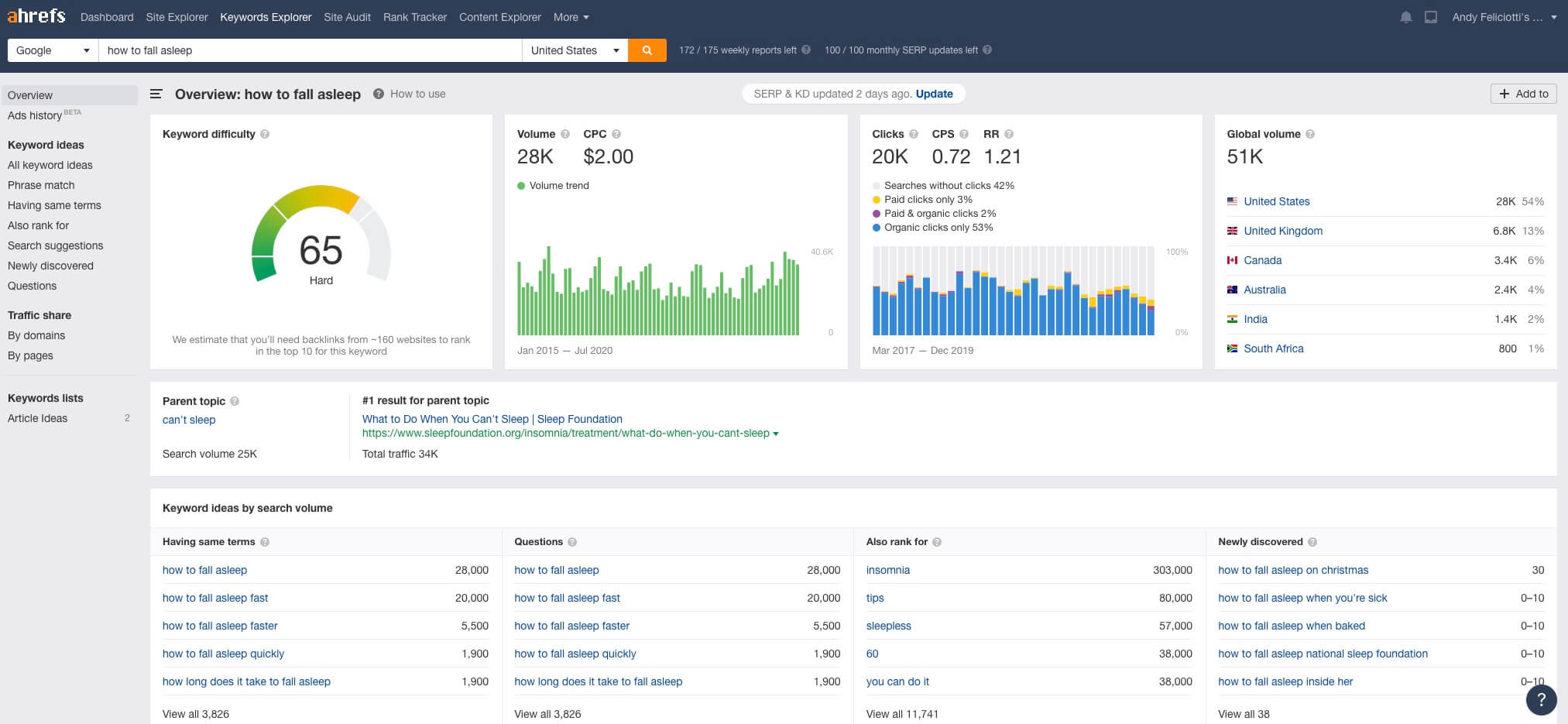
Here are a few more helpful tips about doing effective keyword research to make sure your blog marketing efforts stay on track:
- Target high-volume, low competition keyword phrases whenever possible: The best options (especially for new bloggers) for keyword phrases to pursue are ones that are somewhat widely searched but have relatively low competition. If you can find a topic that people want to know about that comparatively few well-established sites have written extensively about, then you’ve found what might be the perfect subject matter for a blog post. These opportunities aren’t easy to find, so settling for medium-volume and medium to low competition keyword phrases like “how to build a personal fitness app” could be as good as it gets if you’re in a highly competitive niche like “software development“.
- Use medium and long-tail keywords: At this point in the life of the Internet, it’s tough to rank for a single keyword (and often not very useful anymore, either). During the early years of the Internet and Google, you may have been able to rank #1 for a single word like blog or furniture or parenting. Today, there are far too many huge websites and great blog posts to easily rank for a single word. Instead, try to rank for a more specific keyword phrase (sometimes referred to as a medium or long-tail keyword). It’s easier to rank for longer terms, and it helps direct people to the exact answers they’re searching for. I may not rank first page for the word blog (at least today), but I rank well for terms like: how to name a blog, how to start a blog, how to pick a blog niche, blogging tools and many more relevant phrases in my niche that deliver substantial amounts of relevant readers when all combined together.
- Think about season and region: Search volume for a given keyword phrase is rarely constant. Some keywords become popular for a time, only to phase out later in the year. The same line of thought can be used for regions around the world. What’s popular in December may not be popular in March, and what’s well searched for in California may not be that interesting to people living in Oklahoma. To better research these differences, you can use a free tool like Google Trends. Google Trends does more than just show you the average monthly viewers, it tells you what, where and when certain words or phrases actually spike. People who blog about gardening, for instance, will likely see a larger search volume during the spring and summer (when more people are gardening and looking for relevant advice):
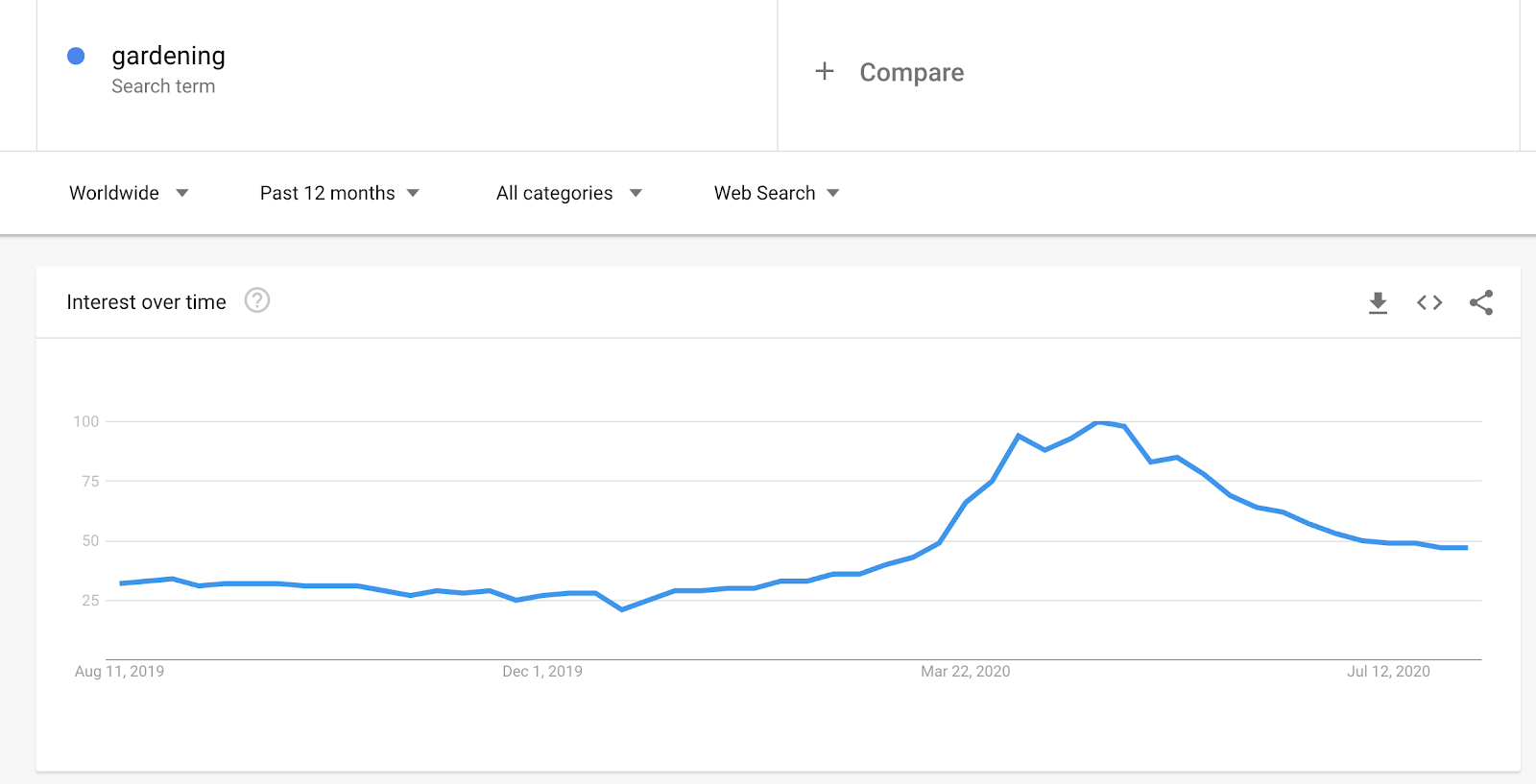
Just like the term “US constitution” is most likely to be searched by people who live in the United States:
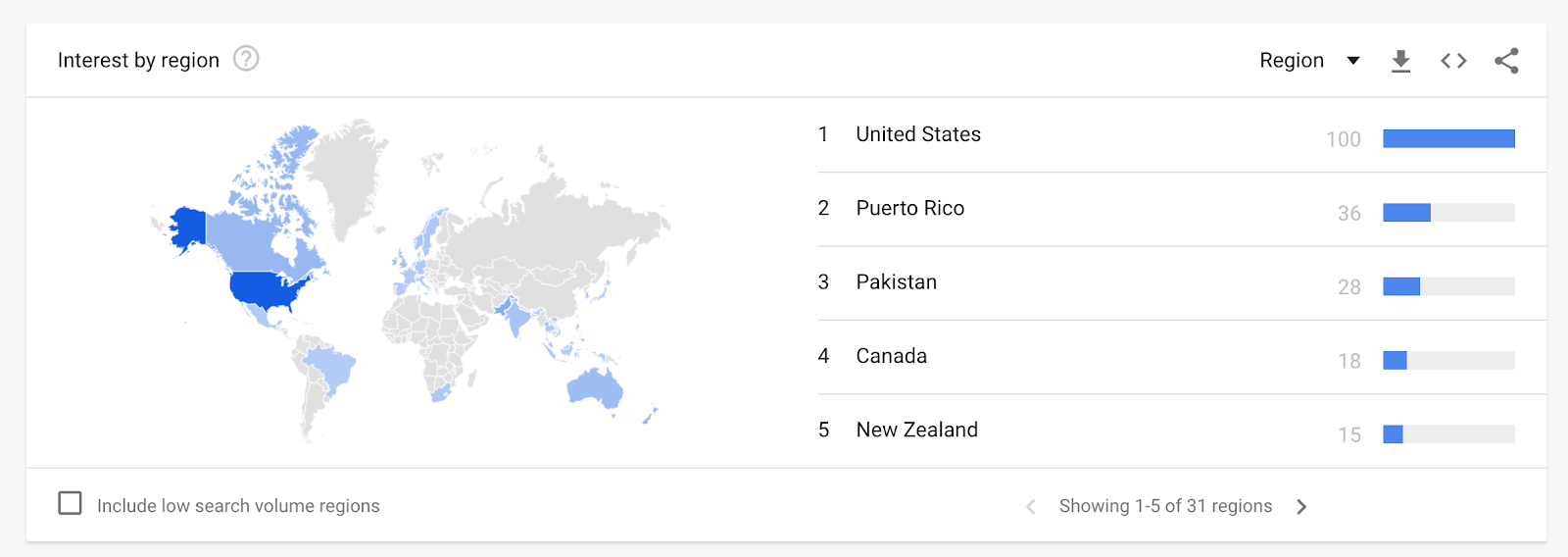
After you’ve collected a selection of keyword phrases that you’d like to write about, you can compile them into a blog planner (or editorial calendar) to schedule when to write about them and post your new SEO-friendly content.
For more on the exact best practices you should follow when writing content for your blog, read my guide to on-page SEO best practices and implement the strategies I cover there.
4. Leverage Social Media for Your Blog Marketing
Before we get into each social media platform (which we soon will), I want to start by making it ultra clear that I don’t expect you to try and implement these blog marketing strategies on every social media site. In fact, you shouldn’t.

Growing a social media presence takes a lot of time and effort—thus you should start by only choosing the top one or two platforms where your target audience spends the most time, and feels like the best opportunity to leverage your unique skills, strengths & experiences to make as much of a splash as you can.
Blogs that are already image-heavy like fashion, cuisine, or travel often do very well on Instagram. Blogs that focus on tech, finance, and business may perform best on LinkedIn. Those marketing their blog to younger generations may want to learn how to use Snapchat, TikTok or use more Instagram Reels or YouTube shorts.
Knowing which social media platform will work best for your blog goes back to knowing your audience. Where does your audience spend their time online, and how can you get eyes on your content there?
Keep in mind that none of the methods I’m sharing is a silver bullet. With today’s social media algorithms, marketing requires a great deal more work than it did in the early days.
It is possible to achieve success with social media, but it takes smart practices and hard work. In this section, I’ll give a break down of the easiest ways to drive the most traffic from each social media platform.
How to Market Your Blog on Facebook

Facebook has been around since 2004 and currently has 3 billion active users. Familiarity with Facebook and the high volume of users makes it a common marketing resource for businesses and bloggers alike.
The only problem from a marketing perspective is that over the years, people have become tired of being targeted on Facebook. They get on Facebook to see what their friends and family are up to, but aren’t as interested in marketing links and posts.
In response, Facebook has changed its algorithm to show posts from family and friends and less from brands and businesses. Here’s a quote from Mark Zuckerberg about the changes in 2018, “We built Facebook to help people stay connected and bring us closer together with the people that matter to us. That’s why we’ve always put friends and family at the core of the experience. Research shows that strengthening our relationships improves our well-being and happiness.”
Don’t freak out—this doesn’t mean that Facebook is hopeless for marketing your blog. It may still be that there are lots of Facebook users who’d be interested in your blog content. The trick is connecting with the right people on Facebook, and doing it more (today) from your personal account rather than a less personal Facebook page for yourself.
The 3 billion users on Facebook are enticing, but you’re not competing to get the attention of all of the users in your blog marketing efforts. Your blog won’t pique the interest of all of Facebook’s users and even more challenging (perhaps) is showing up on all of their news feeds. So what are some of the best methods for reaching an engaged audience on Facebook? This isn’t an extensive list of all the ways to market your blog on Facebook, but it’ll give you a clear direction to get started.
Use Facebook Lead Magnets to Market Your Blog
One way to really nail your blog marketing on Facebook, is to offer something to your audience in return for their time. A lead magnet is one great way to do this.
What’s a Facebook lead magnet? Many popular bloggers use a lead magnet to turn their readers into email subscribers. A lead magnet is when you give away something free to get something non-monetary in return from your new subscribers (like their name and email address to use in your further blog marketing work). Common examples of lead magnets include:
- Checklists
- Cheatsheets
- Recipes
- eBooks
- Calendars
- Planners
- Free courses
- Printables
- Spreadsheet
- Tutorials
- Guides
The idea of a lead magnet can also be used for collecting email subscribers from Facebook. Although this may not drive traffic directly to your blog, a list of email subscribers is highly beneficial to your blog marketing efforts (we’ll explore email marketing more thoroughly later on in this article).
Limit Promotional Posts in Your Facebook-Focused Blog Marketing
In order to grow your audience on Facebook, it’s important to limit the amount of promotional material you post. If you write a new blog post you should definitely let your Facebook followers know about it, but it shouldn’t be the only time they hear from you.
Other types of content you can share on Facebook to grow followers and encourage engagement are:
- Images
- Videos
- GIFs
- Polls
- Personal life updates (if relevant to your blog)
- Statistics
- Quotes
- Memes
These types of posts give people a reason to engage with your posts and a personal view into you (and your brand).
Appeal to Your Target Audience (Not Everyone on Facebook)
As I’ve said before, your goal is not to connect with everyone who uses Facebook. Your goal is to connect with the people who are most likely to enjoy and engage with your content.
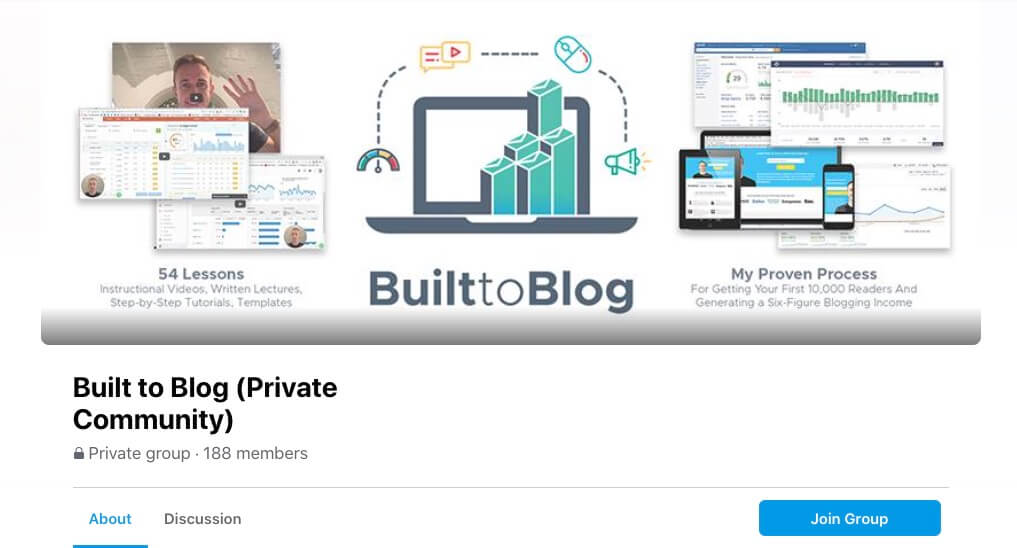
That means when you create Facebook posts or publish an update in a Facebook group you’re in, imagine what might help your target audience the most. What would they find entertaining, interesting, or useful? You don’t have to manage the needs of the whole world—just your target audience.
Avoid Clickbait Links on Facebook
Another thing that Facebook has tried to crack down on is clickbait links. This again is to create a better user experience. In 2014, they released an article explaining exactly what they mean by clickbait:
“Click-baiting” is when a publisher posts a link with a headline that encourages people to click to see more, without telling them much information about what they will see. Posts like these tend to get a lot of clicks, which means that these posts get shown to more people, and get shown higher up in News Feed.”
Avoiding a clickbait-style of writing is all-around good advice for bloggers. You don’t just want people to click on your links, you also want them to feel like you’ve answered their questions and provided something of value. If they click on your link only to realize that your post is poorly written or misleading they’re not going to go back to your site.
In the case of clickbait-style writing on Facebook, you also risk losing visibility. If your posts seem like clickbait they will severely limit your impressions.
Facebook decides what is clickbait by a couple of factors:
- How long people read spend reading an article linked on Facebook: If people spend some time on the article, Facebook believes this suggests that they have found some value in it. If they quickly hit the back button to Facebook, there’s a good chance it didn’t deliver.
- Facebook analyzes what kind of engagement it receives: One way for Facebook to determine which content should get higher reach is how many clicks a link gets. Since people do click on clickbait, Facebook decided that likes, shares, and comments are often a better indicator of value.
Facebook explains, “If a lot of people click on the link, but relatively few people click Like, or comment on the story when they return to Facebook, this also suggests that people didn’t click through to something that was valuable to them.”
So how do you avoid creating click-bait posts on Facebook? Let’s examine a few click-bait style headlines to see what is potentially misleading or vague about them:
- You Won’t Believe What This Actress Did on Her Vacation!
- 5 Shocking Ways Lose Weight FAST
- This Man’s Story is So Horrifying His Family Doesn’t Know About It
- This Outrageous Food Trend Could Save Your Life
Ok, so apart from instantly sounding like spam, another collective theme about these headlines is they’re missing important information. In the first example, what actress are we even talking about? In the second example, there’s a good chance that the ways to lose weight won’t be shocking at all or even different than ordinary weight-loss strategies.
People know that once they click on the link there’s a high chance that the article will be useless. It won’t fulfill their needs or wants. Effective blog headlines deliver on their promises. They tell people what they’re going to get when they click, and then they follow through with valuable content.
Join Facebook Groups in Your Blog’s Niche
Another way to market your blog on Facebook is to join Facebook groups in your niche. The best part of doing this is you are connecting with people who are already interested in your blog’s topic. You don’t have to sift through the entire Facebook population to find people who like what you like. Here’s a screenshot of my Facebook Group for members in my course, Built to Blog:
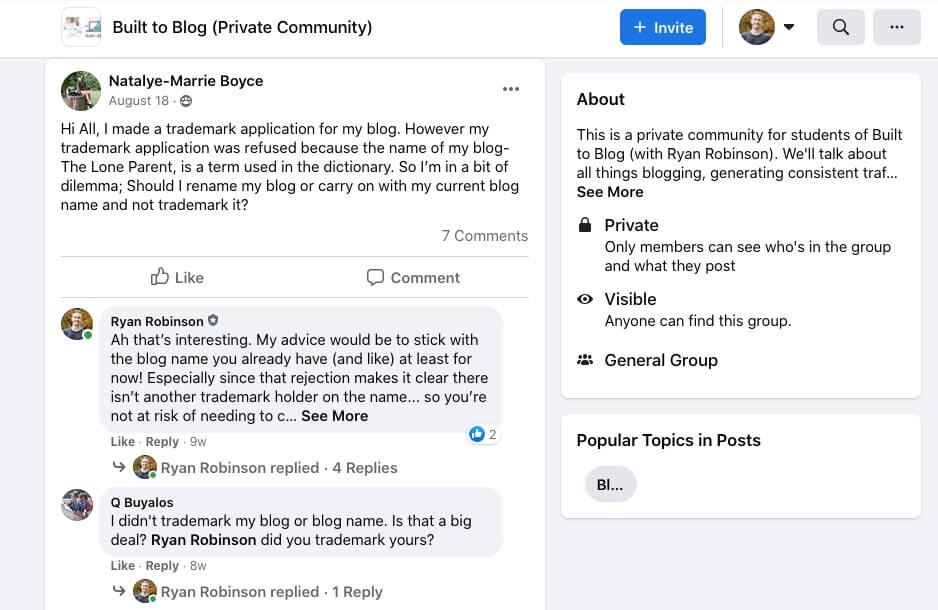
You do have to be careful with sharing your content on Facebook groups, however. I would never join a Facebook group and immediately start dropping links to my blog. That would come across as spammy and probably will get me banned. It’s better to join a group that you personally are interested in and engage in normal post conversations before posting any links.
Another thing to keep in mind is some Facebook groups specifically prohibit promotional posts of any kind. Read the fine print before you try to link to your blog because they may become annoyed with you or drop you from the group, which kind of defeats the purpose of your blog marketing efforts on Facebook—so be aware before you promote.
If you don’t want to join someone else’s group, you also have the option of starting your own Facebook group related to your blog and your niche (like I’ve done).
A lot of people have successfully grown a following on Facebook where they can market their blog and bring like-minded people together. This can be a valuable resource to people in your niche and generally lead to higher engagement.
How to Market Your Blog on X
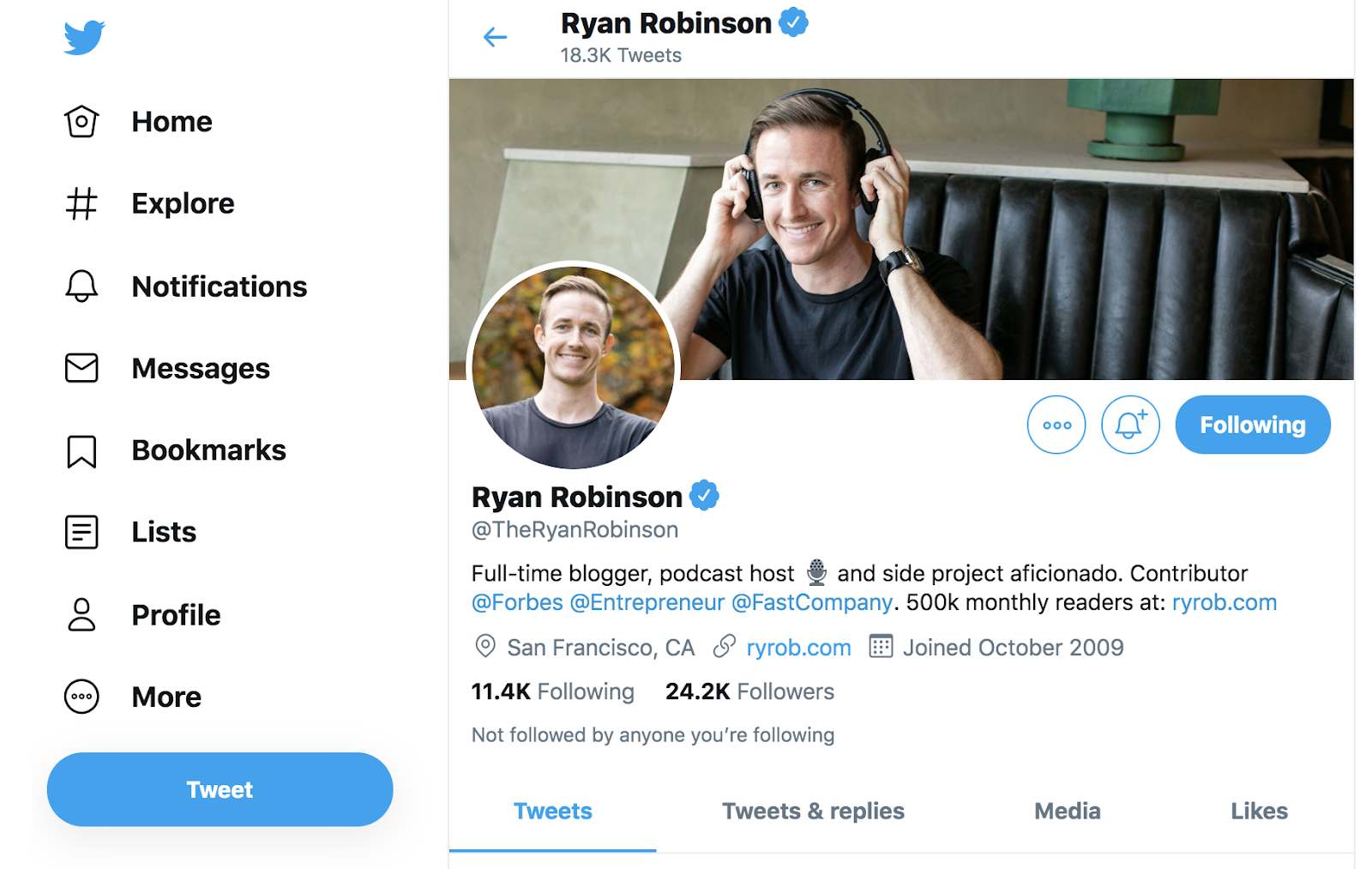
The micro-blogging social media platform, Twitter, now, X, has been around since 2007. Compared to Facebook, it has far fewer users—around 353 million monthly active users. Despite having fewer users, however, X still attracts a large crowd and unique blog marketing opportunities. So how do bloggers take advantage of the built-in audience on X and market their blogs?
Many of the same concepts we’ve talked about for Facebook will work for all of the social media apps. This includes broadly applicable themes like:
- Getting your content directly in front of your target audience
- Limiting promotional posts (not everything you post should be a link to your blog)
- Avoiding spam/clickbait-style content that might get you low impressions or even banned
X is one of my favorite platforms for marketing my own blog content, networking within my niche and keeping up with other influencers in the blogging world. Let’s dive into some of the ways I use X as a part of my blog marketing strategy.
Be Mindful of X’s Spam and Automation Policies
Over the years, X has been under scrutiny since the 2016 United States presidential election for bots linked to Russian interference. In an effort to cut down on fake accounts and election meddling as well as general spam, X has been continually updating their spam policies. Some of the main takeaways of their policy include:
- No fake accounts: X prohibits the use of fake accounts use for spam, abuse, or disruptive behavior. They seek out these accounts be looking for copied bios, stock or stolen photos and/or any personal information from the Internet, or intentionally misleading profile information.
- Be careful about automation rules: X has quite a few automation rules which I recommend checking out for yourself, but a few important things to know: Don’t automat trending topics on X or attempt to influence or manipulate trending topics with automation. Don’t post multiple duplicate posts across one or multiple accounts you operate.
- Avoid artificially inflating your engagement: It’s prohibited to purchase followers or engagement on X. It’s also against their policy to engage in “reciprocal inflation” by coordinating follow or engagement exchanges.
- Misuse of X product features: it’s against X policy to send “bulk, aggressive, high-volume unsolicited replies, mentions or Direct Responses.”
Start Meaningful Tweet Threads (Threaded Conversations)
Something that’s super underrated on X right now is meaningful threaded conversations that break down a complex idea or analysis over the course of many tweets into a single thread.
The most successful threaded conversations are not super self-promotional—which means that people are able to get value from the thread, without feeling like they have to buy something. My friend and recent podcast guest, Ross Simmonds, had a series of great tweets about how effective Masterclass is at marketing, which went pretty viral. Here’s a screenshot of the first tweet in his thread, which you can see in its entirety as a great blog marketing example on X right here:
While this thread goes on with several more insightful tweets from Ross, you can see by the response that people really liked the content that Ross was sharing here.
One person responded, “Definitely using emotion and honesty to pull in the audience (content marketing is definitely psychology 101) which makes it authentic. It’s a brand that doesn’t feel like a brand at all.” This is getting a bit meta for a moment—but that kind of blog marketing acumen is exactly what you want from your own social media experience.
You want people engaged with your content because you’re providing something authentic, real, and valuable. These types of threaded conversations are an opportunity to provide just that.
Effectively Using Hashtags on X
X hashtags are a movement within themselves. They were the original social media hashtag users before other social media platforms like Instagram, Facebook, and Pinterest jumped on board.
But the use of hashtags for marketing is an art and takes time to perfect. I’ll share some tips here to help your hashtag game remain strong:
- Don’t spam people with X hashtags: When X posts have too many hashtags they look like spam. In fact, while Tweets with hashtags get more engagement than those that don’t, Tweets with more than two hashtags actually see a decrease in engagement. X recommends using no more than two hashtags per post.
- Create unique hashtags for your blog: You can create a hashtag for your blog to be easily found and followed on X by your target audience.
- Use hashtags for special occasions or campaigns: If you have a specific event or giveaway on X you can create a new hashtag so people can follow that event. It’s also beneficial to use hashtags of trending special occasions.
NASA used the hashtag #LaunchAmerica for the recent space launch carrying astronauts. They did this to bring awareness of the event and build a community of people anticipating the launch.

Find hashtags that are used frequently by big influencers in your niche to maximize your blog marketing impact. If you don’t know which hashtags will give you the most reach, try using hashtags that industry influencers are regularly using, as this kind of relationship building can also soon translate into more collaboration opportunities.
Create an X List to Market Your Blog
An X List is a curated group of X accounts that shows you a stream of Tweets from those accounts only. I wouldn’t call an X List essential to your blog marketing plan, but there are some useful things that they can provide. X Lists can be used to market your blog in a few helpful ways.
- Create a list of competitors and influencers in your niche: Doing this will help you have a good idea of how your competitors are marketing their content and a good indication of what is trending in your niche.
- Create a list including thought leaders in your niche: These are the people who are innovative and forward-thinking. It may mean your competition, but it could also mean groups, businesses, innovators, influencers, and more.
For example, if I were to make a list of bloggers and relevant accounts that tweet about blogging, I may want to include the WordPress X account, so I can keep up to date about what they’re doing in the greater WordPress community.
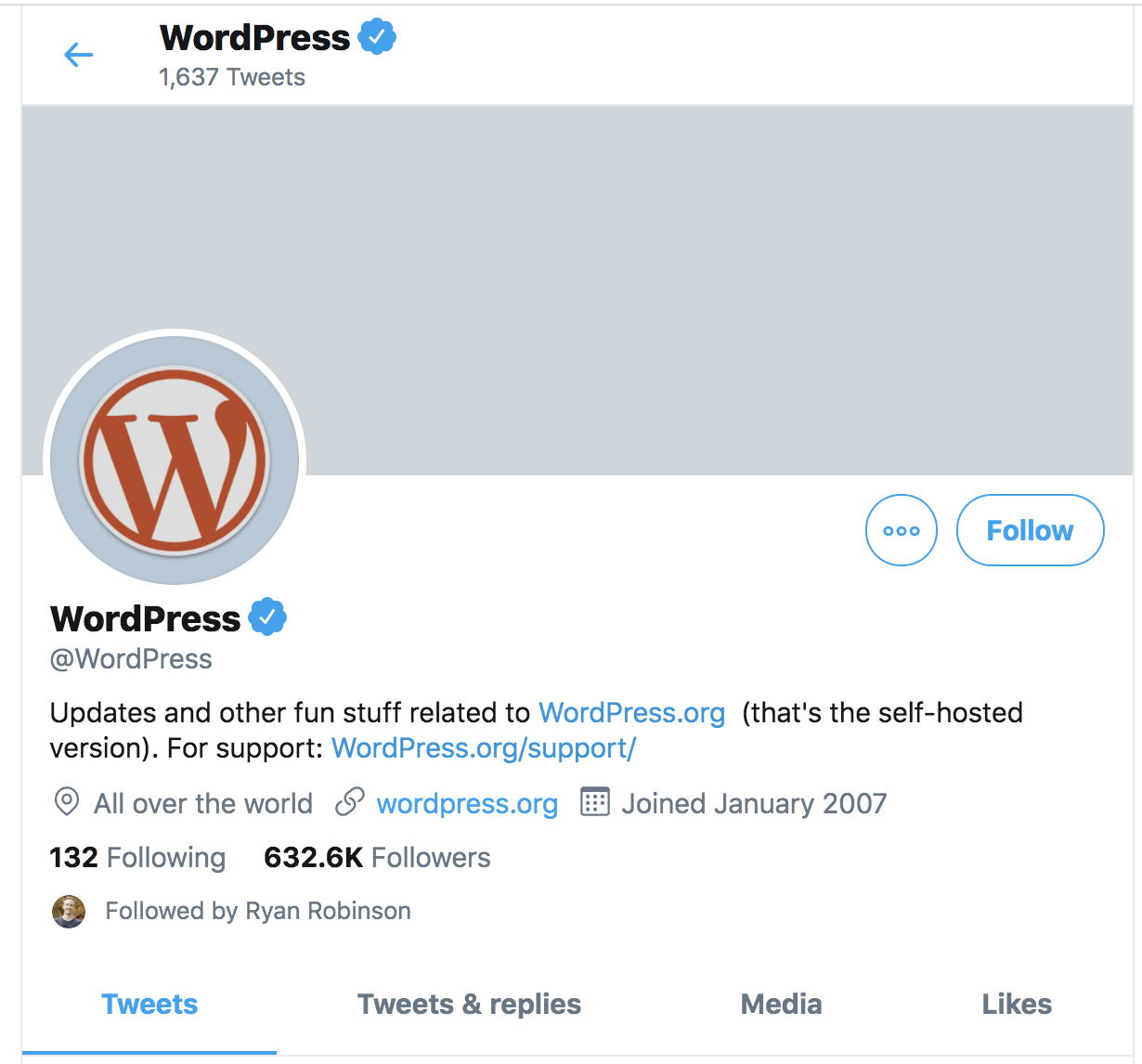
I may also follow Tech Crunch on X for updates about technology that’s related to blogging.
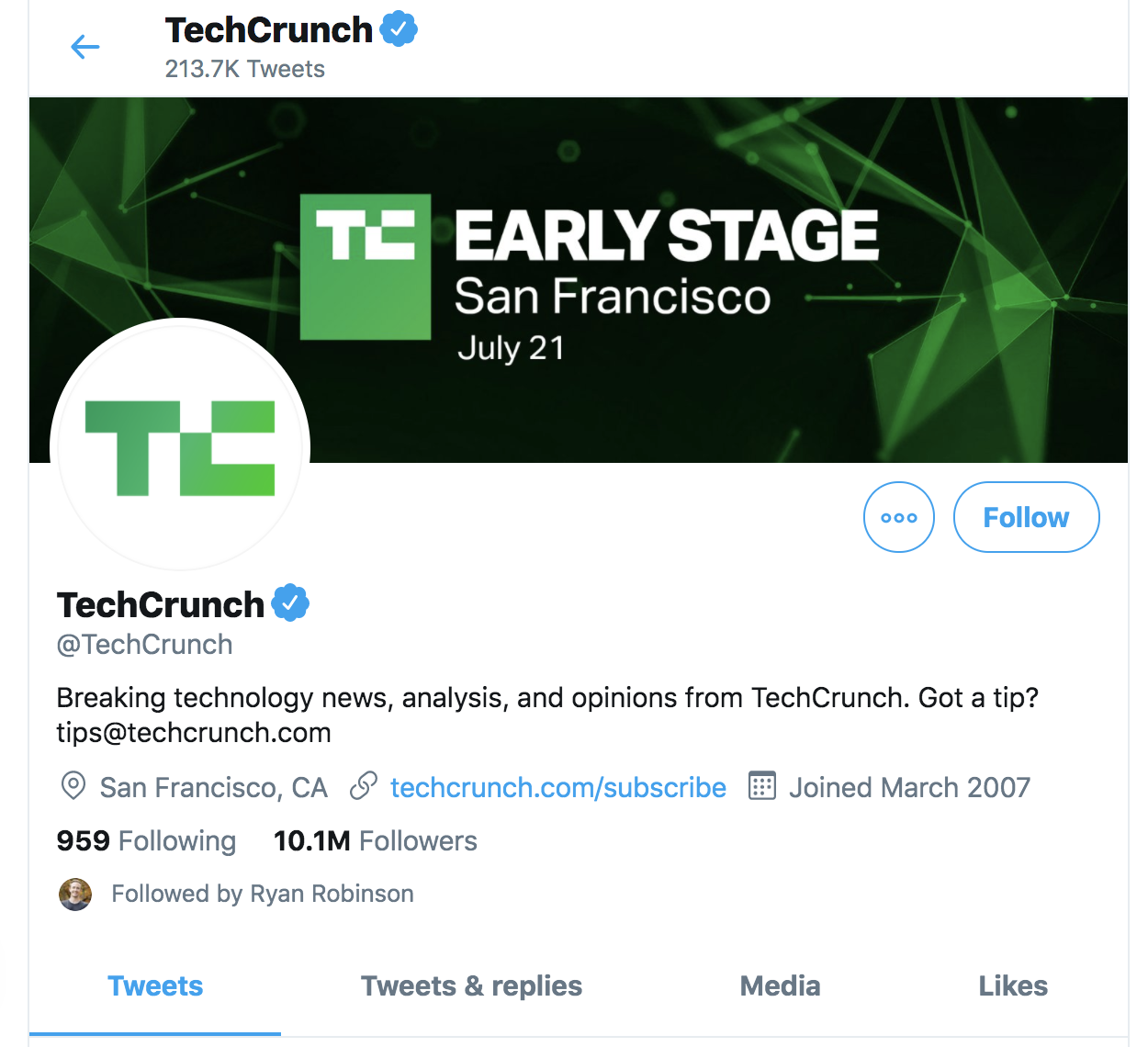
X Lists give you an easy way to engage with the people who are most connected to your niche, which can also serve as a priority list of people or publications to build longer-term relationships with for greater blog marketing campaigns over time.
How to Market Your Blog on Pinterest
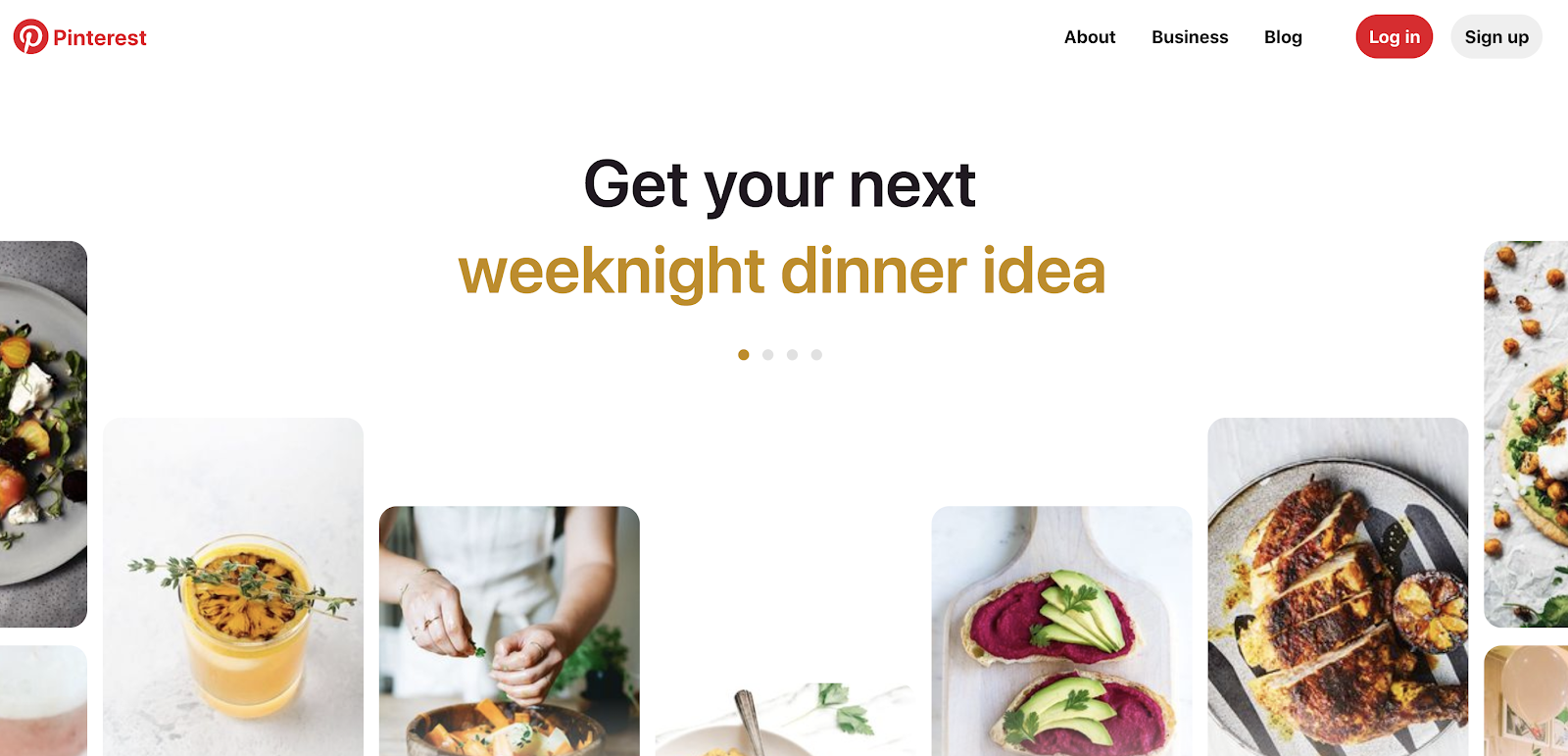
Pinterest launched in January of 2010 and grew so popular that Time magazine included Pinterest in a list of 50 best websites in 2010. As of 2025, Pinterest is anticipating over 530 million monthly users (which is more than X).
I suggest picking the social media platforms that best suit your niche, but you may be surprised at how accommodating Pinterest can be to a wide variety of industries. Pinterest has a reputation for being the place where you go to find a baking soda cleaning solution, pick out a recipe, or find a craft for your kids. Pinterest is certainly a source of inspiration for many of these areas of interest, but it can be a beneficial resource for non-domestic style blogs as well.
So what makes Pinterest uniquely helpful for bloggers? This may not be the primary reason you use Pinterest to market your blog, but it is worth noting that Pinterest polled their users and found that 90% of users described Pinterest as “filled with positivity.” Social media can be a place of arguments and discord these days, so many people may use Pinterest to escape these disputes.
One of the most compelling reasons to use Pinterest is the lifespan of a Pinterest social media post. For reference, the average lifespan of an organic Facebook post in 2021 was 5-6 hours. An Instagram post may continue gaining engagement if marketed properly, but many will lose reach within the first 24 to 48 hours. Tweets have a lifespan of around 15-20 minutes.
A pin, on the other hand, has a lifespan of 3 months and can continue getting engagement for up to a year after pinning. That’s a HUGE difference when it comes to marketing your blog, and it requires a less work than other social media platforms, too. Now that I’ve made a pitch for using Pinterest in your blog marketing, let’s talk about getting the most out of this platform.
Use a Pinterest Business Account Instead of a Personal Profile
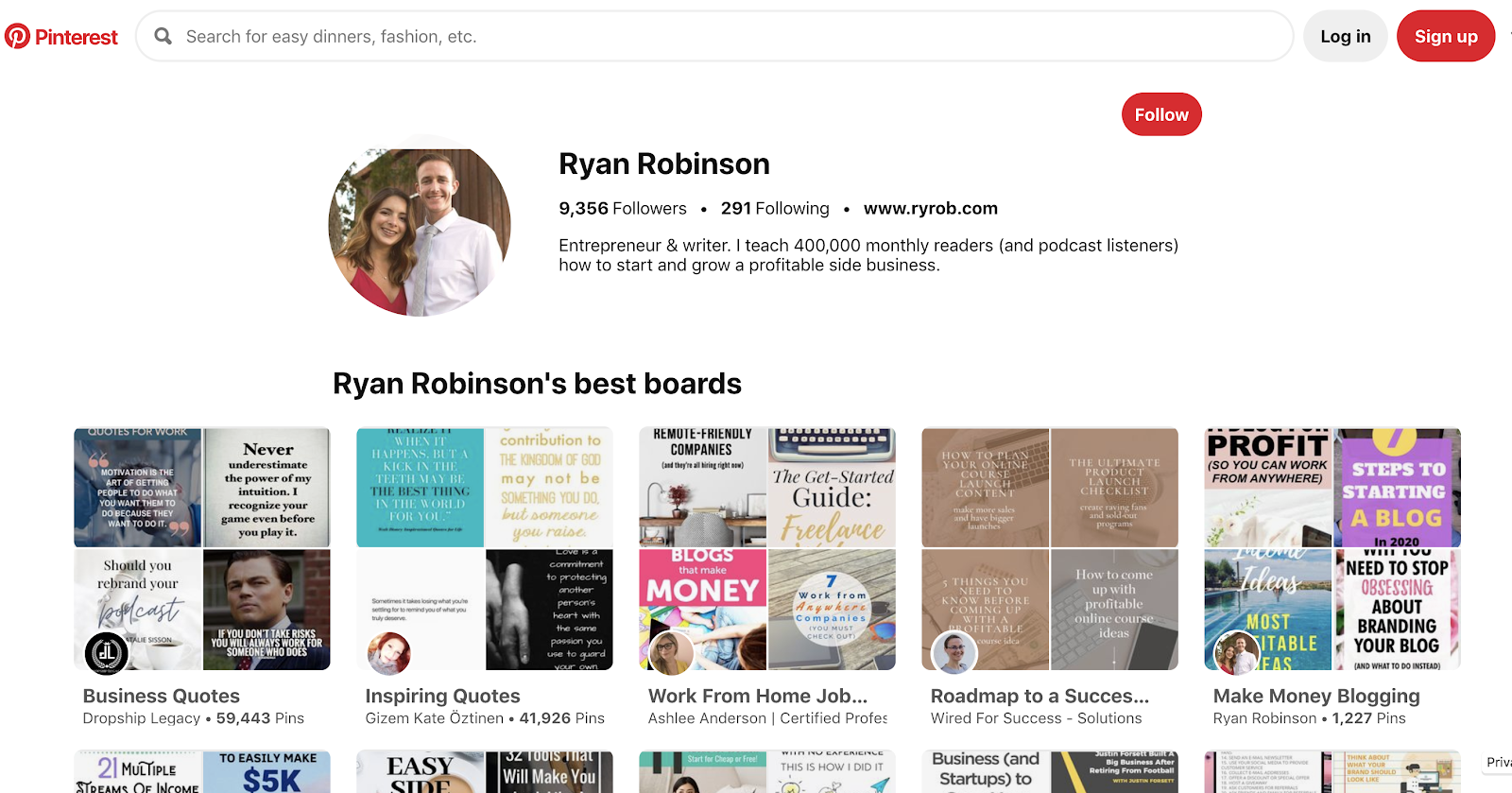
The first thing you should do when you begin marketing your blog on Pinterest is to turn your personal account into a business one.
The main reason to switch is Pinterest gives you a lot of tools to help you grow your presence and track what’s working and what isn’t. These analytics tools for marketing can tell you things like total impressions and engagement as well as the performance of individual pins. It’s a very easy step, but it opens up a world of information to you that makes your blog marketing efforts a whole lot more simple.
Use Pinterest Keywords that Appear in Search Suggestions
Like Google, Pinterest uses keywords to help people connect with the content they’re searching for. The algorithm method for Pinterest isn’t identical to Google, but there is a way to find out which keywords are most searched for on Pinterest.
When you do an ordinary search on Pinterest, it automatically shows you other words and phrases that are related to your search. These are views into the commonly searched things on Pinterest, and a way to help you find keywords to include in your title and description of pins. I’ll use the phrase “homestead” to show you how this process works:
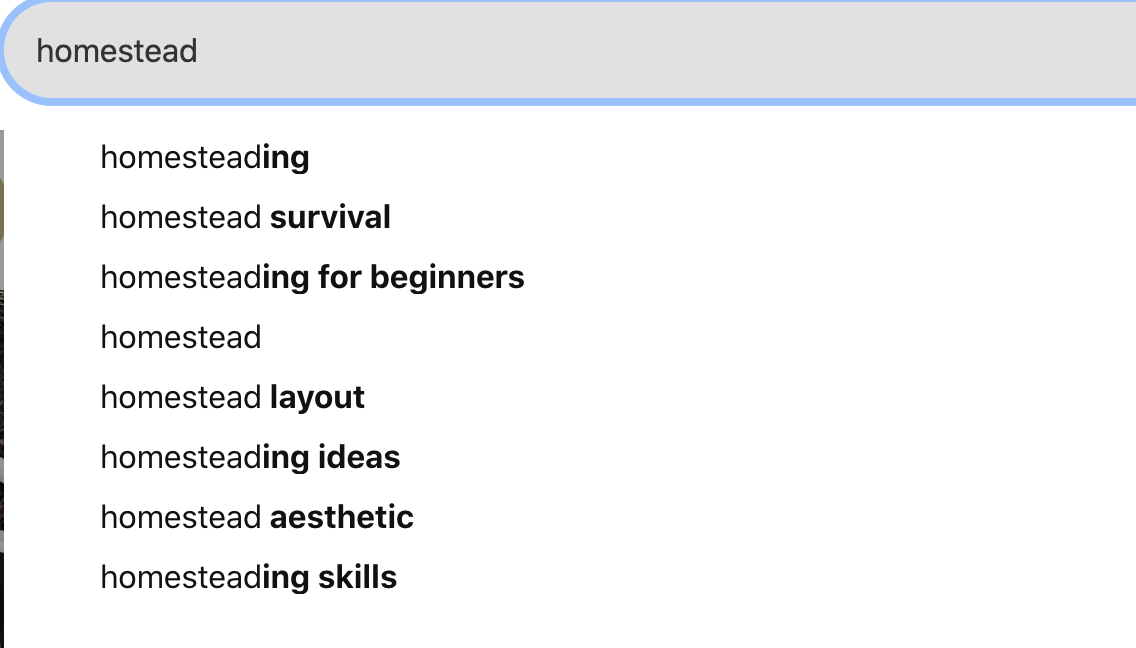
The drop-down menu gives you a selection of popular searches including this keyword.
You can use these choices if they’re related to the particular blog post you’re marketing. I chose to search for the word homestead to show you another way Pinterest reveals popular keywords here just below the search bar:
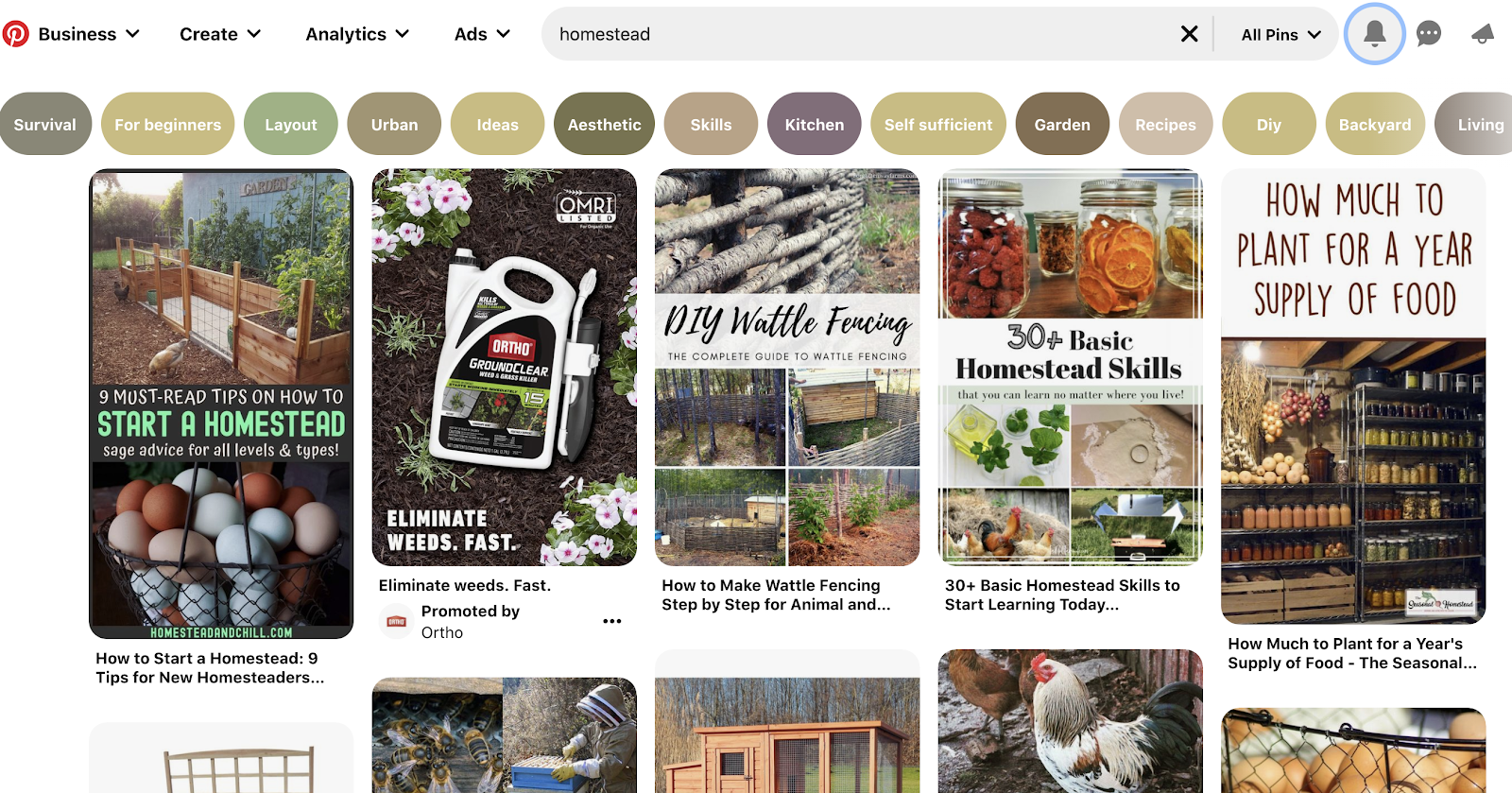
Here is the search result for the keyword “homestead.” Do you see all the little icons at the top showing keyword search words and phrases? This is a good way to see what people are searching for and the way that Pinterest guides them. If you choose one of the icons you can narrow the search even more.
I selected “urban” to show what types of things people are looking for under urban homesteading:
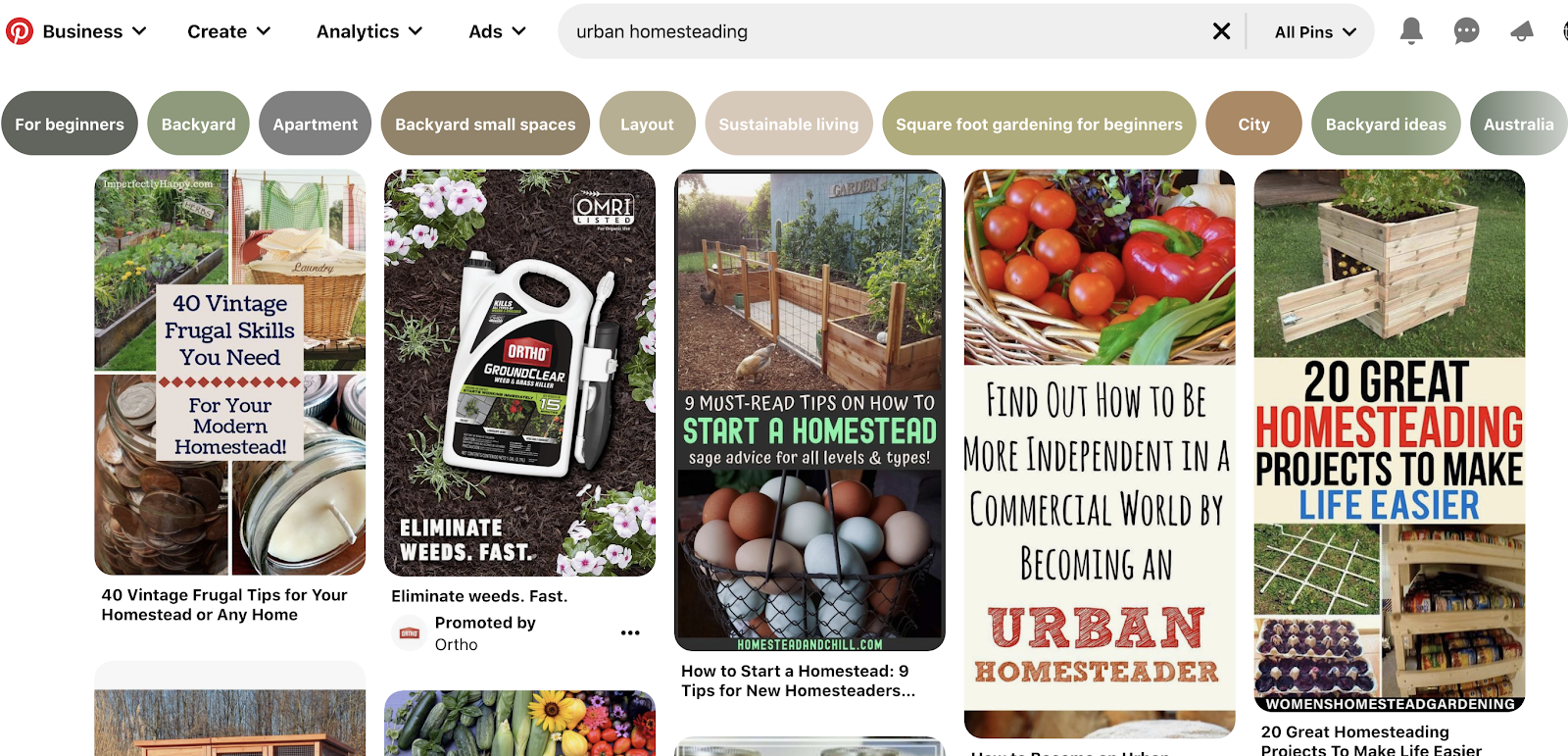
This search is now focused on gardening ideas for small spaces and things related to urban homesteading. I chose to go a couple of steps further and it led me to the topic of backyard gardening—which is a great idea for a blog post in this niche, and could work for both rural and urban aspiring homesteaders.
These keyword searches can give you ideas of what keywords to include in your content, as well as topics to write about for your blog and even shine a light on potential partners to involve in your blog marketing efforts.
Carefully Choose Your Graphics for Pinterest
One way to improve your presence on Pinterest is to use the right kinds of graphics to market your blog content.
Pinterest is good at providing resources for people to effectively use their platform for marketing and engaging with their audience. They wrote one article specifically outlining quick tips for selecting your images for Pinterest. The key takeaways of the article are:
- Use vertical images that are a 2:3 aspect ratio: This ratio means that your width should be ⅔ the height.
- Pick images that stand out: Pinterest advises, “Make sure to use images that are visually compelling and will stand out in people’s feeds. Your Pin images should clearly highlight your brand or service, and give people context about what it is you offer. Stay away from abstract imagery or stock photography that doesn’t help tell a story about your specific brand.”
This is a great example of a pin that uses the right ratio aspect and imagery that highlights the post from food blogger Heather Rosvold of Leavenly:
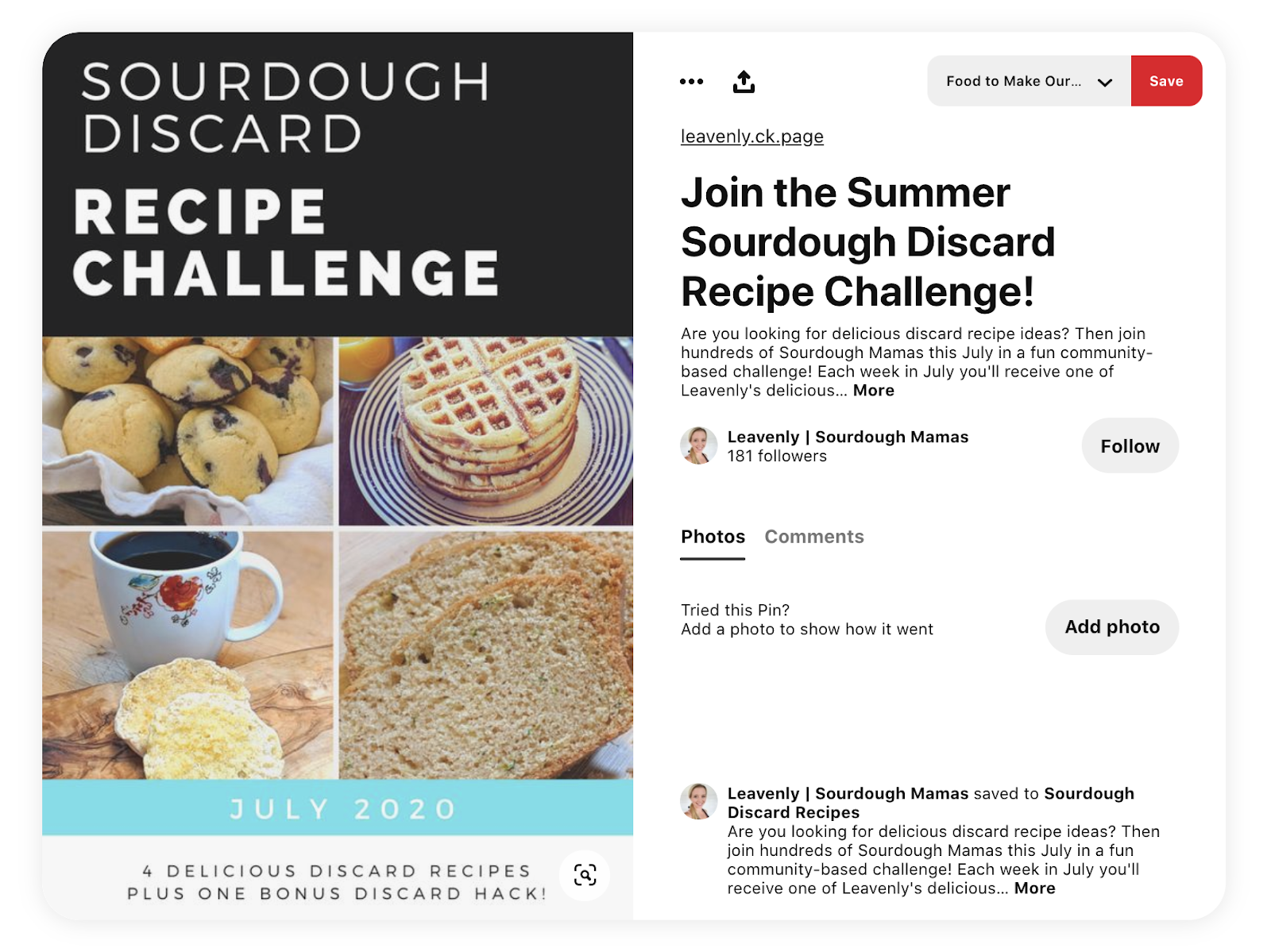
To design your Pinterest images, you can use a photo editing program like Adobe Photoshop and focus on using image dimensions that are much taller than they are wide, like:
- 600px by 900px
- 1000 by 1500px
- 1200 by 1800px
If you want to keep it even simpler, you can use a free image designing program like Canva that has preset dimensions for social media posts on Pinterest, Instagram and Facebook:
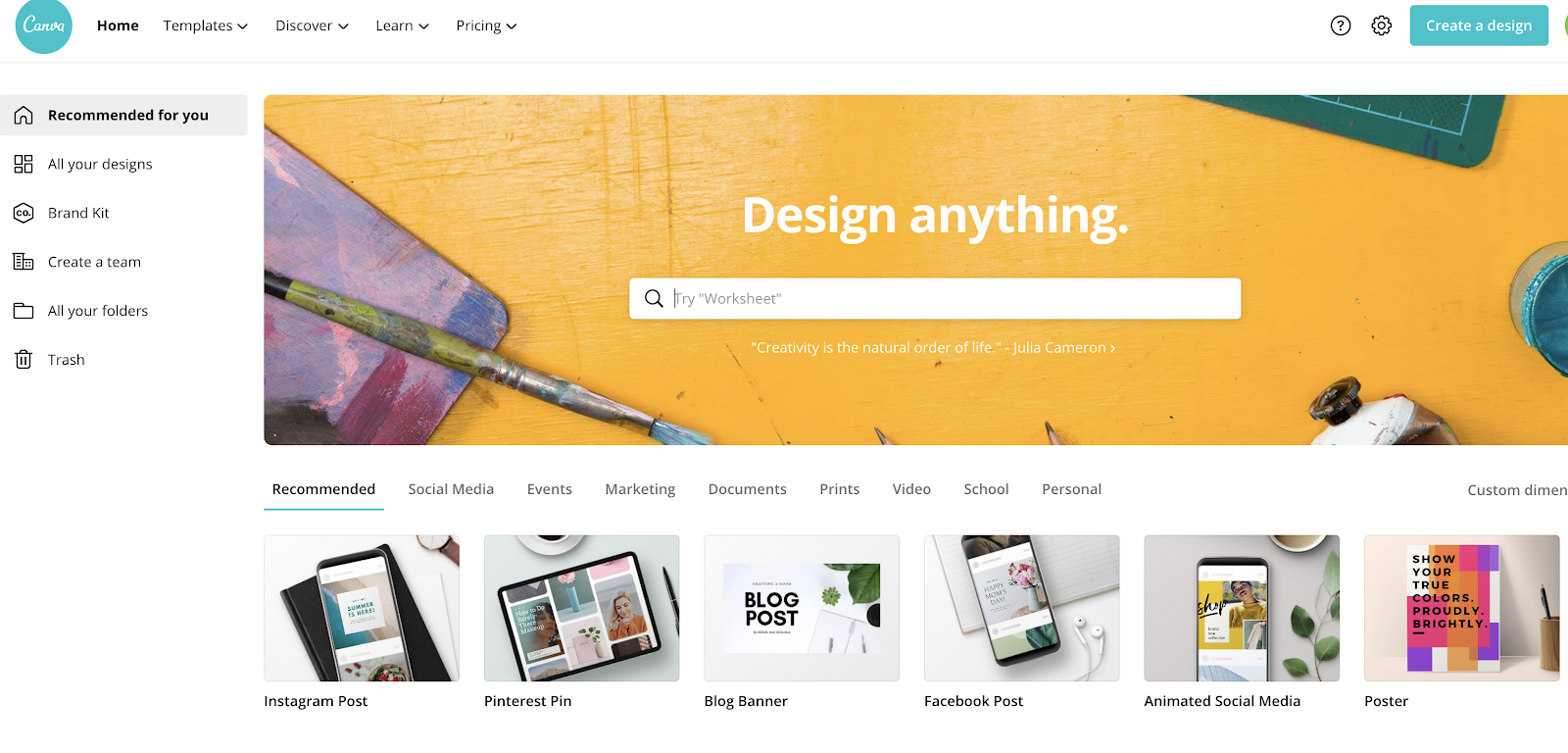
Now, let’s talk about the frequency with which you should be pinning images, in order to stay relevant and drive a meaningful amount of engagement from your blog marketing efforts on this platform.
Pin Often (and Pin Multiple Images Marketing Your Blog Posts)
Like any social media platform, the more you engage with it, the more engagement you will receive. That includes pinning content from other people—not just your own content.
One of the best things you can do is start several boards that your target audience will likely be interested in. When you title your boards, try to choose keywords that your target audience might search for. Here are some of the boards that I currently have on my own Pinterest:
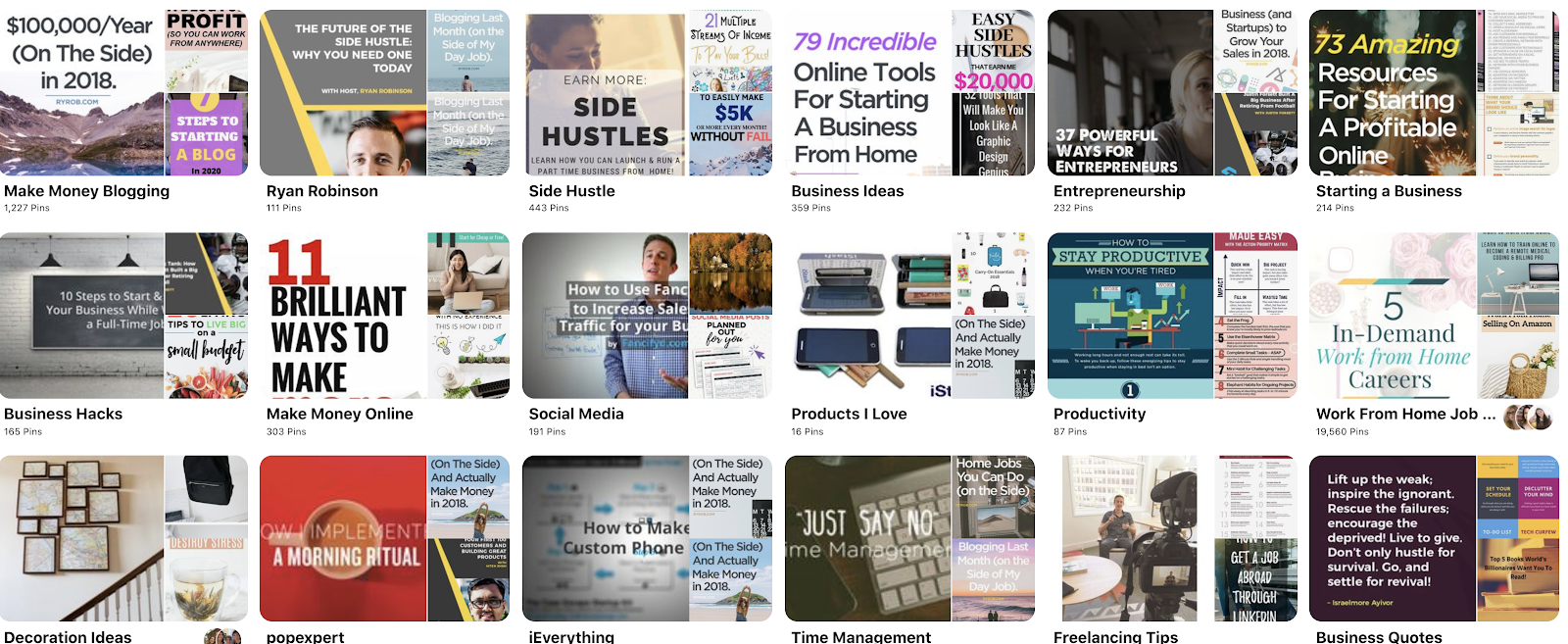
My Pinterest boards include main topics like:
- Making money blogging
- A board dedicated to my own content
- Side hustles
- Social media advice
- Business hacks & tips
These are all areas of interest to my target audience, as well as subjects I’m personally interested in. Posting to boards outside of my own content gives people a reason to follow me, and it also helps boost my other content.
Now when it comes to posting my own content, it’s also important to post often—and post different images promoting the same articles, multiple times. I recommend creating at least 3 to 5 pins (image variations with different titles, colors, background images) for every blog post you publish in order to get the most out of your blog marketing efforts on Pinterest. You can publish those pins all at once or over the course of days or weeks—whatever works best for you.
Here’s what that looks like with my blog post How to Start a Blog and Make Money:
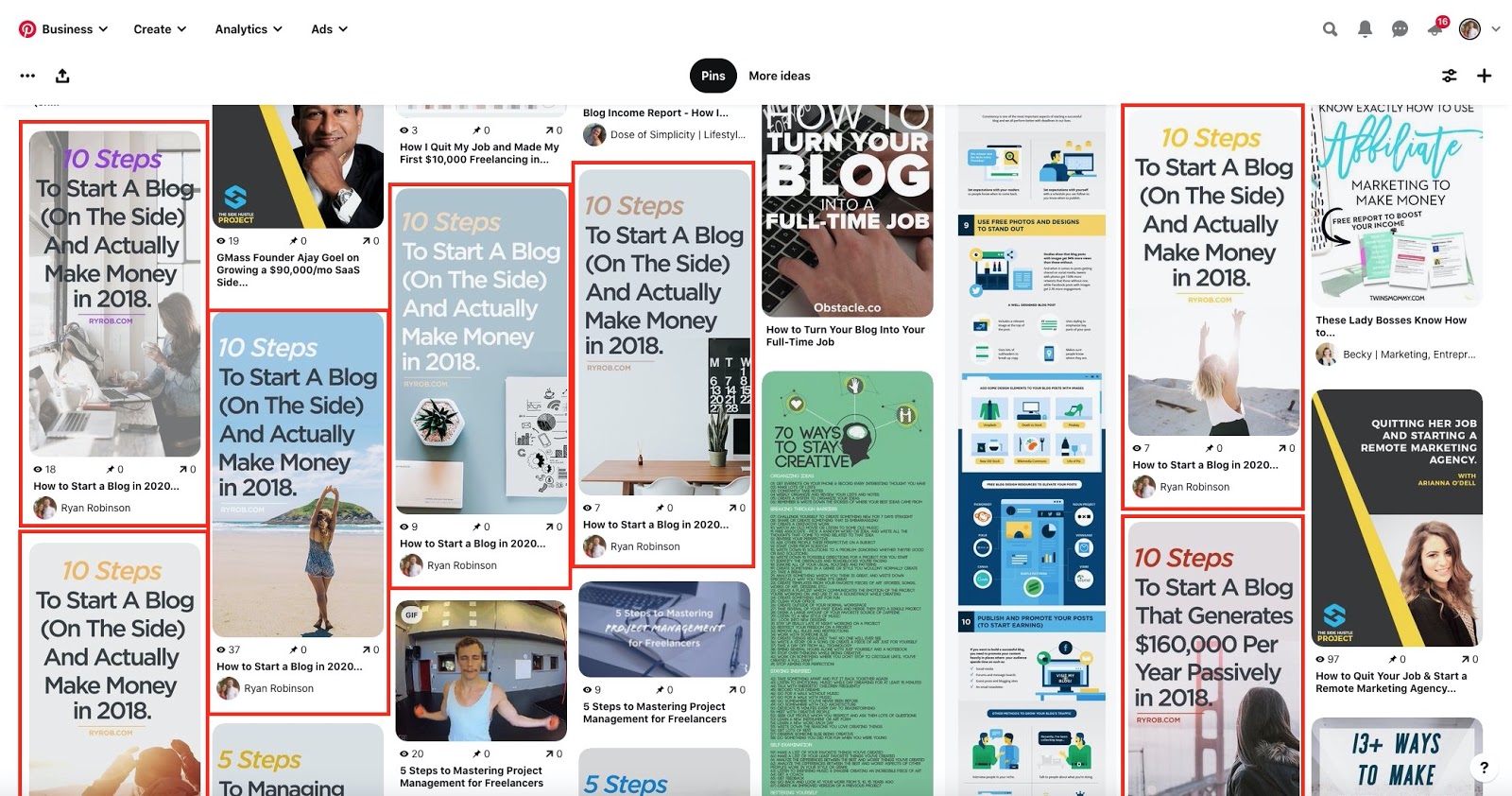
A few years ago I did a podcast interview with Grace and Silas Moser from Chasing Foxes and they shared some of their best advice about gaining Pinterest traffic. They launched their blog in 2016, and within a few months, they drove 1 million people to their blog from Pinterest alone.
In the interview, they mentioned that one big way to drive traffic is to write a lot of content and promote that piece of content several times. So each piece of content would be shared several times on Pinterest (on various boards) and there would also be multiple iterations of each blog post.
Grace mentioned that instead of just A/B testing, she might do A/B/C/D/E and maybe even F testing, to see which pins take off the most. Each pin may have a different image, title, or descriptive text in an attempt to hope one of them goes viral, which is often a possibility as you publish more pins and create more opportunities for that outcome.
How to Market Your Blog on LinkedIn
LinkedIn is often thought of as a way to network for businesses or to gain employment, but it can also be a place to promote your blog. LinkedIn officially launched in 2003, and today has over 1 billion users. So what are the significant benefits of using LinkedIn in your blog marketing plan?
Leveraging LinkedIn to Connect With Other People In Your Niche
One obvious benefit of LinkedIn is your ability to network with people in your industry. You may be able to connect with people for potential guest blogging opportunities, learn about your competition and learn about the successes of businesses related to your industry. Some of the best ways to connect with people on LinkedIn are to:
- Complete your profile with as much relevant information as possible
- Join LinkedIn groups that are relevant to you or your niche
- Connect with other users on LinkedIn that are related to your niche
- Engage with other accounts
Using LinkedIn to Build Your Blog’s Credibility
LinkedIn is an excellent resource to build your authority and etch out your place in your niche. LinkedIn allows you to send resumes to businesses, but your account can also serve as a resume to the public about you and your blog.
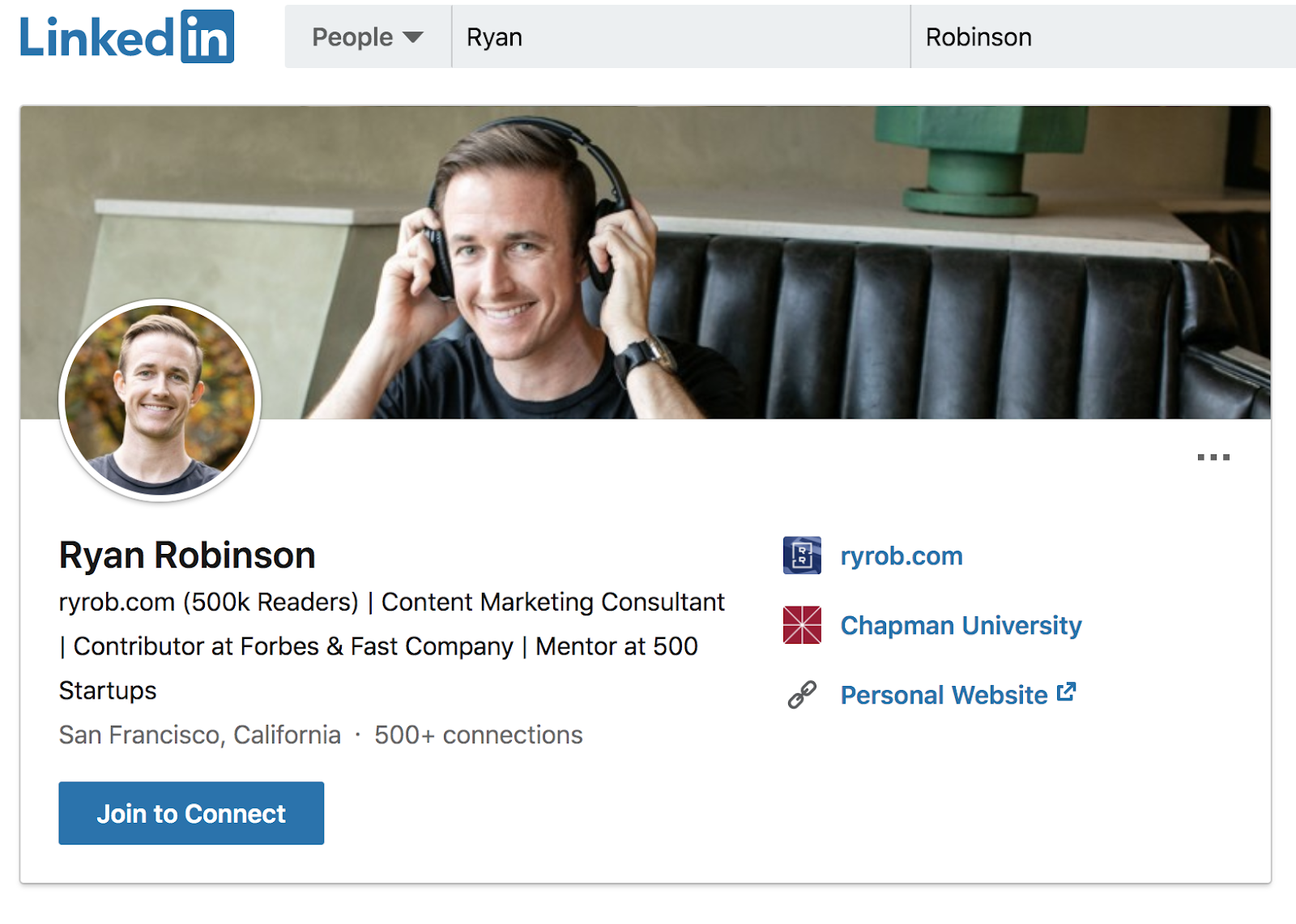
This is my profile on LinkedIn. I included a link to my blog as well as my credentials. The credentials I’ve included give people a reason to trust in the content that I am sharing on my account and my blog.
Under the experience section, I include even more reasons for people to trust my authority in my industry.
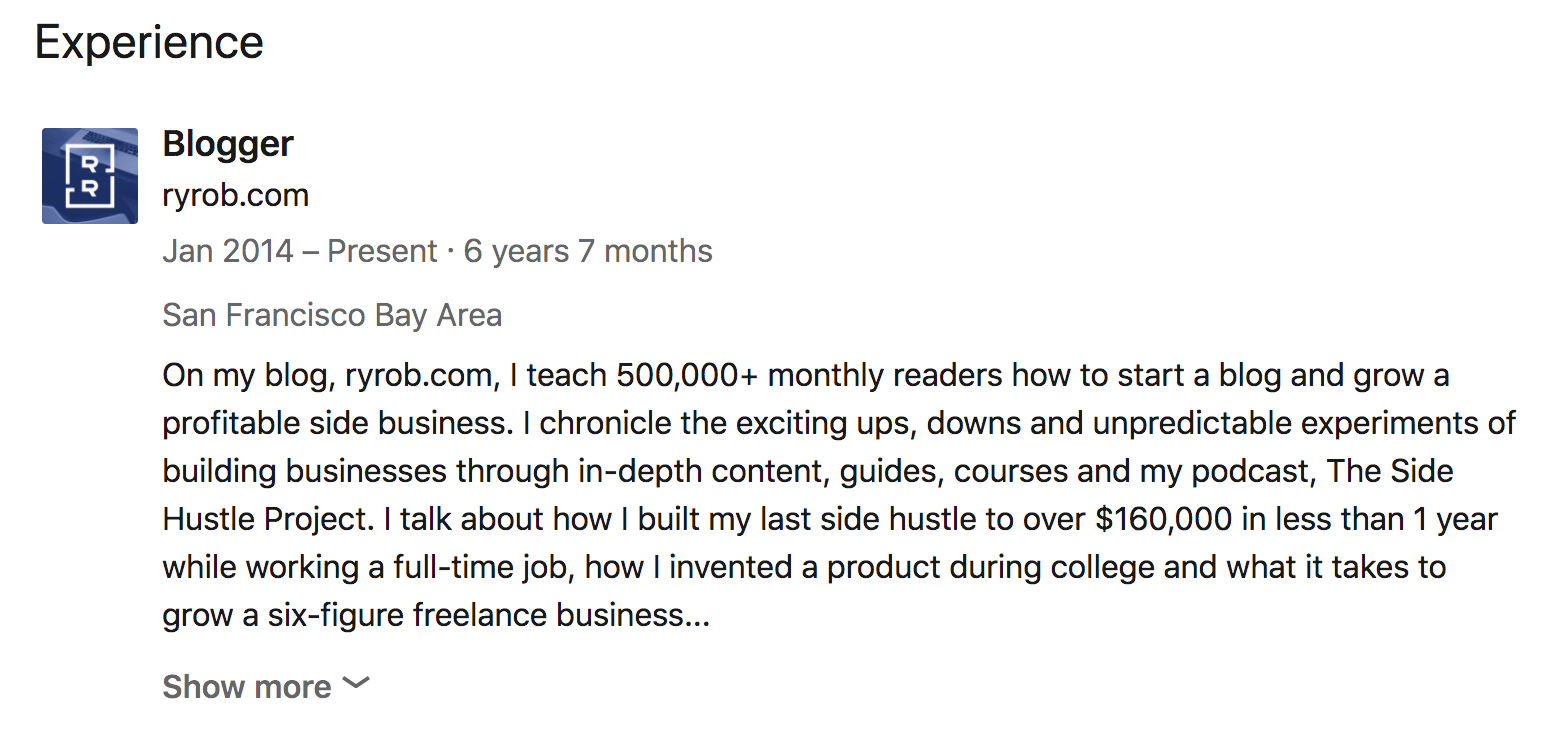
It may feel a little like bragging when you build out your LinkedIn profile, but there are a few tips I’ll share to make your profile feel more authentic.
- Share true things: There’s no reason to inflate your accomplishments when sharing on LinkedIn. Be confident, but don’t exaggerate what you’ve done, or it will erode people’s faith in you.
- Work hard to be accomplished: One of the things I share on my blog and LinkedIn is my experience writing for publishers like Forbes and Entrepreneur. Writing for high-profile companies takes real work and dedication. If you want to stand out in your industry, work hard to get there. Your accomplishments will be hard-won, but they’ll also be accurate and honest representations of the value you add in your niche.
- Remember, it’s someone’s first introduction to you: You probably don’t walk up to strangers and tell them all about your accomplishments in life. However, if you were a company trying to sell something, you would work hard to show what’s excellent about your product or service. It’s the same thing with your blog. People are finding out about you and your blog, possibly for the first time. It’s your job to show them why your blog is worth their time.
Share Helpful Content on Your LinkedIn Feed
In addition to my profile information, I’ve also written a few articles that I shared on my LinkedIn profile. In 2017, I republished an article titled 3 Cold Email Templates for Landing Six-Figure Freelance Clients:
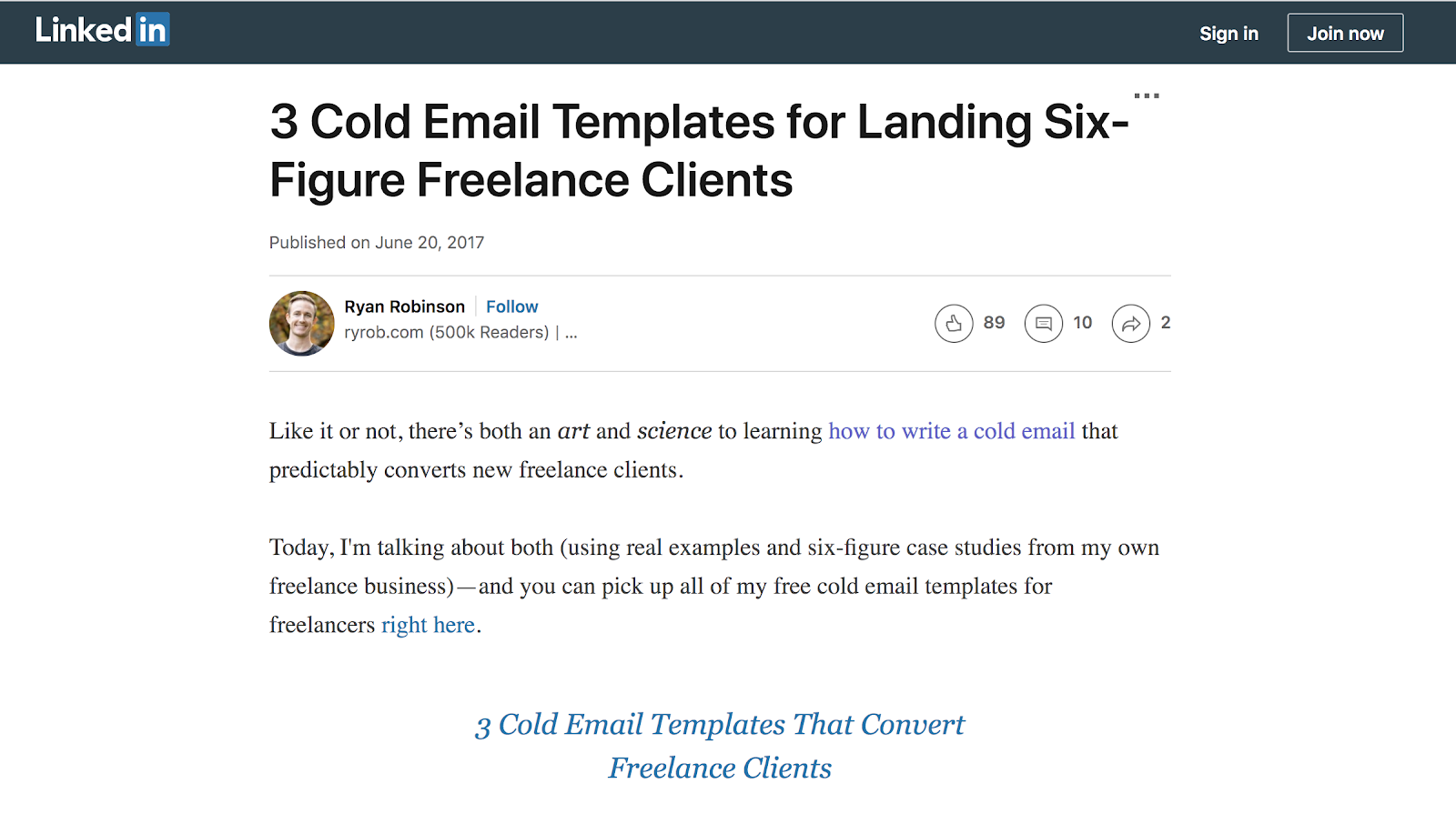
By adding these articles to LinkedIn, I have an opportunity to link back to my blog and show people visiting my profile the kind of valuable content that I have to share—it’s a win-win from a blog marketing standpoint.
How to Market Your Blog on YouTube
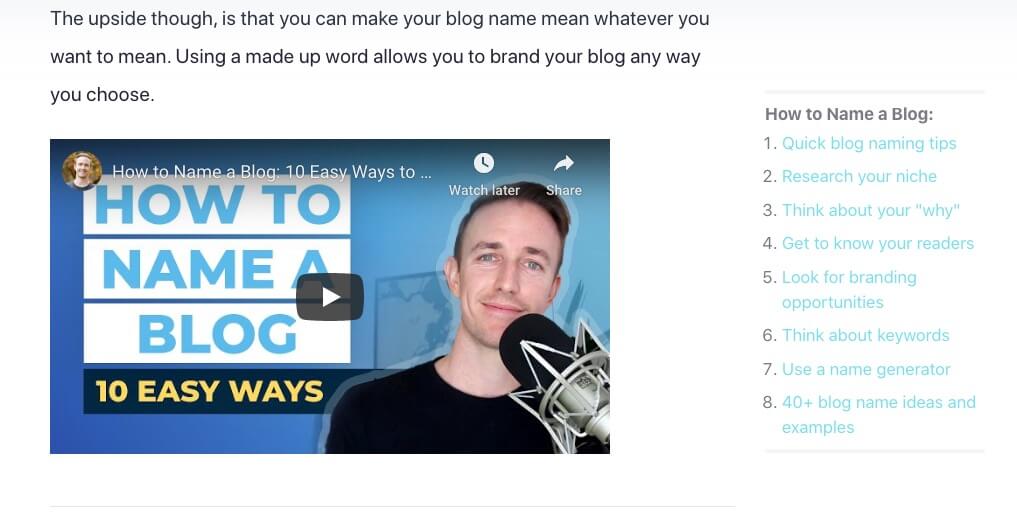
YouTube has been around for quite some time. It first launched in 2005 and has since become a major force on the Internet. Some people wouldn’t consider YouTube a social media platform, but since it’s a networking site that allows sharing and commenting, I include it on this list.
What makes YouTube a helpful marketing tool for bloggers? One of the most appealing things about YouTube is its enormous built-in audience. Next to Facebook, YouTube has the largest number of active users clocking in at 2.5 billion active users every month. Aside from that, people respond very well to video-based content. Videos are known for increasing conversion rates and leading to greater engagement and interest.
Of course, blogging and vlogging are two different things. Not everyone who is a YouTube star is going to have a successful blog, and not everyone who blogs wants to start a YouTube channel. That being said, you can choose to do both, and each one benefits the other. Let’s take a look at how to use YouTube for blog marketing.
Turn Your Blog Content into Actionable YouTube Videos
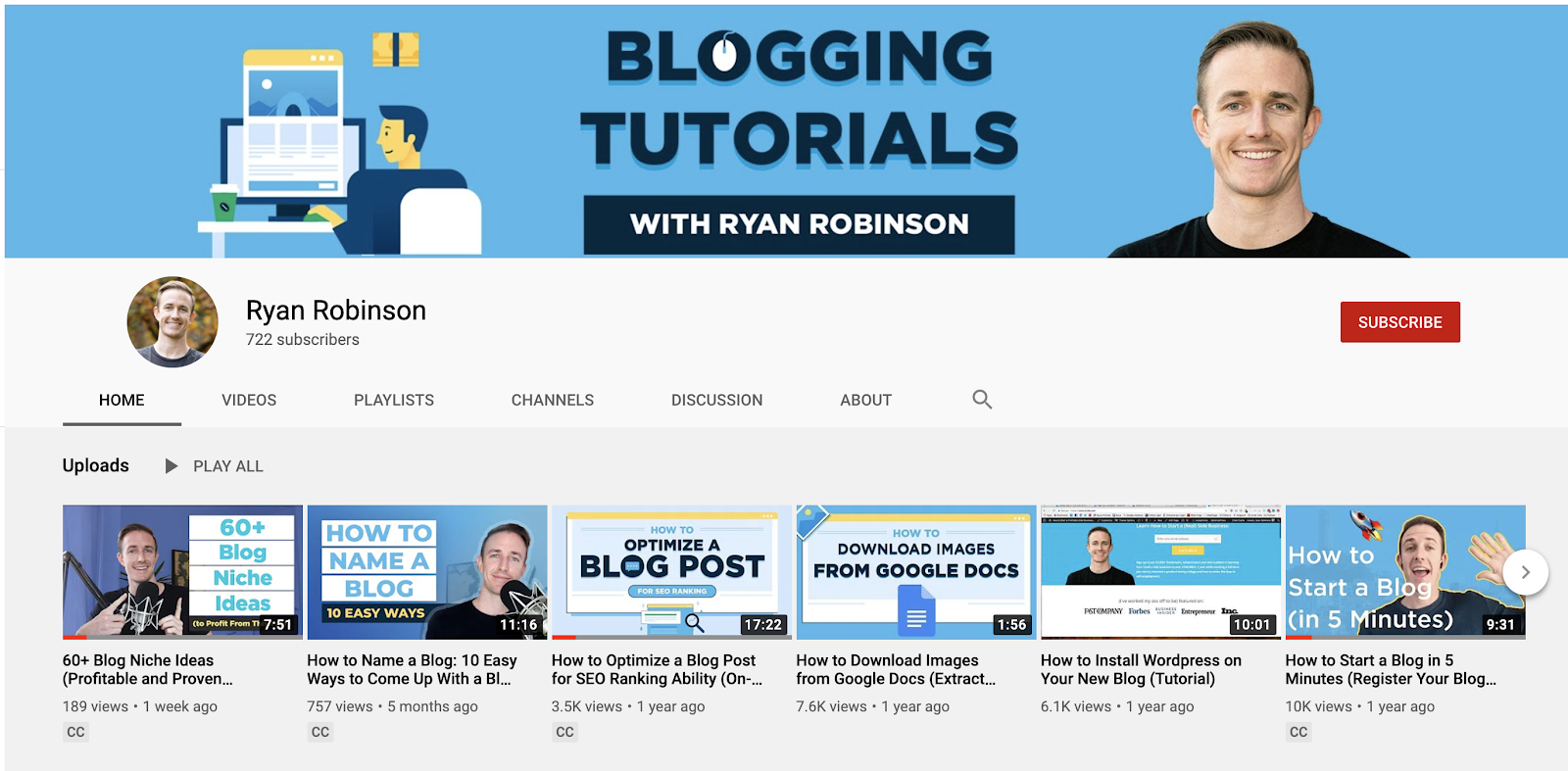
One of the things that you can do for your blog is to take the content you’ve already created in text and images and turn it into a video. That’s something I’ve been slowly doing over the past year or so.
Admittedly, creating videos is not a super fast process (for me), and when you’re already working hard to write great content, the idea of adding a video element to it after you’ve just written 15,000 words, can seem overwhelming to say the least. But, for some bloggers, creating video content is more energizing than sitting down to write for an entire day.
That’s why I believe that using the same content you’re sharing in blog form style, over on your YouTube channel is key here. The most appealing part of sharing content this way is you can do direct links to your YouTube to specific correlating blog posts, and you can embed a YouTube video right in your blog post. In fact, Google often appears to reward blog posts that have embedded YouTube video content, making this a blog marketing strategy with multiple kinds of payoffs.
In blog posts where I include videos, I tend to see a noticeable change in my rankings on Google. Often, when I have an article that’s already climbing up page #1 for a competitive keyword, it almost always gives me another boost after embedding a video I made on the same topic (especially if people are watching the video within my blog post).
For example, check out a recent YouTube video I made, titled 60+ Blog Niche Ideas (Profitable and Proven Demand). The YouTube video correlates directly to the content from my blog post How to Pick a Blog Niche. You can see right here how I embed my YouTube video directly into the blog post:
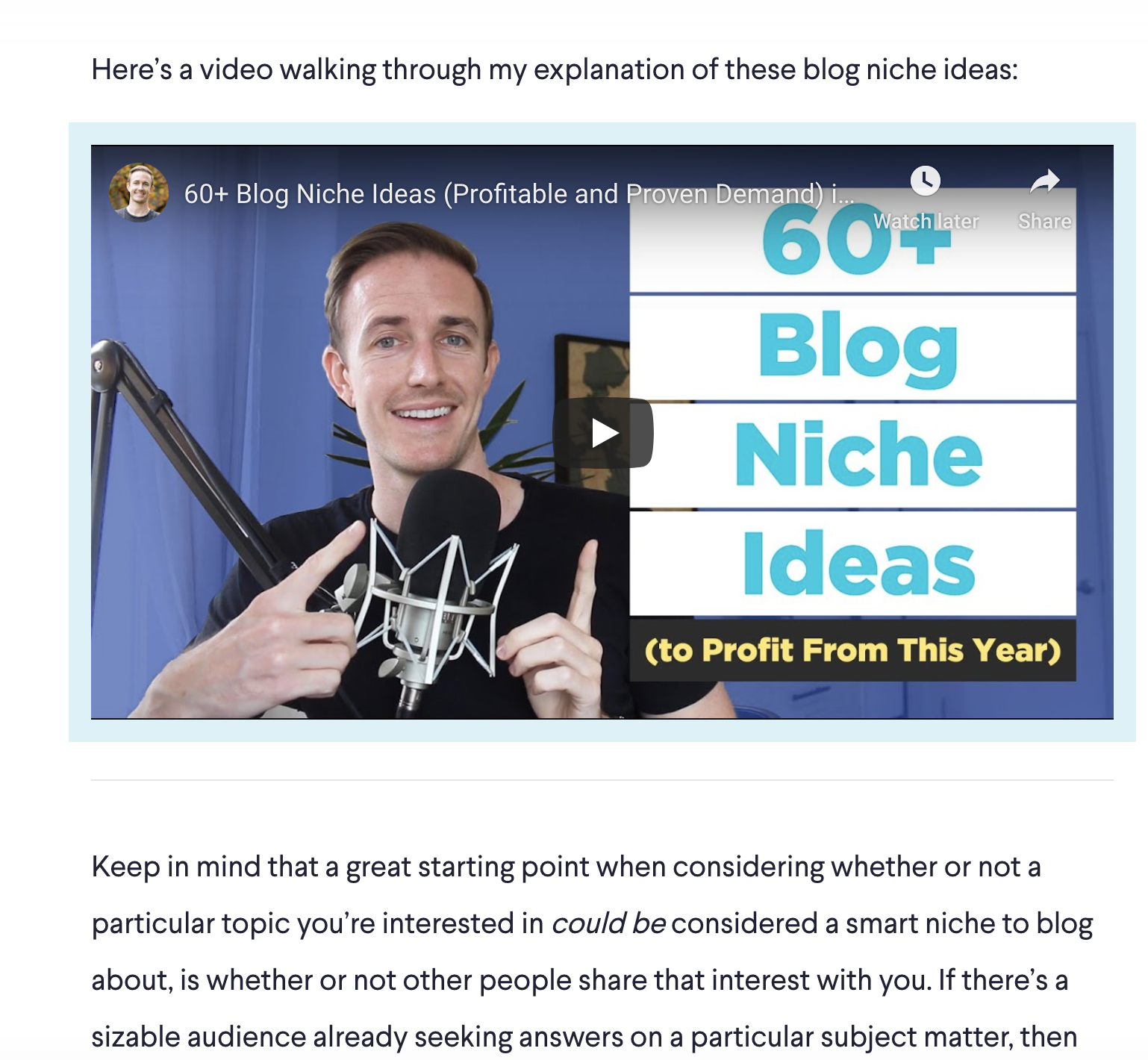
In my video, I share 60 niche blog ideas that have proven demand (a super relevant topic to both my article and in search results on YouTube). My video focuses on one part of the blog post (specific niches) and expands on it more fully in the video. These two things work together and drive traffic to each other.
People visiting my blog give new views to my YouTube video, and people visiting my YouTube will also follow links back to my blog. Here’s an example of how I market my blog within my YouTube video description section:
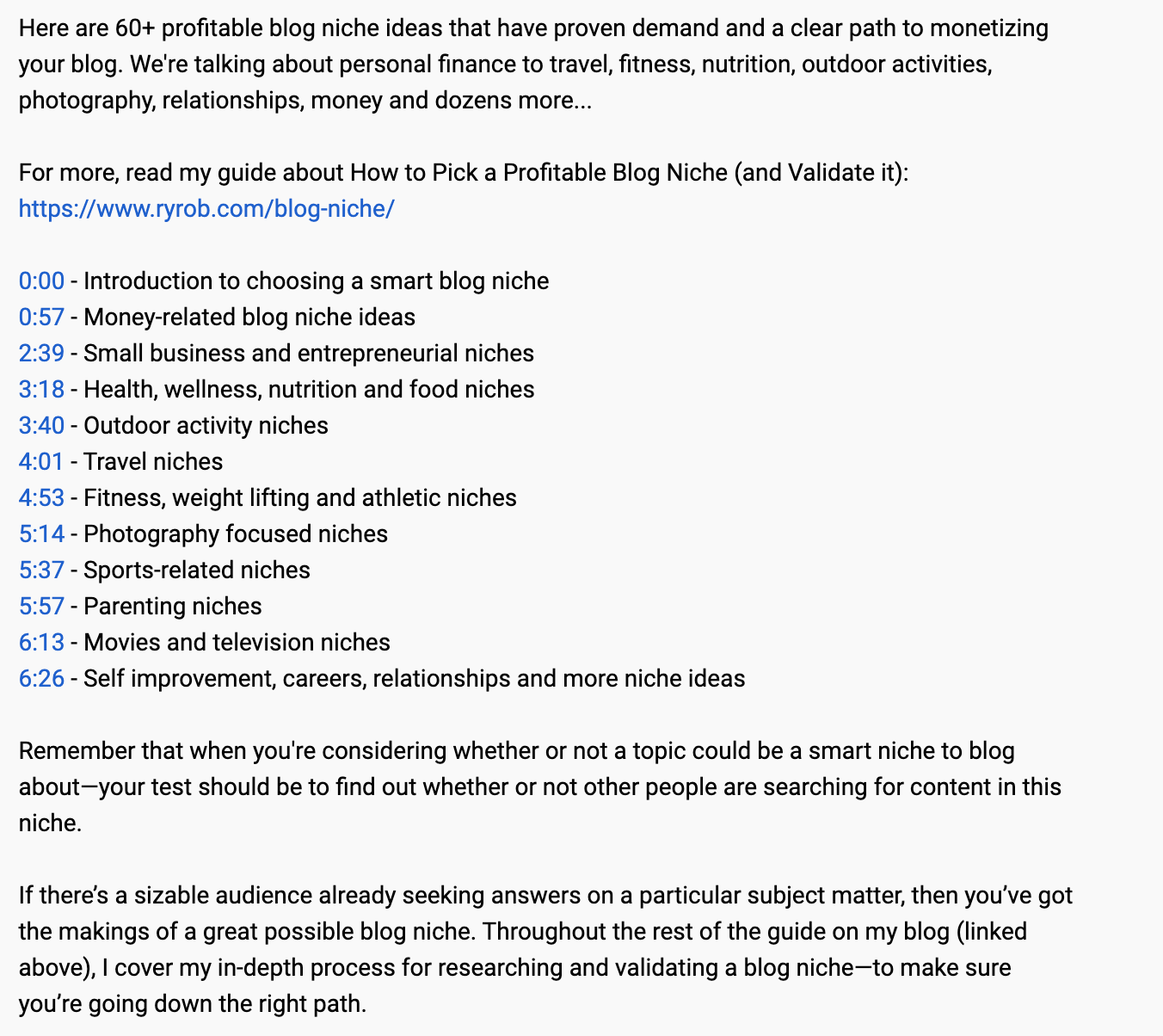
Of course, I also plug my blog at the end of my video to let viewers know that they can get even more helpful info directly on my blog.
Don’t forget, you can use your YouTube channel as another means of making money from your blog, too. The same affiliates you’re supporting on your blog can often translate to your YouTube channel, which can increase revenue as well as additional blog marketing rewards.
Ultimately, adding video content to your blog post can both create a better user experience—and bring more future traffic back to your blog.
Getting Viewers to Your YouTube Channel
Of course if you’re not getting any views on your YouTube channel, you aren’t likely to drive any traffic back to your blog.
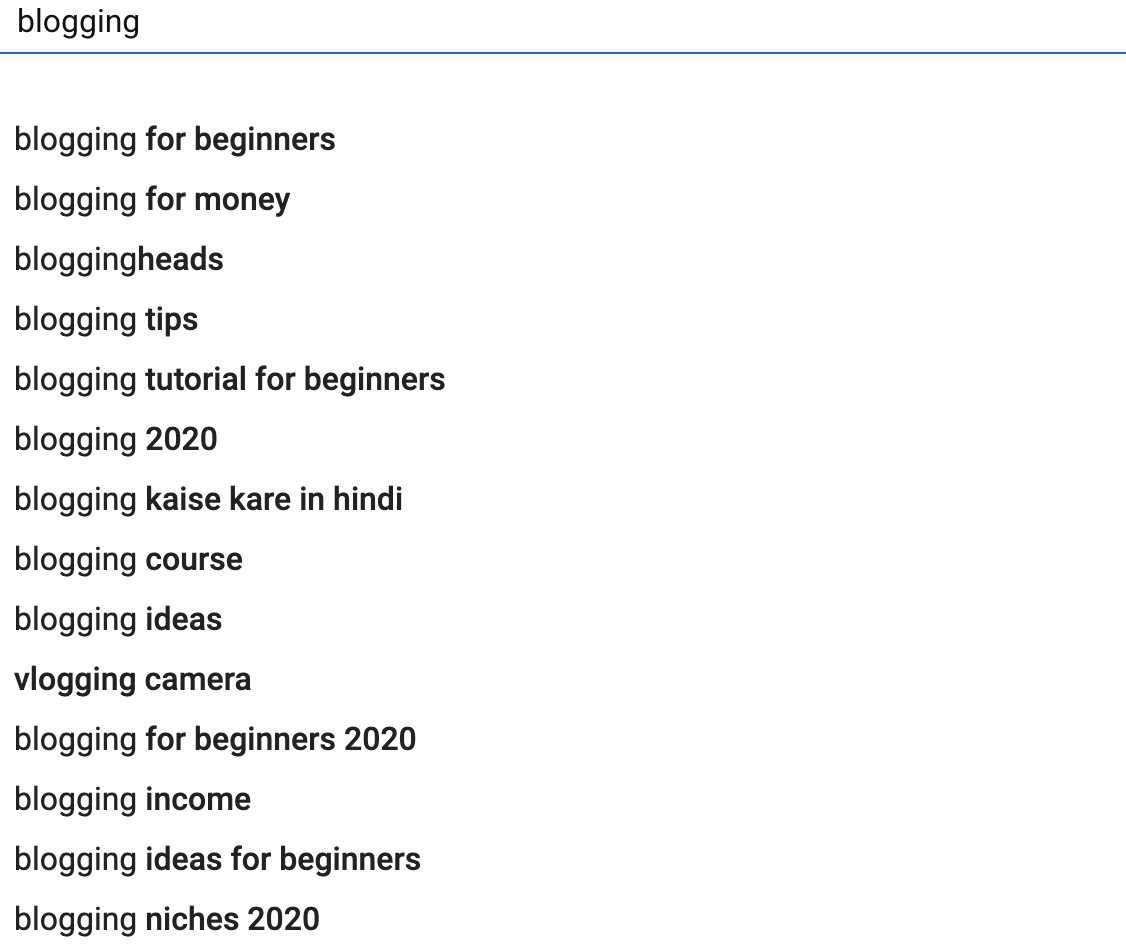
Let’s run through a few tips to help grow your presence on YouTube and ultimately send those interested readers back to your blog.
- Use Google keyword to create your profile, video descriptions and titles: Many people discover videos searching directly on Google’s search engine (not just by searching on YouTube). That’s why you should spend some time searching for the right keywords that will help your video rank higher in a Google search.
- Do YouTube Keyword Research: Discovery on YouTube is another way to gain followers and views on YouTube. To find some keyword ideas, put in a keyword in your niche and see what comes up. I punched in “blogging” to see what would come up in my niche.These autocomplete words are things that people are searching for and are a good example of words you can be including in your titles and descriptions.
- Make the most of your YouTube tags: Tags are descriptive keywords that YouTube allows you to add that make it easier for people to find your videos. You can use the keywords that you already searched for to put in this section. You can also use your own tag branding to classify it under your channel/blog’s name.
- Use custom thumbnails for your videos: Custom thumbnails increase the likelihood of someone clicking on your video. For the best results, YouTube recommends the following parameters for thumbnail images:
- 1280 x 720 resolution (with a minimum width of 640 pixels
- JPG, GIF, BMP or PNG image formats
- Under the 2 MB limit
- 16:9 aspect ratio
With these YouTube blog marketing best practices in mind, you’ll be able to hit the ground running with growing a loyal audience on this surprisingly underrated platform.
How to Market Your Blog on Instagram

Now, let’s talk about using Instagram in your blog marketing efforts—because it’s potential for attracting a loyal audience has grown significantly in recent years. Even if you have a coaching business, you should use Instagram, as it is a powerful marketing tool that can help you attract more people to your business.
Instagram first hit the social media scene in 2010, and after becoming immensely popular was later acquired by Facebook in 2012. While text can be an important part of the Instagram experience, images are the core of what makes this platform special.
Instagram has a large user base with about 2 billion monthly active users making it one of the most popular social media platforms on the planet. Unfortunately, despite the large audience, many bloggers report that Instagram is not one of their biggest traffic sources. Social media platforms like Facebook and Instagram want to make money too—which is why it’s challenging to get free organic reach through these platforms.
I always recommend focusing on only one or two social media platforms, and for my blog Instagram isn’t the place that I’ve put most of my focus. X and YouTube are a better fit for me, but that doesn’t mean Instagram is without its benefits.
Some people can turn Instagram into a microblog and have successfully monetized it that way. Others grow a broad audience and drive significant traffic back to their main blog. Even for people who don’t have a great deal of time to spend on Instagram, one of the greatest benefits is how easy it is to network in your niche. Without much effort, you can quickly find other users who share similar interests and find people in your target audience.
While you can experiment with paid advertising on Instagram, I’ll share here some tips for growing your audience and using Instagram to market your blog without any additional spend.
Choose Your Images Very Carefully
Instagram is a visual-first platform, and that’s why you need to choose your images carefully. Users scrolling through Instagram will quickly go past images that are poor quality, overly amateur, or otherwise unappealing.
Some basic rules for posting appealing images:
- Use a quality camera: Many smart phones today can shoot phenomenal photos, and since the Instagram app is probably already on your phone, it makes the process pretty seamless. With that being said, if your phone is outdated, you may want to invest in a camera that takes higher quality pictures. The difference between an obsolete phone image and one from a more top-grade camera is very noticeable.
- Use photo editing software: Don’t rely on Instagram filters and their editing software alone to make your images remarkable. Try using editing software like Adobe Lightroom, VSCO, or Snapseed to make your images that much more stunning.
- Make your images cohesive: Some Instagram users have such a focused style that you know it’s their image as soon as it shows up on your feed. They’re able to achieve this continuity by taking photos with similar colors, filters, and editing.
To give you a better idea of what I’m talking about, here’s a screenshot of the Instagram account cardboardfolk. This Instagram account is run by a mom of young kids who makes everything you can imagine from cardboard. She has an Instagram following of 48 thousand people, which is no small feat.
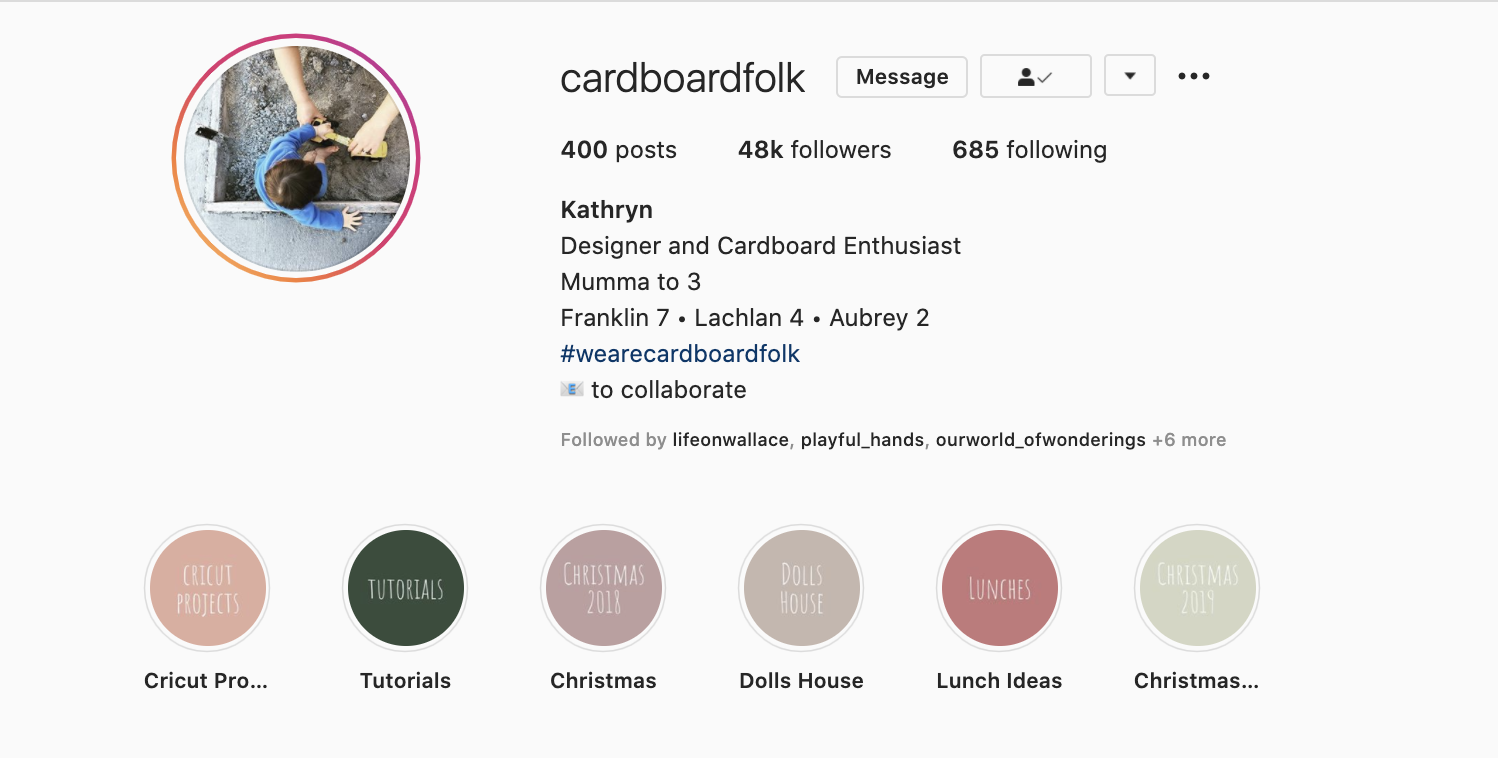
Scrolling down a bit and taking a look at her content feed, what stands out most about the images, carousels and videos that are visible on her profile?

First of all, almost every post is related to children and or cardboard. There’s continuity in the subject matter, but it’s more than that. All of her photos are bright, light, and most of them have white backgrounds and negative space. When you look at her feed, all of her images look like they’re part of a collection. That’s the kind of branding on Instagram that people are attracted to.
Your Instagram Bio is Important Real Estate for Blog Marketing
It’s not easy to share links on Instagram like it is on X, Facebook, or Pinterest. The main reason is users with 10,000 or fewer followers aren’t allowed to share links in stories or posts. Without 10,000 followers, you can share links in your bio and the description of IGTV videos only. That’s why I suggest making the most of your Instagram bio. You’re only given 150 characters, so make it count.
Your bio should include a description of who you are/what makes you unique and a call to action directing people to your blog.
Since Instagram only allows one link in an Instagram bio, many bloggers use a link tree instead of a link to their homepage. Using this free tool will enable you to include several links to different destinations. So if you have a brand new post you want to draw attention to, you can add it to a link tree. You can also include other social media pages, a YouTube channel, or an e-commerce shop (like Etsy).
Use Instagram to Network with Other Bloggers in Your Niche
Networking is one of the most useful things that Instagram has to offer. With a few clicks through hashtags or Instagram’s search and explore, you can easily find people in your industry.
Let’s do a little run-through of how easy this is to do. Grilling blogs are popular, so we’ll say I just opened up an Instagram about grilling, and I want to find other people who are into grilling too.
I head over to the search section of Instagram and type in “grilling” and get a results page like this:
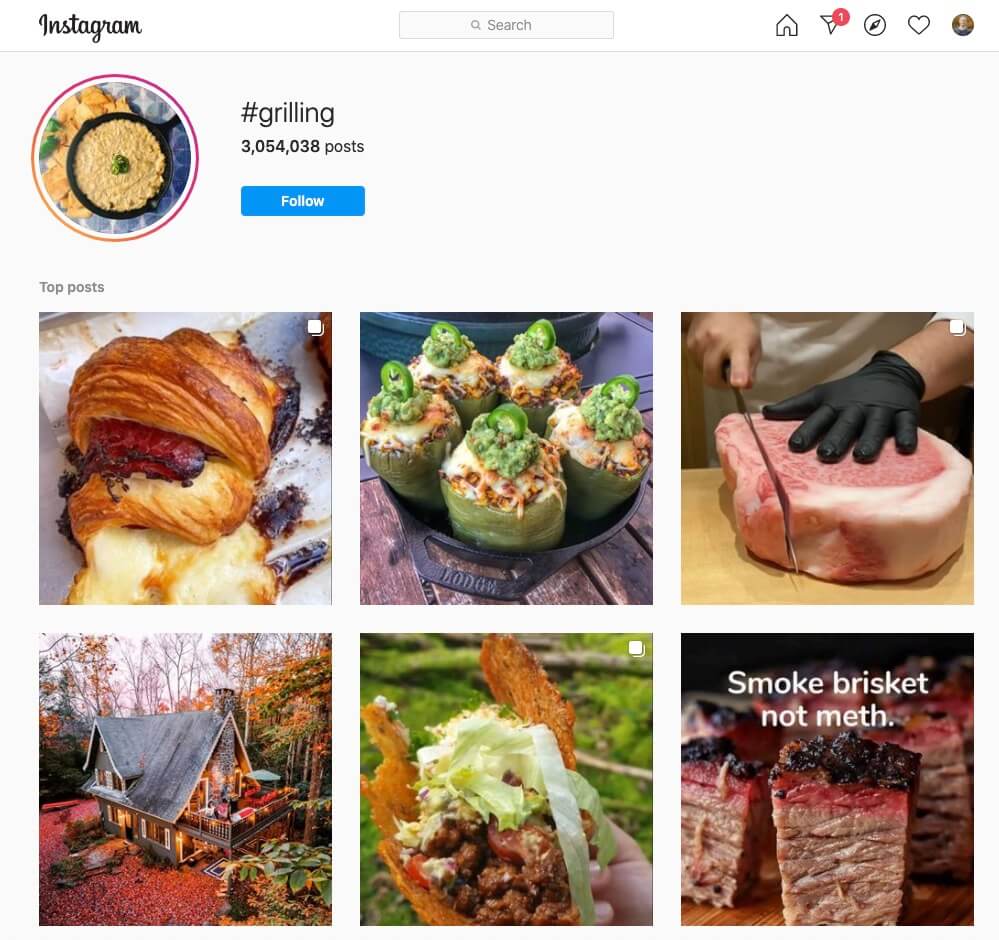
From here, I can select any picture that looks good to me. I chose one that looks interesting, and it brought me to this account, SteakVideos:
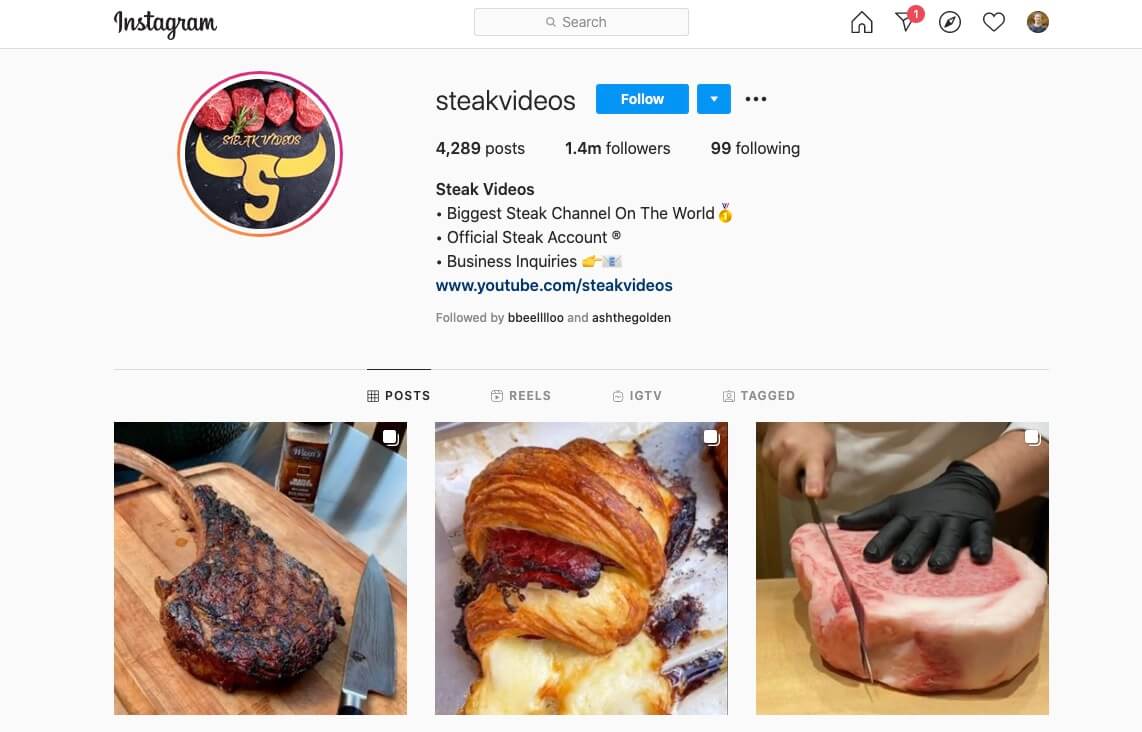
They have 1.4 million followers, great pictures and seem to know a thing or two about grilling steaks. This would be a good account to start following on Instagram if I’m also creating content about grilling. I can also check out the people who follow this account to see if others have quality content about grilling to start networking with. At the very least, I know they’re following his page, so they might be within my blog’s target audience as well.
Now we’ll say I just shared my first Instagram post about something I grilled. One little tip is to follow the hashtags that I used in my post to find other people posting about the same thing. Once you do that, you can choose top posts or recent posts.
I like to check out recent posts because I can find users who don’t already have thousands of followers. Finding Instagram accounts that aren’t already highly popular may give me an advantage for growing my follower group. In other words, if I like or comment on their posts, smaller Instagram accounts are more likely to return engagement than someone who has too many followers to keep up with. It’s worth it to follow users with only a few hundred followers as well as those with thousands.
The more people you interact with, the more likely they are to like, comment or follow your Instagram in return.
Collaborate With Other People on Instagram
Once you start growing your follower and following list on Instagram, you can start looking for others in your niche to collaborate with. Collaborations are an excellent way to grow your audience and help other people grow theirs as well.
Some ideas for Instagram collaborations include:
- Joint giveaways
- Join Instagram engagement groups
- Start or participate in a challenge post
- Start a loop give away
- Share each other’s posts or stories
- Do a guest post for other bloggers who use Instagram and promote it
Start with these foundational best practices and strategies for marketing your blog on Instagram and you’ll be well on you way to building relationships with other bloggers that can help boost your return on this platform.
How to Market Your Blog on Medium

Medium is one of the top free blogging sites still in existence today, and they launched in 2012. Now, Medium has around 100 million monthly active users.
You may have noticed that Medium content sometimes ranks near the top of competitive search results. Medium also has an incredibly high domain rating and almost 610 million backlinks (which you can explore on Ahrefs backlink checker.)

It may seem counterintuitive to use a separate blogging platform to post your content on—the concern may be that you’ll drive more traffic to Medium, but it won’t help grow your blog. That’s actually a reasonable concern, but keep in mind that Medium can also be an excellent way to connect with a broader audience and give them a taste of the great content that you regularly share on your main blog. I like to think of Medium as more of a blog marketing tool, rather than a competing platform.
So how do you take advantage of Medium’s vast reach to market your blog? Here are a few ways that I find to be the most impactful.
Republish Your Blog Content on Medium
Republishing work on Medium is one way to market your blog without having to create extra content. One thing to keep in mind is if you simply copy and paste the same content into Medium that you have on your blog, you’ll risk hurting your SEO standing with Google. This is what Google has to say about duplicate content, “in some cases, content is deliberately duplicated across domains in an attempt to manipulate search engine rankings or win more traffic. Deceptive practices like this can result in a poor user experience when a visitor sees substantially the same content repeated within a set of search results.”
Google tries very hard to index and display pages with distinct, original information at the top of their search results.
To avoid this mistake, Medium suggests that you instead “import” your blog content to their platform. Medium explains, “If you have a story published elsewhere and would like to import it to Medium, you can use this handy import tool. Using the import tool will automatically backdate the post to the original date, as well as add a canonical link to make sure your SEO won’t be penalized.”
You can import your content right on the Medium platform. Note that this can only work on a desktop. Medium also explains that you can only repost content that you have the rights for. When you import a post, Medium automatically puts a link at the bottom to the original publication.
When it comes to reposting content, I would choose material that has been on your blog for some time. You want to give search engine crawlers a chance to rank your blog and it gives you time to learn how well it is performing before you add it to Medium.
Post Original Content to Medium
You can also choose to post original content to Medium. I wouldn’t spend as much time or effort writing for Medium as I would for your blog, but it can be an introduction to a wider audience that you may not be reaching at this time.
Write quality work when you post to Medium, but don’t worry about writing long-form articles that take up a lot of time or resources.
General Tips About Using Medium to Market Your Blog
Medium, like most social media platforms, works best when you post often. You may end up writing (or republishing) an article that goes viral, but your chances of succeeding increase when you have more content to share.
When it comes to designing your blog posts, Medium makes it pretty easy. Their platform minimalistic by design. They use a lot of white space and simple fonts for every post. That means that you can focus on images and writing and not have to worry about many other design aspects.
To make your posts appealing to readers, use a high-quality image at the top of your post, and a headline that catches their attention but clearly states what the article is about.
Lastly, growing your followers on Medium will help get more eyes on your content. One way to do this is to follow people who engage with your content. You should also follow other people in your niche or people who would fall into your target audience. Engage with their content, and there’s a good chance they will engage with yours as well.
How to Market Your Blog on Snapchat

Snapchat has been around since 2011 and quickly grew in popularity amongst younger users. Snapchat has approximately 414 million daily active users according to Statista. Fourthy-eight percent of the users are aged 15-25 while ages 56+ make up only 4% of users.
Snapchat did see a dip in users and some people predicted that it might be losing out to other platforms like Instagram. However, after a dip in activity and growth, Snapchat seems to be enjoying a steady increase in users and revenue again in recent months.
It’s important to note that Snapchat isn’t the most accessible platform for your blog marketing efforts (compared to others we’ve talked about). Unlike other platforms where your content is shared and can be viewed indefinitely, snaps and stories have a limited viewing time. That means extra work to keep coming up with fresh, relevant content for your community.
On the flip side, Snapchat has less competition than some other platforms and provides some really unique ways to interact with your audience—especially if you’re particularly interested in (or skilled at) video content. Here are a few ways to use Snapchat as a blog marketing strategy for growing your readership.
Make Your Snapchat Public
A first step when using Snapchat to market your blog is to make sure your account is public. This makes it easier for people to discover you and view your stories, which is pretty crucial from the perspective of blog marketing. If your account is private, it’ll be more difficult for people to find you organically.
Understanding Snaps and Different Types of Snapchat Stories
There are different ways to share content on Snapchat. One way is to send a snap to individual people or groups of people. This is the first function that Snapchat rolled out when it launched. Snaps go away once they’re viewed or typically disappear in 24 hours if they were not viewed.
The other way to share videos and videos is through Snapchat stories. A story is a video or image Snapchat is constantly updating, but as of the time I‘m writing this article, there are a number of ways to share a Snapchat story.
- Private Stories: Private stories can be shared with a select group of people. This may be helpful if you have a group of people on your Snapchat that you already know are interested in your blog, and you have something specifically geared toward that engaged group that you want to share.
- My Story: These are all your regular stories—videos and pictures—that stay on your story for 24 hours.
- Geo Stories: Stories that are shared by location. People near you can choose to see stories near them, and if your account is set to public, they can see yours.
- Our Stories: Our Stories are a little different than a story that you share to your normal Snapchat account. When you share to “Our Story” you’re sharing to a wider audience, and it can appear on Stories, Snap Map, and even on third-party apps.
Snapchat describes it like this, “Our Stories are collections of Snaps submitted from different Snapchatters throughout the community, collected, and categorized. Our Stories capture a place, event, or topic from different points of view.”
Another big difference between Our Story and other Stories is the life span of the story itself. Instead of being visible for only 24 hours, it may last “much longer,” according to Snapchat—which makes this quite the allure for your blog marketing efforts if you can crack the code to getting featured by Snapchat.
Market Your Blog Posts on Your Stories
When you get a good understanding of how to use Stories, you can begin to use them to promote your blog posts.
You can start with behind the scenes teasers talking about upcoming blog posts. You can do sneak peeks or post videos talking about new content that your readers can look forward to.
When you do post a blog post, you can make a story to send people to it. Unlike Instagram, Snapchat allows you to post links in your stories, making it easier to direct traffic when your blog posts go live.
Make Original Snapchat Content
Part of growing followers on Snapchat and marketing your blog, is creating an environment that people enjoy. Snapchat is meant to be silly and entertaining, so your Snap content should fit into that atmosphere.
Things you share on Snapchat will work best if they’re authentic and show your audience a different side of you than they’re getting from a more polished platform (like Instagram or LinkedIn).
You may want to show bloopers on your Snapchat, or give a window into what it “really” looks like to be a blogger in your space. Many bloggers learn how to set up a curated photo op, but Snapchat may be the place where you turn the camera around and show that your house is a mess in the background, or that you just rolled out of bed and started working that day.
Play around with filters that are available on the app too. Keep up with Snapchat trends. Think of Snapchat as the social media app where you can have fun with your audience as a blog marketing platform.
How to Market Your Blog on TikTok
You can’t talk about social media platforms without bringing up the one that has blown up since 2016 when it was released: TikTok.
It’s estimated that TikTok has over 1.9 billion active users—most of which are in the Gen Z and Millennials age range (15-30-year-olds primarily). TikTok is also the most downloaded app in the Apple app store. If your target audience is older, you may not want to spend much time promoting on this platform, but as popular and fast-spreading as it is, it may be worth trying to catch some of TikTok’s momentum.
Build Your Brand on TikTok
Instead of thinking about TikTok as a place to specifically promote new blog posts, it’s better to think of it as a platform to grow your brand. Much in the same way that Snapchat is used to entertain, the same can be said for TikTok, and the real opportunity is in using it as a platform for high-level blog marketing efforts that may not involve promoting every individual article you publish.
On TikTok, you’ll notice that celebrities create short videos that are funny, silly, and relevant to cultural events going on right now. They’re not creating a lot of videos directly promoting their new movies or TV shows, but they’re often showing a different side to their audience. This is more of a long-game strategy, and you should apply the same principles when considering TikTok in your own blog marketing mix.
Here’s a screenshot of Will Smith’s TikTok account:
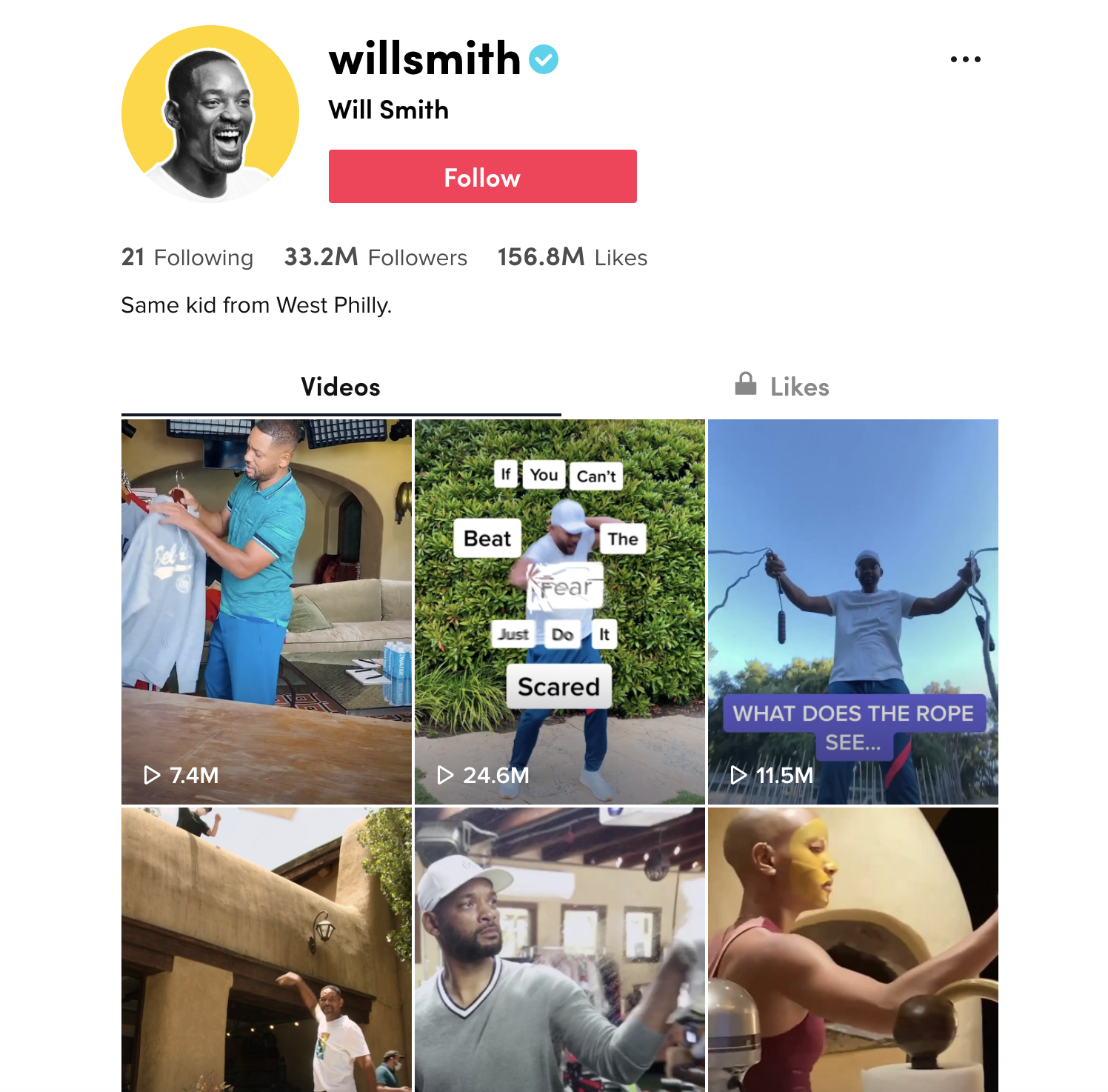
Notice that there’s no real mention of upcoming movies. If there is any promotion, it’s subtle and not the main focus. What’s really being promoted here is the brand of Will Smith. You can do the same thing to market your blog’s brand as a more high-level entity than just an individual blog post.
How to Grow Your TikTok Audience
Growing your TikTok audience means getting more people interested in your brand. But how do you get people to notice your TikTok? Here are a few ways to get you started:
- Join or start a TikTok challenge: There’s almost always some kind of TikTok challenge circulating on the app. Many of the challenges are started by ordinary TikTok users. These might be challenges to ask your partner a question and see how they react, or it could be a challenge to dance to a song that’s trending on TikTok. Businesses and brands will also start their own TikTok challenges. Colgate did a #makemomsmile campaign around Mother’s day to promote their toothpaste. Chipotle has started several campaigns on TikTok including the #guacdance and the #chipotlelidflip challenge. These campaigns can help reach new audiences and get people interested in your brand.
- Connect with other TikTok influencers: It’s common for TikTok users to collaborate with other people on TikTok. Sometimes this is done through TikTok duets—videos that appear side by side and can look like they’re interacting with each other. Other times it means TikTok users meet up in person to make joint videos. To grow your audience fast, it’s a good idea to network with people who are already really popular on TikTok. These influencers will give you a leg up and help give your account more reach.
- Spend time on the TikTok app: The best way to learn TikTok is to spend time watching videos on the app. This is the easiest way to see what’s trending and what people respond to. Jumping on the bandwagon of whatever is trending on a particular day is actually encouraged on TikTok, but just remember to add your spin on whatever the new trend is.
Keep in mind that TikTok is still constantly changing, as it’s one of the newest major social media platforms out there for experimenting in your blog marketing efforts. For example, during the summer of 2020, the U.S. government took issue with the fact that TikTok’s parent company is based in China and threatened to remove the app from American-owned app stores. All of this isn’t to say TikTok shouldn’t be a priority for your blog marketing strategies, but that you’ll just want to expect a measure of unpredictability with the platform for now.
5. Use Your Blog’s Layout to Make Your Blog More Marketable
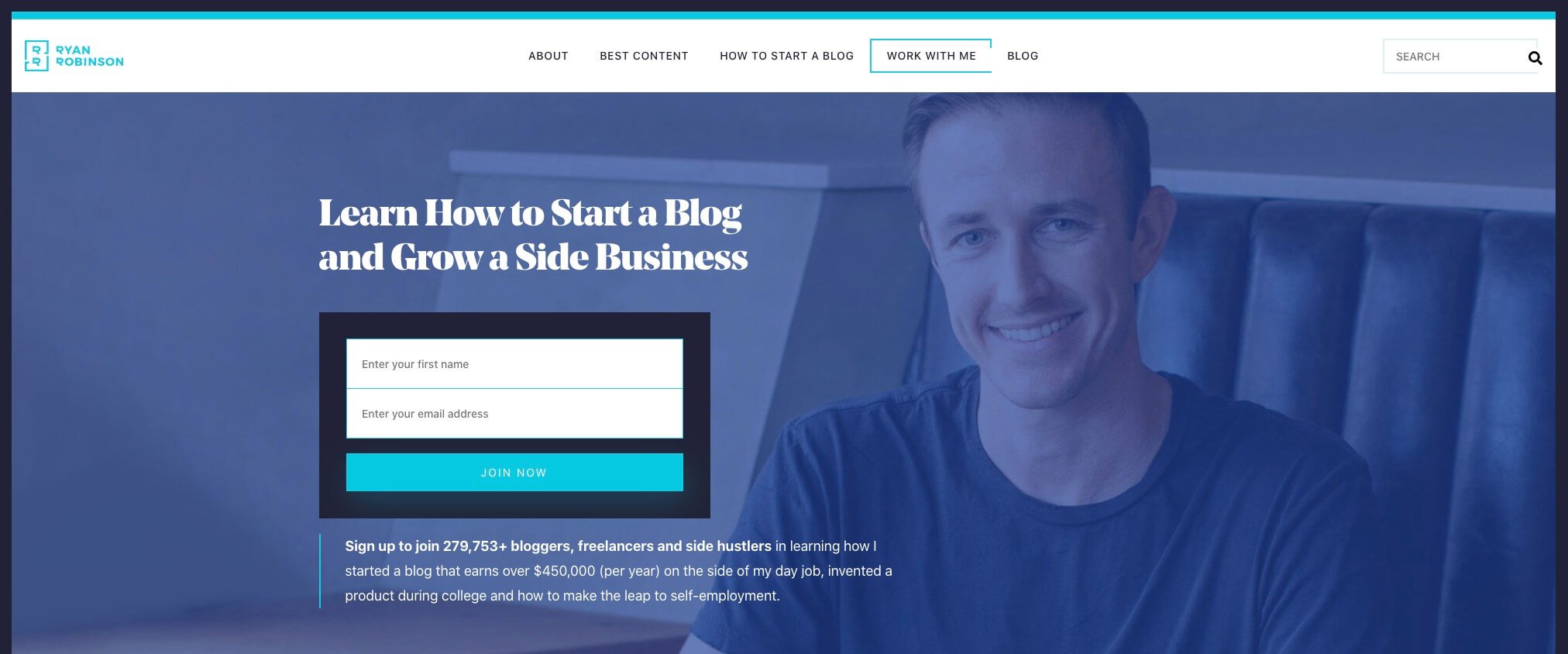
The design of your overall blog layout may not seem like an important aspect of your blog marketing plan, but it plays a larger role than you might think. Blog marketing isn’t just about attracting people to your blog—it’s also about convincing them to stick around once they arrive. A smart blog layout will help keep people on your blog and lower your bounce rate.
Here are some of my tried and true best practices for making the user experience better for readers on your blog, which will help lead to stronger conversion rates, more repeat visitors, and a more marketable blog overall.
Use a Design That’s Clean and Easy to Scan
At the center of my own blog design, I like to use a lot of white space to keep my reader’s eyes focused on the text and images on my blog. This clean design makes it easy for people to navigate my blog and find important elements without being visually distracted.
I also make sure that all of my blog posts are easy to scan. That means using a lot of headers and cascading sub-headers. This practice makes it a lot easier for people to decide whether or not an article answers their questions. For longer articles, I also make a clickable table of contents (like the one you’ve seen near the top of this article and scrolling along with you in the sidebar if you’re on a desktop computer), so that readers can go directly to the section they’re interested in.
This is what the table of contents looks like in my guide, How to Start a Blog:
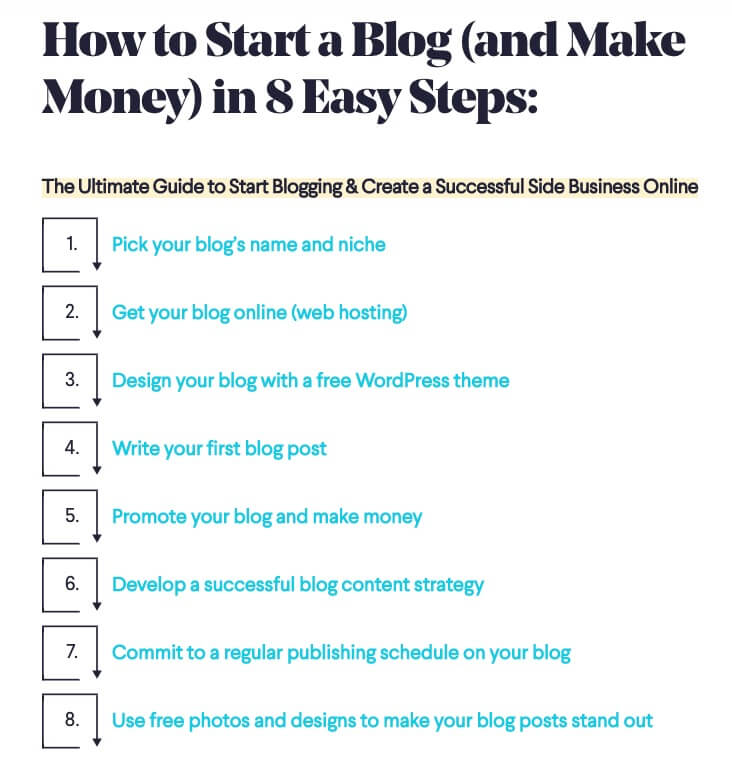
Organize Your Layout for Easy Accessibility to Other Parts of Your Blog
One way to lower your bounce rate considerably is to make it very easy to navigate around your blog. There are several ways to do this, but a top and bottom navigation menu is an excellent place to start. Here’s my top navigation menu:

And here’s my footer navigation menu, which offers up key links to additional reading I want my readers to check out:
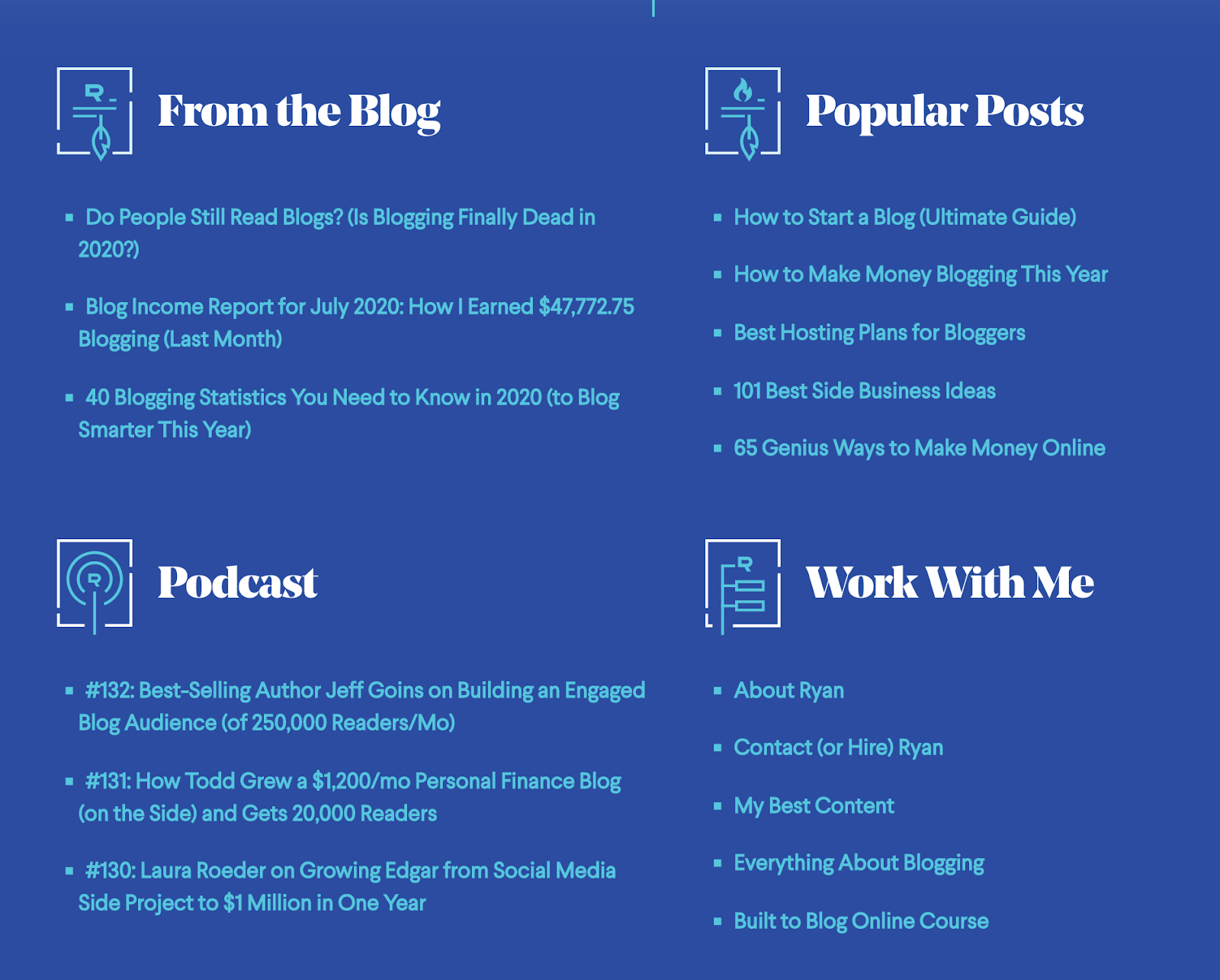
Every page on my blog includes this same helpful navigation information‚ with the top menu linking to my best content, my guide to starting a blog, my about page, my contact page, and my blog roll. At the bottom, I give even more specific directions with recent blog posts and podcasts, my most popular posts, and links to pages about working with me.
In addition to the top and bottom menu bars, I also make sure that each blog post I write contains many (relevant) internal links. Including these links brings more value to my blog posts, and leads to a lower bounce rate overall—plus, it’s a core principle of effective on-page SEO best practices to help boost the authority of your blog posts.
Remember that the longer people stay on your blog, the more Google thinks your blog adds value (which means a higher ranking in a search). More time spent also means more time to lead to conversions like email subscriptions or purchases through affiliate links.
Easy to Identify Branding to Help Better Market Your Blog (Visually)
Branding is a marketing and blogging term that refers to the way that you present your business (or in this case, your blog), largely from a visual perspective. Your branding may include a well-designed logo, a unique color scheme, a slogan, or highly developed graphics.
In other words, when people come to your blog, they should be able to identify your particular branding. Your branding distinguishes you from other blogs, it adds personality and (when done well) can even be a standalone blog marketing strategy that brings in readers who resonate with your brand.
Take a look at the visual branding for The Verge, a blog all emerging technology and how it affects the mainstream community:

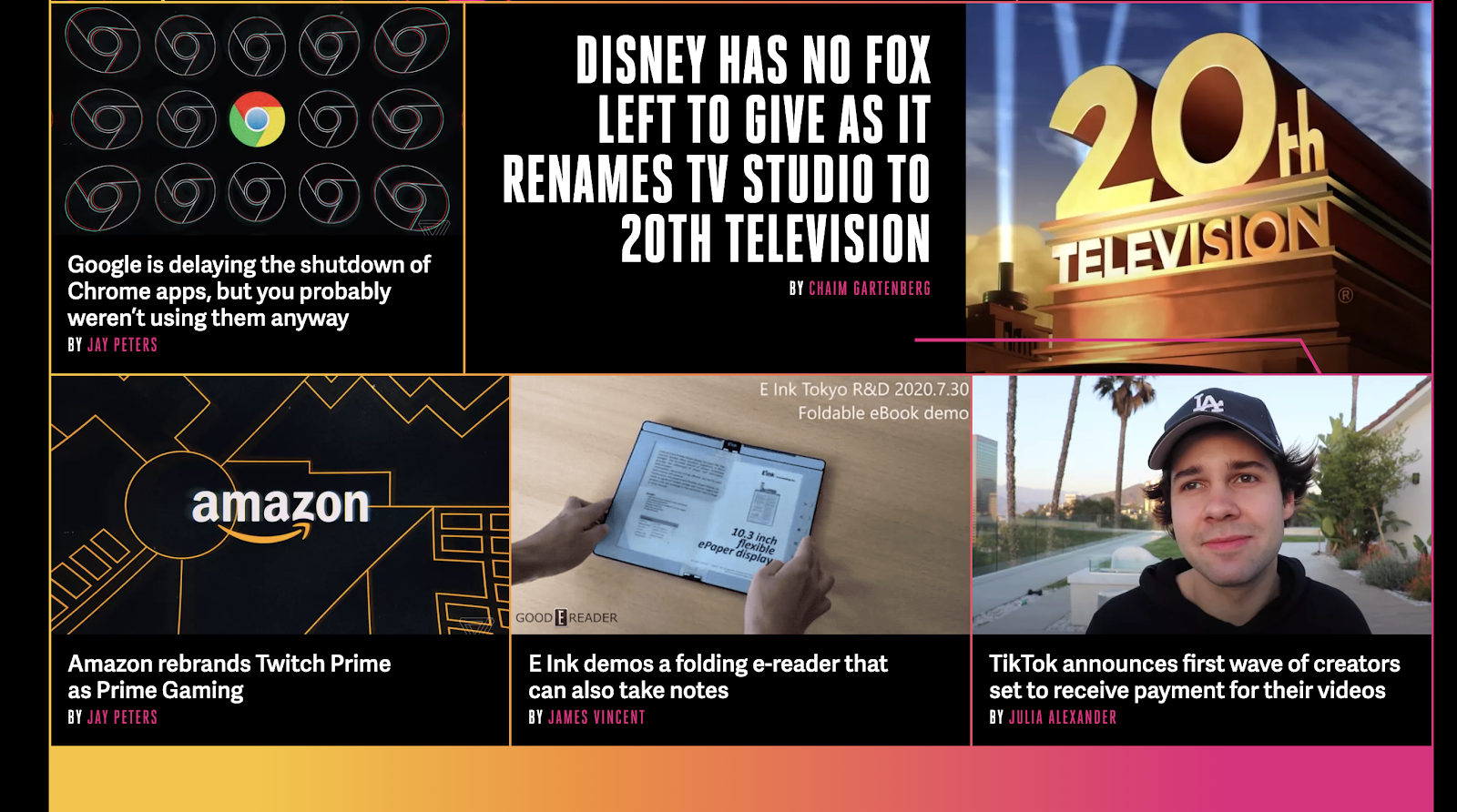
The fonts, colors, and images are all very easily identifiable—and geared particularly toward the audience of readers who are interested in emerging technology. It looks like a design straight out of the 1980s while still maintaining a modern feel as well. As soon as you land on their blog, you can’t help but notice that their design is pretty uncommon and unique to them.
If you were to see their name or logo elsewhere, you’d probably recall their website and the kind of content they offer—just like seeing the Coca Cola logo makes you think of an ice-cold drink, and the McDonald’s golden arches make you think of hot salty fries.
For more tips and actionable strategies for creating an effective blog layout (including the exact themes, plugins, fonts, and visuals I use), check out my guide: 12 Blog Layout Examples (and Best Practices), and see how these 18 blog examples are creating profitable online businesses today.
6. Make Your Content Easy for Readers to Share
Word of mouth is another aspect of fundamental blog marketing that’s extremely underrated. Think about it—as bloggers, we should make it as easy as possible for our readers to tell others about our blogs, right?

If you were to instead have an in-person business, you’d hope that people in your local community would tell each other about the excellent product or service you provide. If you had an auto repair shop, you’d want everyone in town with a car to tell their friends and neighbors that you have the best service around.
Blogging is no different, with the exception that most referrals happen online—and many of them happen across social media platforms, hence why optimizing for these kinds of referrals rolls nicely into your blog marketing efforts. So how do you make sure that you’re getting as many referrals as possible to your blog?
Of course, writing great blog content (and knowing how to outline a blog post) are two of the first steps to making sure you’re addressing your audience’s core needs, but once you know your content is useful—how do you get people to share it with their social media communities and tell their friends about it? The answer is, to make it extremely easy for people to share your content online.
Add Social Media Share Buttons
One way to make it easy for people to share your content (and make your blog marketing efforts that much easier), is to add social media share buttons.
I make my content easy to share with the Better Click to Tweet plugin for WordPress. Better Click to Tweet allows me to take a sentence, quote, or phrase and turn it into a clickable graphic that people can easily share on X with just one click. Here’s what the click to tweet widget looks like in my guide about How to Write a Blog Post here:
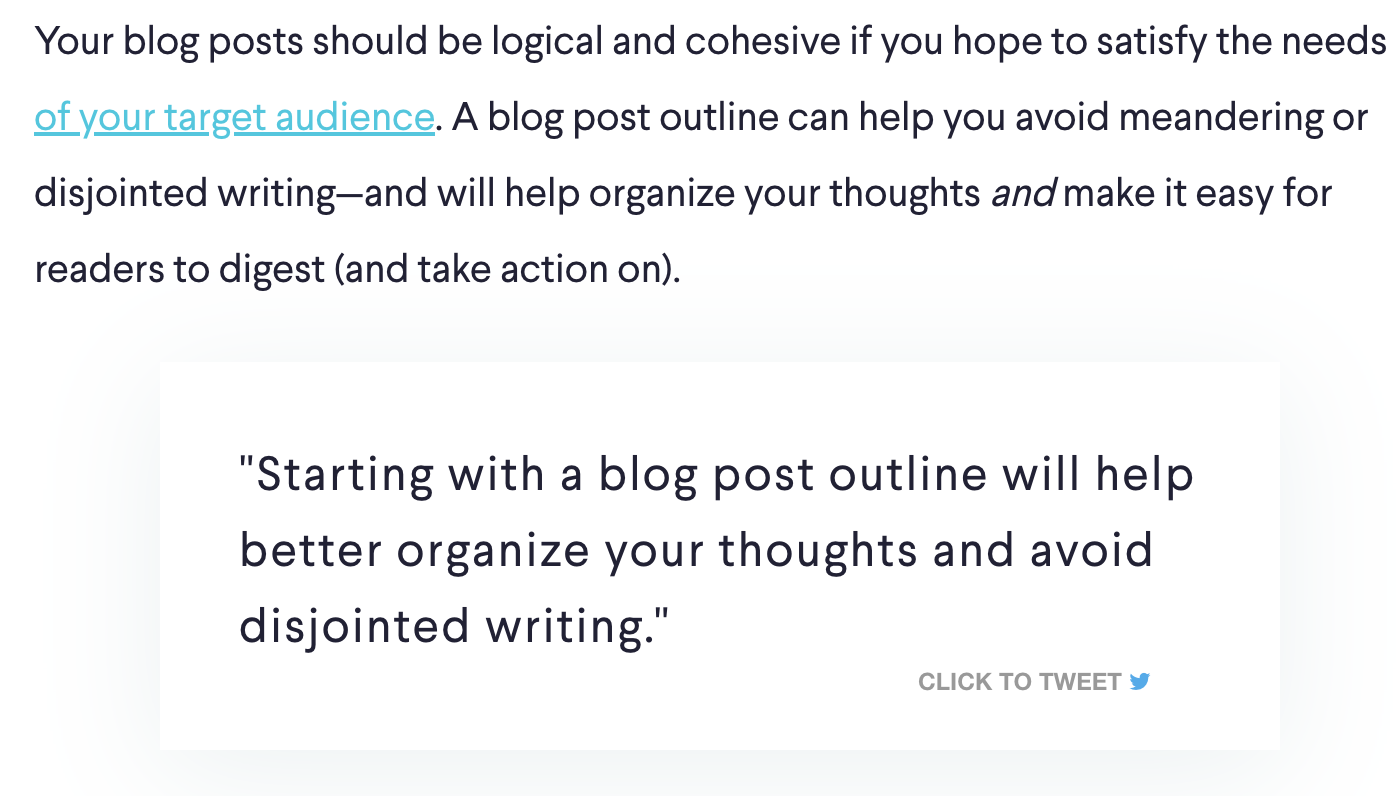
This way, if someone likes that particular quote, they can easily click that link and share it with their followers on X right away.
You can implement this same blog marketing strategy with Pinterest, too. A lot of people use a free WordPress plugin like Pin It to add discrete “pin it” buttons on top of their images, to encourage people to share their images (and blog posts) to Pinterest. You can see this in action over on the Wonder Forest Blog right here:

You can find easy click-to-share buttons and widgets for any social media platform of your choice, but the main takeaway is to remove any obstacles that’d keep someone from taking the next step to share something you’ve posted—and to show them a one-click button that makes your blog marketing that much easier.
7. Network in Your Blog’s Niche and Make Real Connections
If you want to succeed in almost any type of business (especially blogging)—you should invest time into building real, meaningful relationships, often referred to as networking.
While I’m not personally the biggest fan of the word networking, as it implies a shallow and transactional relationship, it’s nevertheless something that can be used to forge deeper, mutually value-driven relationships that open doors for you, get people interested in what you’re creating and gives you opportunities to learn from people who are more experienced than yourself. My roundup of blogging tips and business advice are two great examples of blog networking in action:
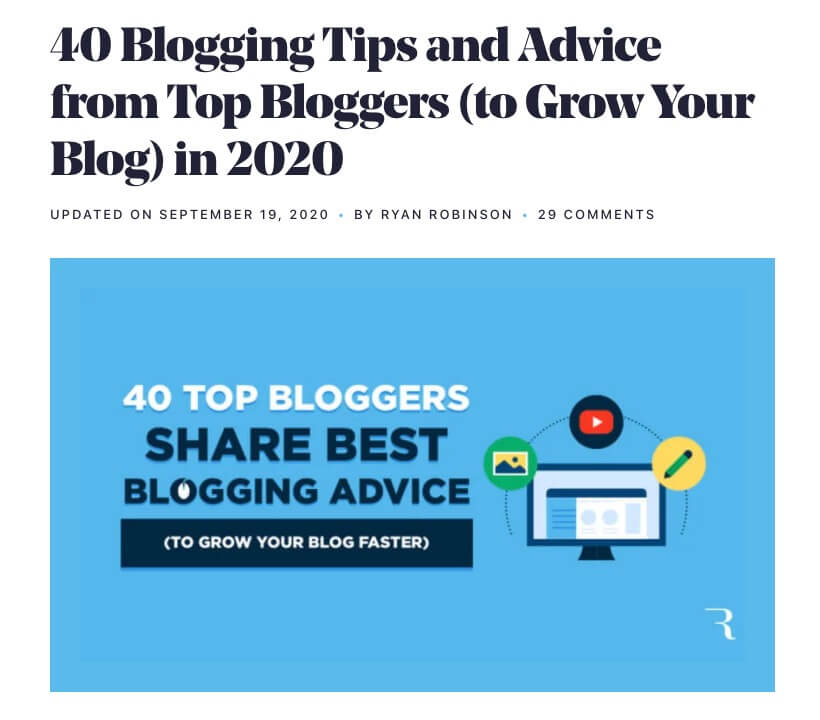
Meaningful networking has been foundational to executing my blog business plan, and it’s something that can help market your blog over the months and years to come, as well. Now, let’s dig into some of the ways I’ve used networking as a core blog marketing strategy.
Find Influencers in Your Niche on Social Media
Social media is an easy first step for finding people in your niche who are already influential members of the community. All of the major social media platforms can work for networking, it’s more a matter of picking which channel will be best for you and your blog’s niche.
- If you run a blog about business and finance, you’ll find some of your best connections on LinkedIn or X
- If you have a blog about fashion, Instagram will likely be your best platform
- If you have a blog about news and politics, X will be your platform
- If you’ve started a food blog, prioritize evaluating Instagram and Pinterest
While the possibilities for networking are somewhat endless in nature, the important thing to remember is that you should spend the most time on the social channels where your audience already exists. That’s where you’ll get the most return on your blog marketing efforts.
Once you do find the right influencers in your niche, start by following their accounts. Leave relevant comments, ask intelligent questions, and give them meaningful feedback in the comments section of their blogs too. As you interact with their content, you may be opening the door to new connections with people who are already doing well in your niche—these are the people who can help amplify your work in learning how to market your blog.
Reach Out to the People You Mention in Your Blog Content
One thing I routinely practice is contacting everyone I’ve mentioned in a recent blog post, to let them know that I included them in my content and encourage them to check out what I wrote. You can help market your blog by tastefully mentioning influencers in your content—and then sending them a link to the blog post that featured them.
From my guide to doing effective blogger outreach, here’s a screenshot of that feature notification email in action, where I also asked to contribute a guest post to their blog:
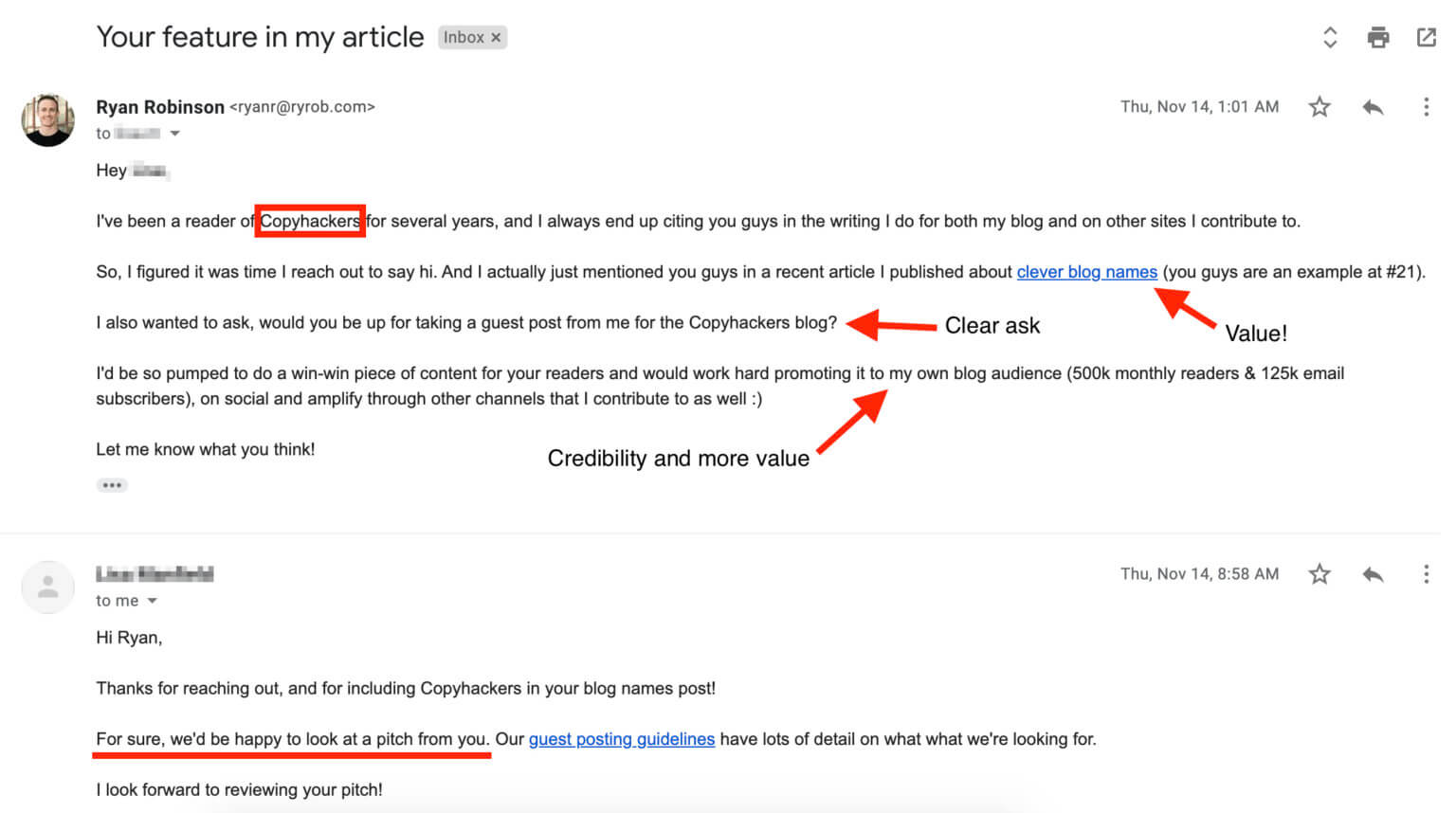
This doesn’t take a lot of effort, but it can be a very effective blog marketing strategy, especially for the relatively little effort it takes to execute. Don’t feel like you need to write a novel in your email to each influencer, either. In fact, shorter is often much more effective—a quick heads up, a link to the blog post and a quick callout of where they’re mentioned can be enough reason to reach out and let them know.
When you send an email to an influencer, consider asking them if they’d be willing to share your article with their audience. Make it simple for them to do so by providing a quick link (and a pre-written sample tweet) that they can easily share.
Be open to the possibility that they may not be interested in sharing your article, but you’ve already taken a strong first step in creating a value-driven relationship with an influencer in your niche. Over time, you may be able to develop a mutually beneficial relationship by continuing to mention them both on your own blog and in guest posts you write elsewhere. Continue providing value and investing in the people who can make the greatest impact in helping with your own blog marketing progress, and it’ll eventually pay great dividends.
Become a Guest on Podcasts and YouTube Channels
As bloggers, it can be easy to forget that not everything is about the written word. You should also network using other forms of media like podcasts, video content, webinars, and livestreams (and other channels that mesh well with the people in your niche).
If you know someone with a relevant podcast or YouTube channel that could help with your blog marketing efforts—ask them if they’d be interested in having you as a guest, taking care to note that you’ll of course promote the event to your blog audience, too. Take for example an interview I did not too long ago on the wildly popular, Tropical MBA podcast, which highlighted some of my top blogging strategies and served to significantly boost my visibility in my niche:
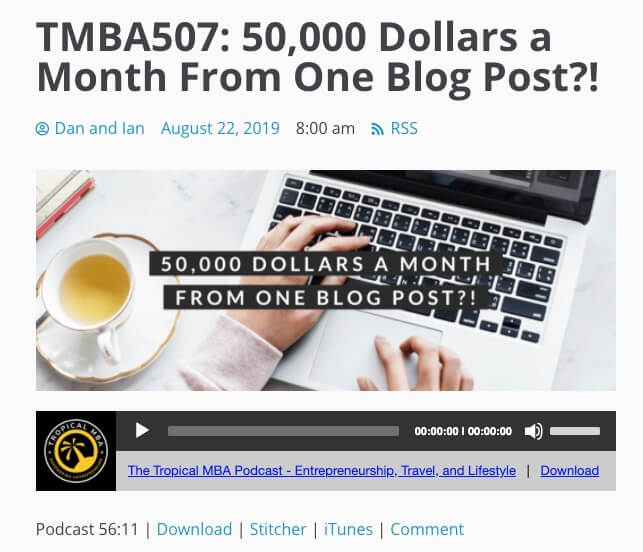
That single podcast interview has gone on to directly impact my revenue—fueling a surge in new email subscribers, new members joining my Built to Blog course, a spike in subscribers to my podcast, and a lot of general buzz around what I’m doing with my blog. Never underestimate the blog marketing possibilities of what a podcast interview or YouTube video collaboration can do to expand your reach.
Just remember that before you go on a podcast, prepare ahead of time based on what the episode will be covering, so that you can deliver impactful advice & insights. People are going to be listening to see how well you know your stuff, so arrive ready to meet the moment.
Host Thought Leaders in Your Niche
You can be a guest on other people’s podcasts and YouTube channels, but you can also start a podcast yourself—and host your own show. The more influential the guest, the more audience you can draw (especially if your guest shares about the episode once it’s published). Take for example these video interviews I did with highly influential people in the sales & marketing space:

This tried and true blog marketing strategy, asking guests on your own blog, podcast, or YouTube channel—is often flattering to the guests and they’ll usually be excited to promote their appearance on your show. Just be sure you have a reasonable amount of value to deliver them in terms of reach (how many people will hear or see their interview) and the effort you’ll be putting in to promote the episode. I’ve hosted many different voices on my podcast that have in turn helped grow my own audience, like:
- Josh Strebel: The WordPress monthly hosting plan pioneer behind Pagely
- Brian Dean: The famed blogger and SEO expert behind Backlinko
- Jory MacKay: An award-winning writer and creative blogger
- Tom Morkes: The celebrated army veteran and online business owner
Each of these podcast episodes tapped into a unique story that could relate to different segments of my audience and simultaneously served as blog marketing vehicles that the guests promoted, too. If you don’t have a podcast, another way to host thought leaders on your blog is to do a roundup post of quotes from influential people that you’ve either gotten from them or found elsewhere online. That’s exactly what I’ve done with my roundup of business advice and tips for success here:

When you share these types of posts or include influential guests on your podcast, you’re sharing your audience with them—and they’re (ideally) sharing their audience with you by promoting the content once it goes live. I love this blog marketing strategy so much because it’s another example of a win-win-win where everyone gets something of value out of the equation.
Co-Host Webinars with a Brand or Blogger
Another way to network and create valuable content at the same time is to co-host a webinar with another blogger, influencer, or brand in your space. Your combined audience will come together, and you can deliver a presentation, answer questions, or just talk about a relevant subject to both audiences at once.
As a quick recap, if you’re not familiar, a webinar (or virtual summit) is an online event that often has a Q&A session and presentation component to it. You can share your expertise, and your guests can share theirs too. If they have a larger audience than you, it’s a good way to show that you also have authority in your niche, and it’s a good place to market your blog from a branding perspective.
You don’t have to limit yourself to other bloggers either, often I’ve found that notable brands in your niche are more than willing to co-host a webinar (and the results can be even more impactful). It’s a good way to show off their product or service to your audience and still provide something useful to everyone who shows up.
8. Use Email to Market Your Blog and Get Repeat Visitors

Email marketing has long been synonymous with growing a successful blog business. As a result, most blogs have at least a few ways to collect email subscribers (be it through the promise of a weekly advice column, notifications about new content, a free course, a lead magnet, or otherwise).
Why is email marketing so impactful for most bloggers? Because it helps gather a group of highly engaged people together in one single location. People intentionally opt-in to join your email list (and can unsubscribe at any time). What’s important though, is that they’re part of your email list by choice, which means they’re already interested in your work—and your emails can keep them interested in your blog, drive traffic back to new content, and (likely) serve as the first paying customers for any products or services you decide to launch.
Gathering email subscribers and keeping them engaged does take time and effort though, so let’s walk through some of the ways that you can use email as a core blog marketing strategy today.
Optimize Your Blog For Collecting Email Subscribers
Your blog is the perfect place to collect emails through email capture forms, like this one right here on my blog’s homepage:

There are many different WordPress plugins and blogging tools out there for collecting email subscribers, but I absolutely love ConvertKit’s HTML/CSS code snippet that integrates easily (often by pasting a single line of code) into just about all of the major WordPress themes on the market today.
How and where you collect emails on your blog is a matter of opinion, of course. At this point, I no longer use distracting pop-ups to grow my email list, but that’s a very viable way to capture email subscribers—it just comes at the cost of adding more code to your pages (which will load a little slower) and an arguably less pleasant user experience for readers. Other places you can place an email sign-up form include your:
- Header
- Footer
- Within the introduction of your blog posts
- Dedicated landing pages for lead magnets (try Unbounce to create high-converting landing pages)
- At the bottom of each blog post
- Exit popups (these can cause some frustration with readers, so use them with caution)
There’s no limit to where relevant email sign-up forms can be placed around your site, just be sure that they’re adding value and making a contextual offer that both achieves your blog marketing goals and delivers value to your readers, in exchange for their email addresses.
Grow Your Email List With a Lead Magnet
A lead magnet is simply something that you give away for free, to encourage people to take action (like signing up for your email list). Here’s an example of one here on my blog:
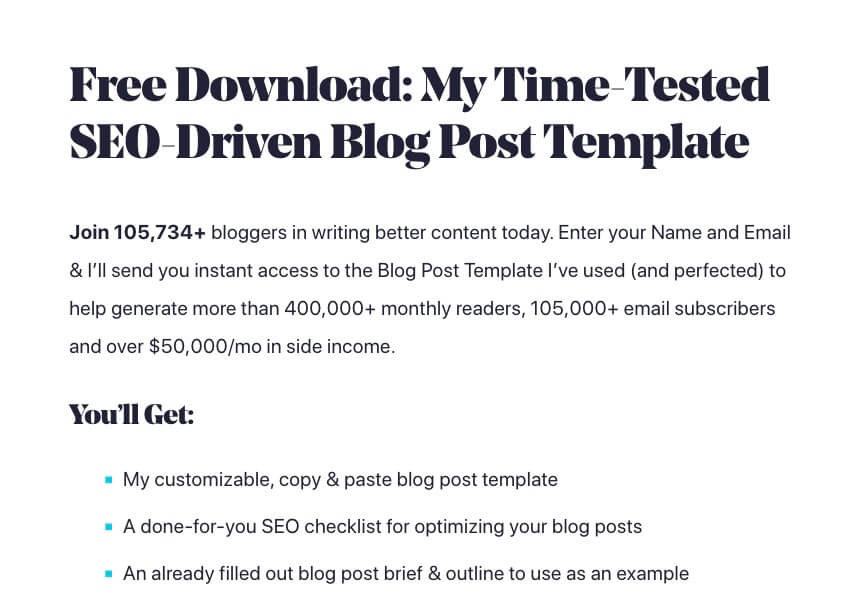
We already mentioned lead magnets briefly above when talking about ways to do smart blog marketing with Facebook—but your blog should really be the primary destination to use lead magnets. Here’s a short list of some of the most successful lead magnets I’ve used to grow my email list here on my blog:
- Free worksheets and fillable documents (like my blog business plan template & worksheet)
- Free courses, whether delivered via email or video (like my free course on building a blog)
- Free templates (like my blog post template and editorial calendar template)
- Free eBooks (like my two free blogging books)—be sure to read my guide about how to write an eBook too
- Free consultation calls that I offer from my contact page
- Discount codes or special offers for joining a course or purchasing a book
Pick a Reliable Email Service Provider
As you collect email subscribers, you’re going to need the right email service provider (ESP) to deliver content to your subscribers. An ESP (like ConvertKit) offers email services that make it easier to both collect email subscribers and send out email campaigns to your subscribers—and some offer a high degree of individual targeting based on the specific actions a subscriber has taken on your site.
In my opinion, there are three main contenders when it comes to choosing an email service provider for your blog marketing efforts:
Either of these three would be a solid choice for managing your email marketing (and I have an in-depth comparison here: ConvertKit vs AWeber vs Mailchimp), but for those who are just starting out and need a tool that’s 100% free, I recommend using Mailchimp’s service. You can collect up to 2,000 email subscribers for free with Mailchimp, which is a good way to transition into experimenting with email in your blog marketing mix.
Once your subscriber list approaches 2,000 or so people though, I’d highly recommend making the switch to ConvertKit, where you’ll unlock all the email marketing features you’ll need to grow a profitable business around your blog:
Some of my favorite features that come with ConvertKit include:
- Visual automation and timed email sequences
- Organizing your subscribers with tags and segments
- Easy to embed sign-up forms and landing pages
- Email editing with a built-in design tool (or HTML options)
Again though, for a more thorough review of these different email service providers, check out my guide: ConvertKit vs AWeber vs Mailchimp.
Increase Your Email Open Rate
Sending emails to your audience won’t do much in terms of your blog marketing if they’re not opening those emails. That’s why it’s worth your time to learn how to increase email open rates with your subscribers.
The first step to getting a high open rate is to build trust between you and your audience. If you’re constantly emailing content they aren’t interested in—they’re never going to open your emails. If pushed far enough, they’ll take the next natural step and unsubscribe.
To avoid annoying your email list, limit the number of emails you send. If you start showing up in their inbox every day—even if they have an interest in your topics—there’s a much higher chance that they’re going to kick you out of their inbox. In some cases, many people get hundreds of emails a day, which can be overwhelming and even stressful.
So write only when you have something worth sharing, like special offers that are only for subscribers, or to alert them when new content goes live on your blog. Side note—you can avoid spam filters with DKIM to have better outreach and develop your email marketing for the long term
Here are a few actionable tips for improving your blog marketing through great subject lines that’ll encourage more clicks in your emails:
- Avoid spammy words like special offer or limited time (things that you traditionally get from people trying to sell something)
- Use personalization whenever possible
- Experiment with including emojis if your audience resonates with that
- Don’t be vague, but still appeal to their curiosity
- Avoid using all caps (or serial caps, in my opinion)
- Use numbers like “5 clever ways to start a business this weekend”
Write Emails That Get High Click-Through Rates
What leads to high click-through rates with your email campaigns? Simply put, write something your subscribers will want to read. You have to earn your spot in their inbox, so only email when you have something worth sharing. You’ll learn over time what your target audience responds best to, so a little experimentation is necessary.
As you’re learning more about your readers and your blog marketing efforts get more dialed in, here are some ways that you can increase your click-through rate for your emails:
- Think about your email design: An email that’s clunky, text-heavy, or unattractive won’t lead to many link clicks. Instead, make your emails appealing and easy to scan. ConvertKit (and other ESPs) includes several templates to help make the design more user-friendly.
- Include a clear call-to-action: If you want people to take action from your emails (which you do), be clear in your message about the exact action you want them to take.
Here’s an inside look into what my own blog marketing emails look like. Mine are usually very simple—I don’t even include images—but if you’ll notice, I include two to three links in most of my email campaigns. I have a link at the beginning and the end of the email when I’m sending out a new blog post. Then in the middle, I sometimes add a link to my blogging course:
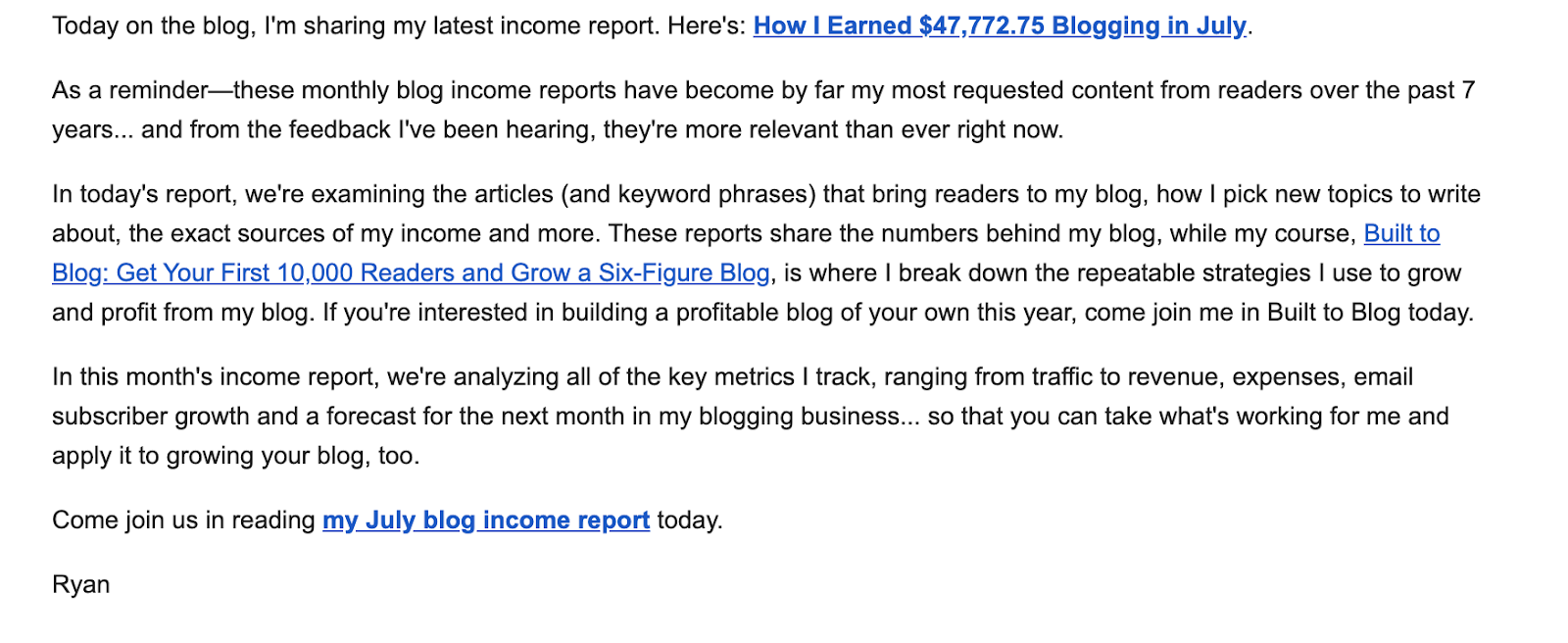
The last link includes the most straightforward call-to-action when I write, “Come join us in reading my July blog income report today,” which is as simple as it gets.
- Offer answers to pain points: In a recent email I sent to my subscribers, I promoted a new blog post talking about how to write an About Me page for your blog. Here’s what it looked like:
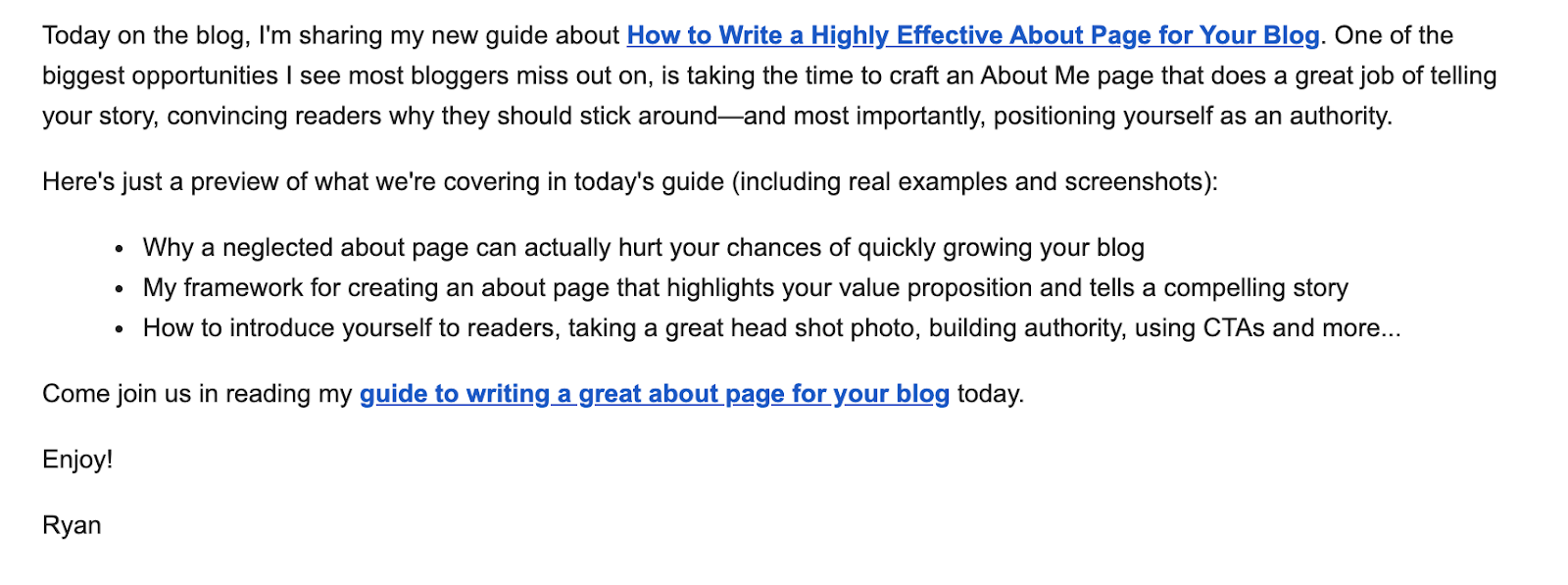
The implicit pain point of my subscribers, is always how they can create and maintain a successful blog. So, in my email, I point out one way to improve their blogs this week—write a great About Me page. Next, I insert the problem that I see that bloggers have, many of whom don’t use their About Me page to its fullest potential. Lastly in the email, I show how my new blog post will help alleviate that problem and help them improve their blogs.
All emails to your audience should be relatively simple, straight to the point, and deliberate about the action you’d like them to take in the moment. That’s what effective blog marketing looks like.
9. Identify and Learn From Your Competition
Once you’re starting to really understand your target audience, the next step is to study your competition (especially if they’re already well-established in your niche). What’s your competition already providing in your market, and how can you provide either more value—or offer a unique twist that’ll appeal better to a segment of the audience you want to reach? Seek to answer questions that get to the core of your competitor’s blog marketing strategies, like:
- How is your competition marketing their blog content?
- What lessons can you learn from their layout, presentation, social media accounts, newsletters, and more?
- Which content mediums appear to perform best for your competitors? (Written posts, audio, video, or otherwise)
Keep in mind that you can often glean some of the most effective, unique blog marketing strategies from people who aren’t even in your niche. Thinking outside the box can give you inspiration for marketing strategies that clearly work well in other industries, but haven’t yet been applied to your own area.
Now, let’s take a real-life example of effective blog marketing to walk through.
How Detailed Nails Their Blog Marketing
Looking at the Detailed blog, where famed SEO thought leader Glenn Allsop delivers actionable insights on the state of search engine optimization, we can gather a lot of insights around what it takes to effectively market your blog in the SEO niche:
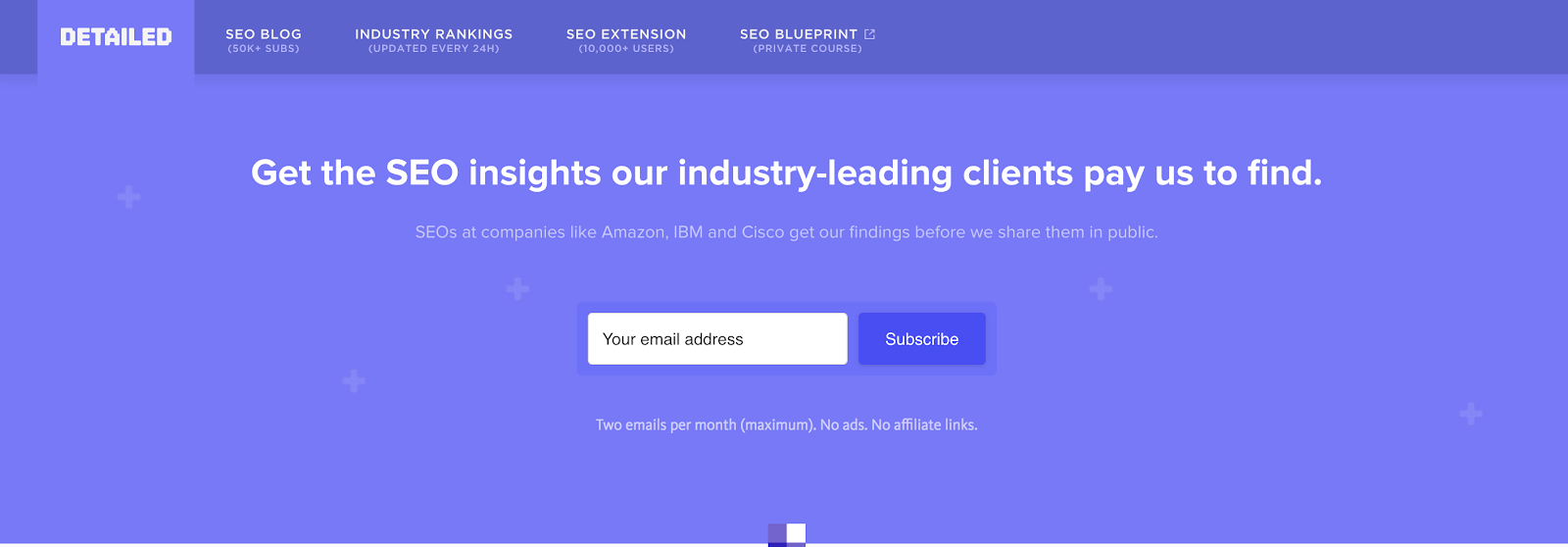
Let’s explore some of the useful blog marketing tactics (some subtle) that Glenn and his team are doing well to market their blog and grow their audience.
They Prominently Highlight Their Credibility
One of the first things Glenn and his team do on Detailed, is to show exactly why people should trust their opinions and research. This is an integral step in their blog marketing plan because there are quite a few SEO websites out there—and cutting through the noise of competing advice can be a challenging task.
First, they share praise from well-known businesses and websites like Yahoo! and Forbes. These brands are unlikely to give a recommendation like this without the Detailed team clearly earning their reputation:

From there, Glenn writes a detailed explanation of how he got into his line of work, what successes he’s had, and what makes him uniquely qualified to give SEO advice:
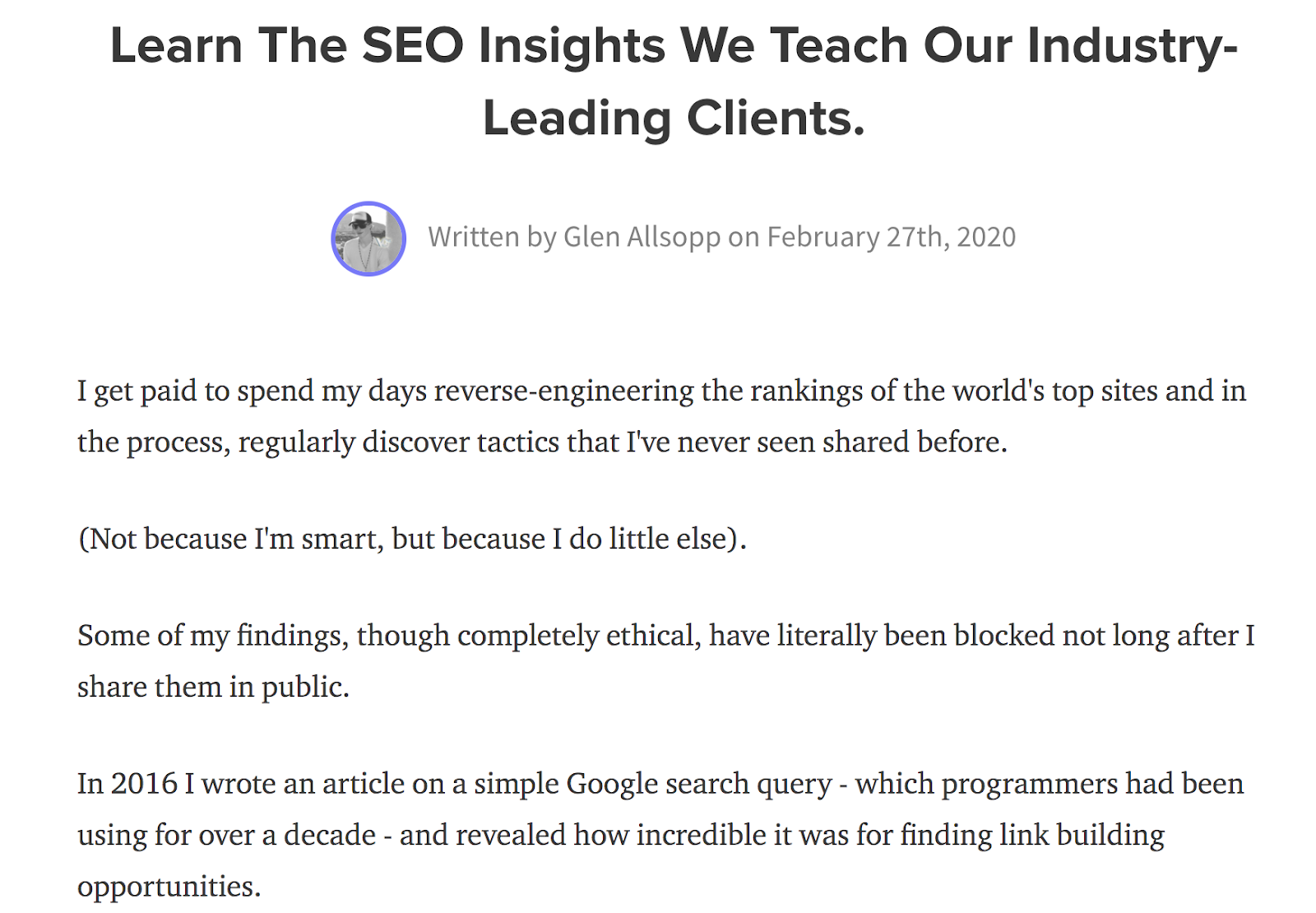
They Explain Why Their Blog is Valuable to Readers
It might seem overly simple, but actually taking the time to clearly lay out an easy-to-grasp case for why your blog is the best destination to learn from, can go a long way in convincing readers to stick around. Glenn and his team do this well by showing what they have to offer. Not only do they offer insights into SEO—they give away some of their secrets to subscribers for free. This is his explanation of why he does this:
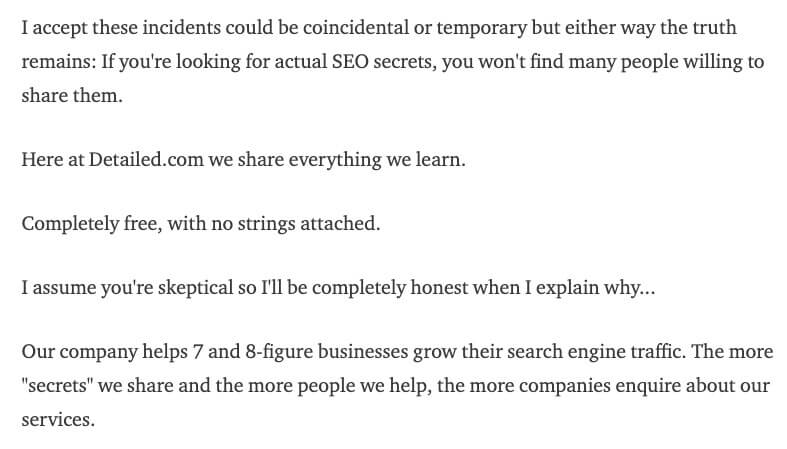
This message, while serving to boost their own credibility, also comes across as genuine, honest, and straight to the point about why they run this site in the first place. Stellar example of blog marketing in the form of effective copywriting.
Their Email-Focused Blog Marketing is Impressive
Another very well-thought-out aspect of Glenn and his team’s blog marketing plan is collecting and communicating with their email subscribers. On the top of their homepage (and blog), they have a section for signing up for their SEO insight emails. This is prominent and right at the top, so it’s impossible to miss when you land on their site, like so:

They give the expectation that they’ll send about two emails each month, and they won’t hit people up with ads or affiliate links in their emails. This is, of course, to show that he doesn’t plan on spamming people’s email boxes. Here’s an example of the email sign-up widget that sits at the top of their blog, taking a more fun approach to attracting sign-ups:
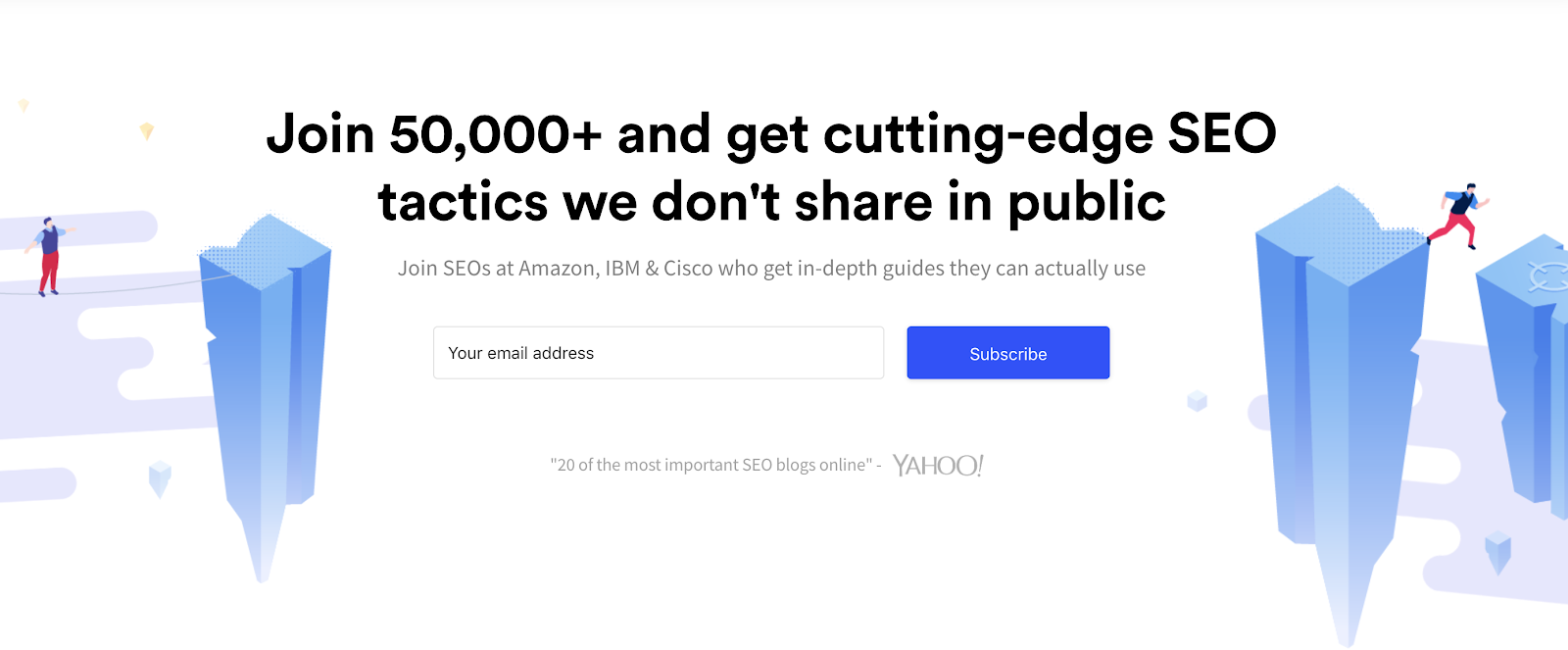
The overall theme of their messaging, in convincing readers to sign up for their email list is very simple & straightforward, but also direct. Again, a fantastic example of how great blog marketing can be done very simply without a ton of complex tools or tactics.
10. Study Your Analytics to Understand What Blog Marketing is Effective
One of the most useful long-term blogging skills you can develop is understanding, interpreting, and pulling actionable insights out of your site analytics. Here’s a snapshot of my own Google Analytics dashboard, for example:
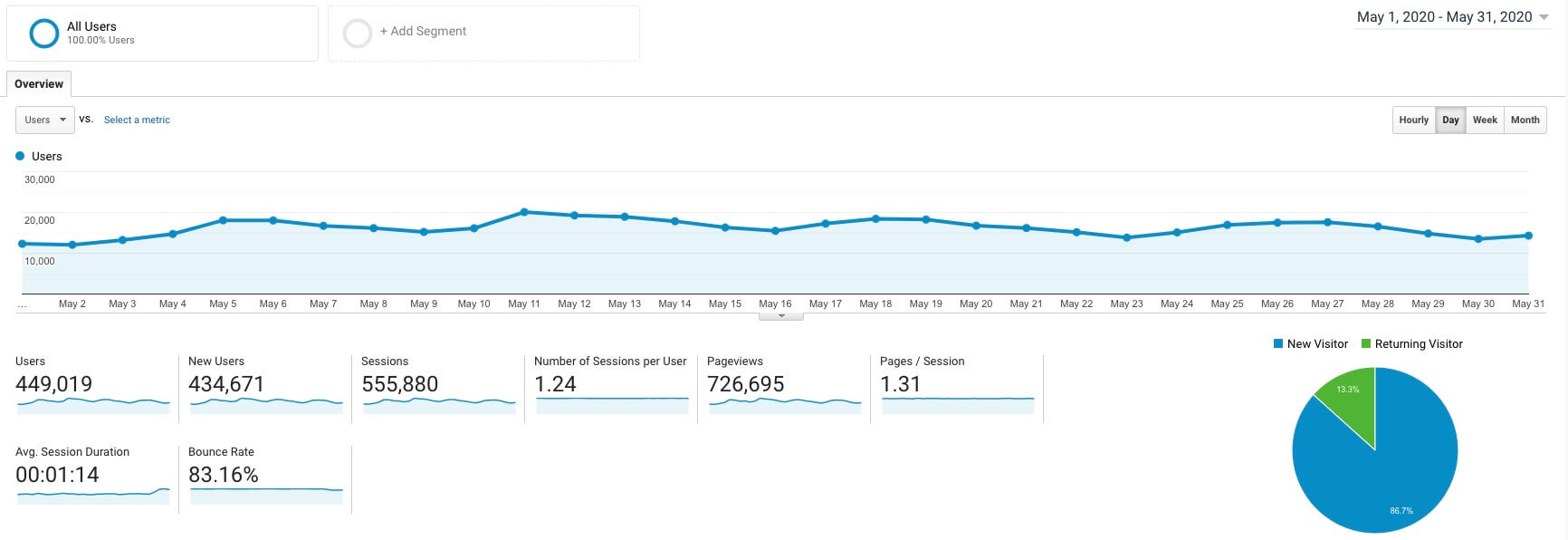
Without analytics, you won’t have a good idea of how well your blog marketing strategies are actually working (or not). Your blog marketing efforts might not be as effective as you think, but you can fine-tune them with useful analytics that provide actionable insights you can learn from.
Get the Most Out of Google Analytics
Google Analytics can highlight extremely in-depth, precious insights into what your readers are consuming, how they’re discovering your content, where they’re coming from, how long they spend on a particular article and so much more. A (very short) list of the high-level insight categories you can learn from Google Analytics includes things like:
- Real-Time visitors: A snapshot of everyone who’s currently on your blog including, where they came from and which page they’re visiting
- Audience: Let’s you know how many people have visited your blog on any given day (it also shares new vs. returning visitors, sessions, page views, and bounce rates)
- Acquisition: This tells you what pages people came to first, the traffic source that brought them to your blog and everywhere they’ve been
- Behavior: Behavior shares every page that people went to on any given day (this list can include internal link clicks too) and much more
- Conversions: You can set conversions in Google and it’ll let you know when you’ve achieved certain goals on your blog
This merely scratches the surface of how you can use the insights proper analytics software provides, especially when it comes to learning how to do more effective blog marketing on a day-to-day basis.
Social Media Analytics
Every social media platform has its own flavor of analytics, but each can be incredibly helpful to understanding your audience on the platform. Take, for example, my recent Pinterest analytics:
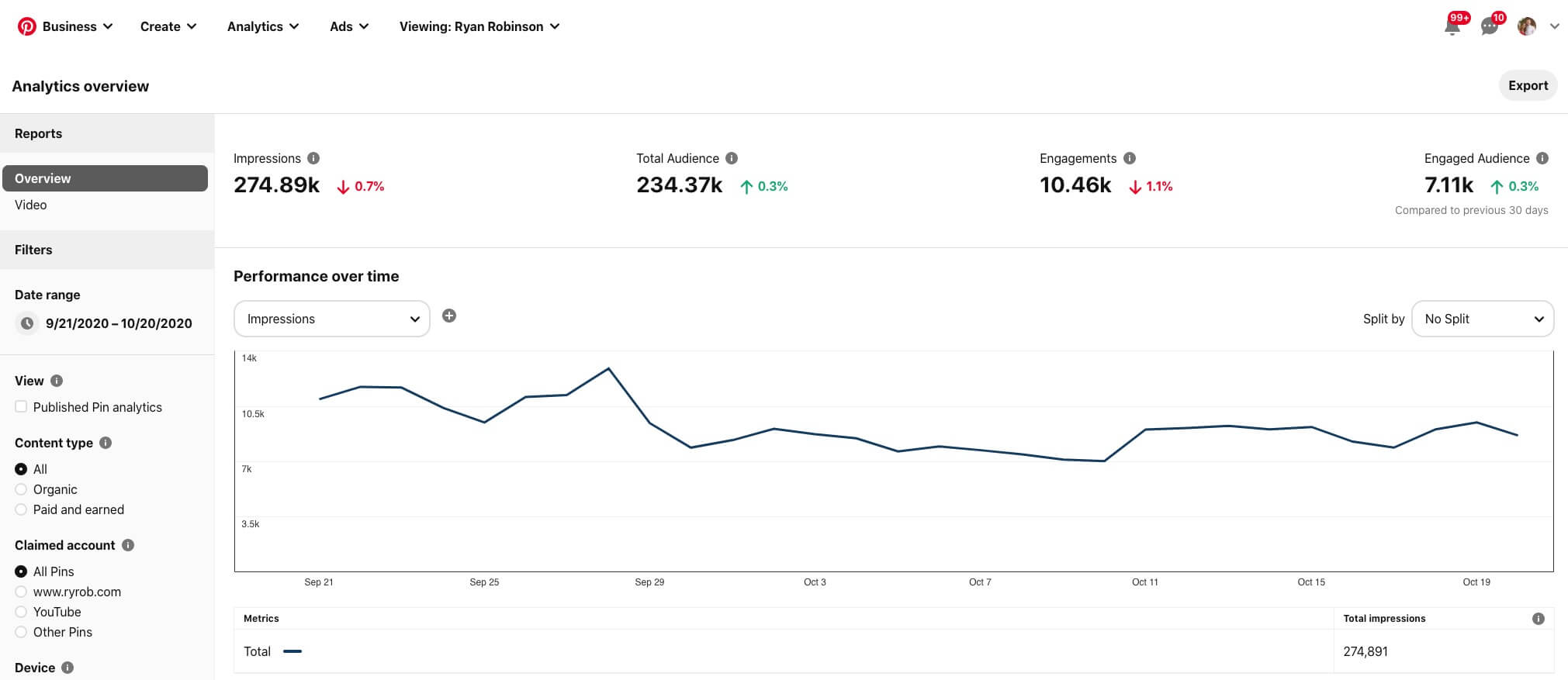
You can learn in-depth things about your audience demographics, total impressions your content is getting, which individual posts are outperforming (create more like that), and gather detailed insights about your follower’s engagement. Many social media platforms also give you insights into how many people click on your blog links—from individual posts or from your profile.
For some social media platforms like Facebook, Instagram, and Pinterest, take note that you’ll have to first sign up for their (free) business accounts in order to gain access to those insights.
Stay Ahead of AI Innovations
Tools like Ahrefs now offer predictive analytics. It’s quite new, but try to stay up-to-date with all the new tech that is coming out, and make sure you utilize it to the best of your advantage. For instance, predictive analytics might help you prioritize topics that are more likely to convert your potential leads.
How Will Your Blog Marketing Strategies Change Today?
Whew, I know this guide is a lot. I did warn you though, by titling it as a true ultimate guide 🙂
I designed this guide to intentionally focus on just ten of the highest-return, most impactful (and repeatably proven) blog marketing strategies that can be applied in any niche—rather than offering up a surface-deep list of 100+ blog marketing ideas with no instructions on how to implement them. My goal is to show you exactly how to get a real return on your time spent marketing your blog.
So with that in mind, I hope this guide achieves that objective and gets you some measurable results on your blog in the coming weeks, months, and years…
Which of these blog marketing strategies will you be experimenting with?
Did I miss any that’s worked well for you?
If you want some feedback on an idea you have, ask away.
Share with me in the comments below, I’d love to hear what you’re going to try on your blog!
And if you haven’t gotten your blog off the ground yet, then head over and check out my in-depth guide to starting a blog today.
Want to Start Your Blog (the Right Way)?
Check out my ultimate guide How to Start a Blog (on the Side).


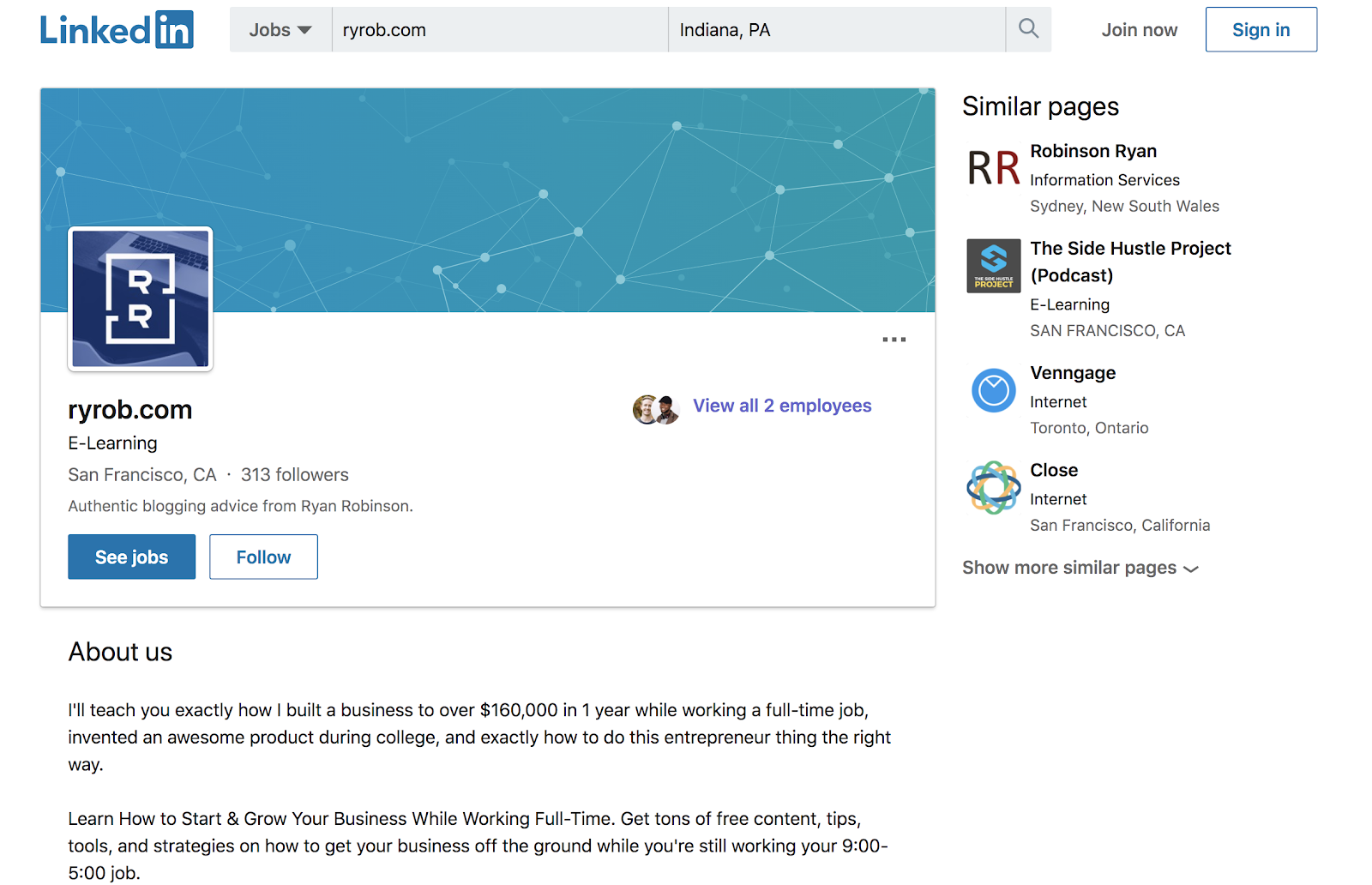
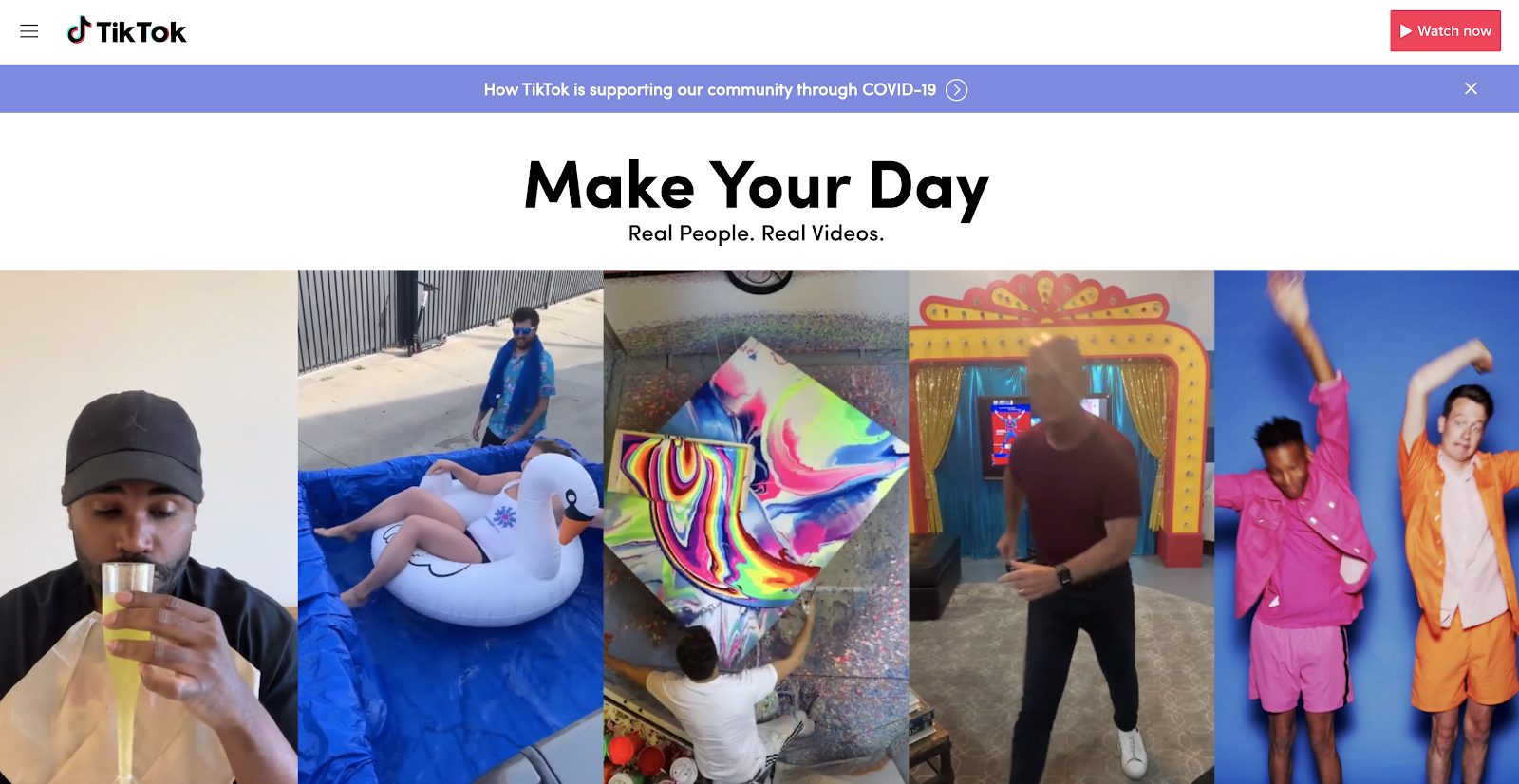
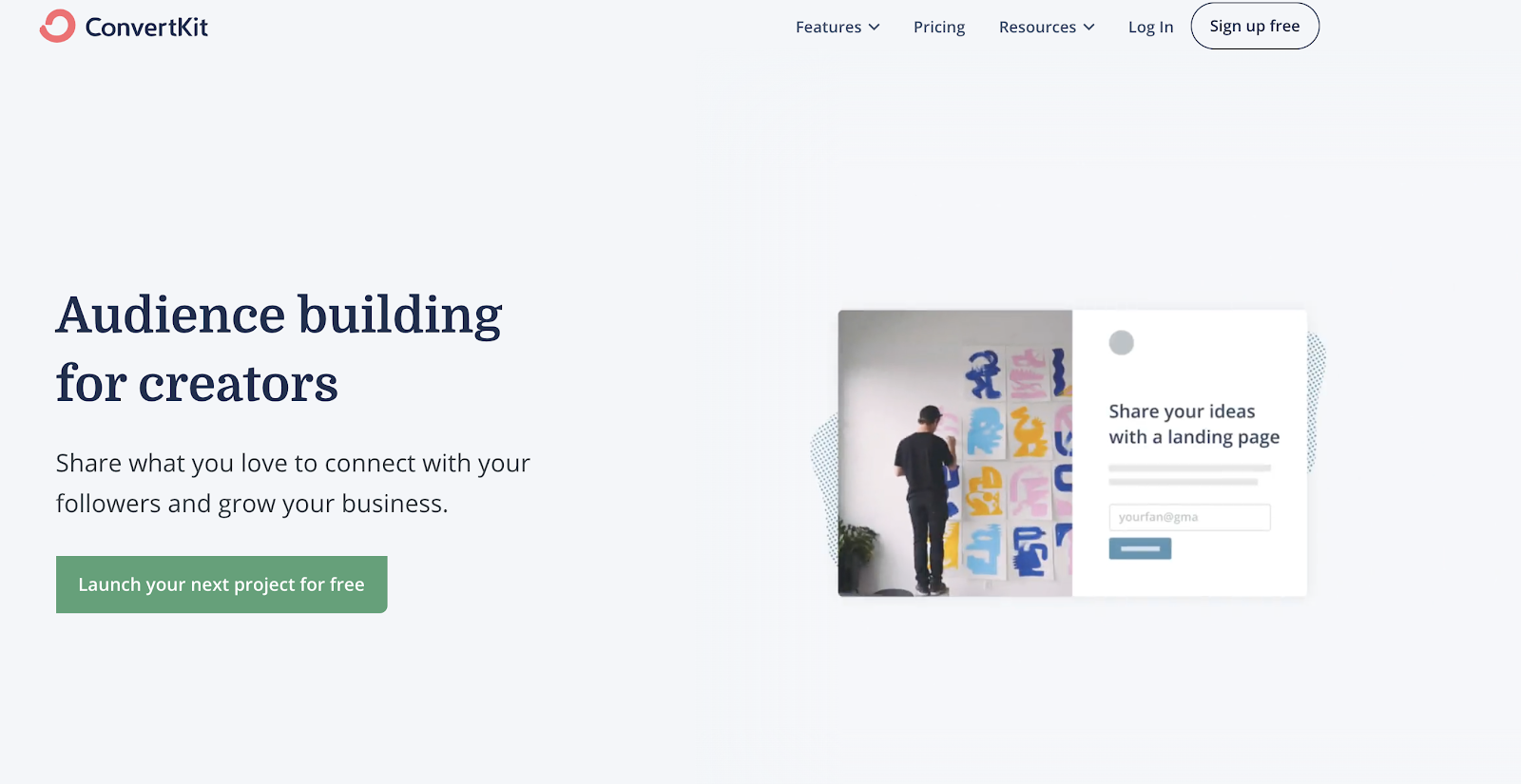
90 replies to “10 Blog Marketing Strategies to Get 584,863+ Readers in 2025 (Ultimate Guide to Marketing Your Blog)”
Thank you for sharing. It is very interesting and helpful for students learning or interested in digital marketing.
Thank you for sharing. It is very interesting and helpful for students learning or interested in digital marketing.
Thank you for sharing this insightful perspective on the challenges bloggers face in transitioning from creating a blog to effectively marketing it to the right audience. Your acknowledgment of the struggle many bloggers encounter in finding and connecting with their target readers resonates with the common hurdles in the blogging journey.
The emphasis on blog marketing as an art that content creators invest significant time in learning is a valuable reminder of the multifaceted nature of successful blogging. Your encouragement to focus on mastering blog marketing, especially when high-quality content isn’t reaching its intended audience, is both timely and appreciated.
Hi, I am Venkata Panchumarthi. I read this article and it is very informative. I like the way you explained about the topic. Thank you so much for sharing all this wonderful info. It is so appreciated!!!
good news!
Yah, correct.
Thanks for sharing such informative knowledge with us, Ryan.
Excellent article! I completely agree that building a loyal audience and creating resonant content are crucial for successful blog marketing. I’d like to add that consistency is also key. Regularly publishing high-quality content helps maintain audience engagement, builds trust, and keeps your blog relevant in a rapidly changing industry. By staying up-to-date with trends and adapting your strategy, you can maximize your blog’s impact and drive business growth. thank you for sharing!
This article offers practical and actionable strategies for effectively marketing a blog. Thanks for sharing such valuable insights and tips to help bloggers reach their target audience!
Keep up the great work! Thank you so much for sharing a great posts.
These blog marketing strategies are incredibly insightful! I’m curious, which one have you found to be the most effective for driving traffic in 2025?